

32 Best Backpacking Trips in BC
By: Author Taryn Eyton
Posted on Last updated: May 1, 2024
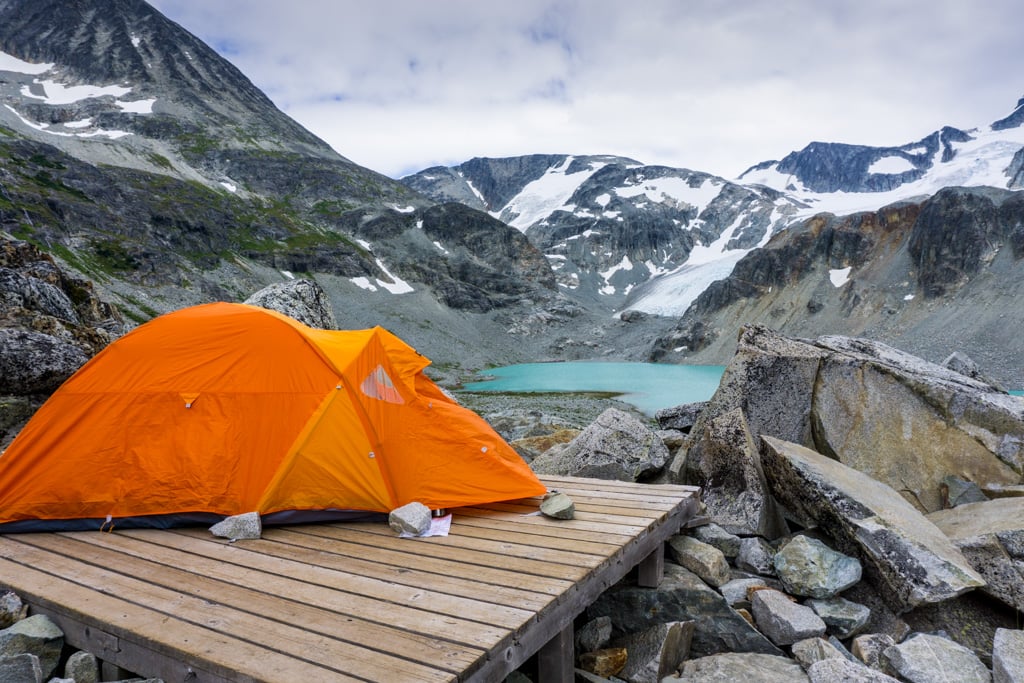
Ever since I discovered backpacking nearly 20 years ago, it’s been my favourite outdoor activity. Some of my most memorable backpacking trips have been close to home in British Columbia. So I put together a list of the best backpacking trips in BC .
If you’re going to take time off to go backpacking, you don’t want to waste it on sub-par hikes. All the trips on my list are vacation-worthy – you won’t mind travelling a bit to get there.
It includes the best backpacking trips near Vancouver , on Vancouver Island , and in Eastern BC including the Rocky Mountains . For each trip, I’ve got details on difficulty, duration, and distance, and planning tips including fees, reservations, and links to trail guides.
I’ve also made sure that there are trips for both beginners and experts , and lots in between. And there are trips to suit any vacation length with a few quick overnighters, lots of long weekend-length trips, and a few that stretch over a week.
A few of these trips require reservations, but most do not. Read my guides to BC backpacking reservation dates and tips for backpacking in BC without reservations for more info.
You can find more info about a lot of these hikes in my books Backpacking in Southwestern British Columbia and Backpacking on Vancouver Island .
Get My Books
Backpacking in Southwestern British Columbia and Backpacking on Vancouver Island
Discover BC’s best backpacking trips
- 40 backpacking trips within a few hours of Vancouver
- 35 backpacking trips and day hikes on Vancouver Island
- Info about permits, reservations, and campground facilities
- Detailed maps and photos
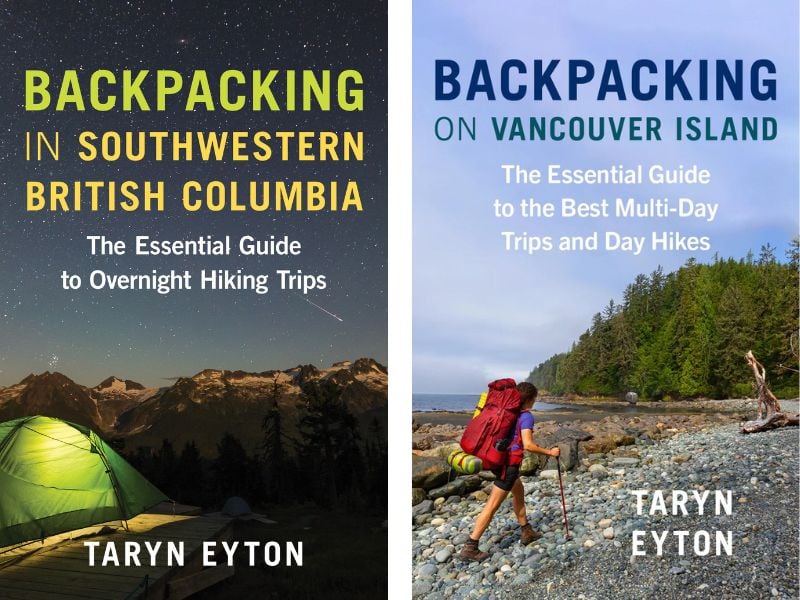
Here’s a handy map I made for you that shows the locations for each of my picks for the best backpacking trips in BC.

This is a sensitive wilderness area. Learn how to Leave No Trace to keep the wilderness wild. Make sure you are prepared by bringing the 10 Essentials . Get ready for adventure with this checklist of things to do before every hike .
Hey there: Some of the links in this post are affiliate links, which means I earn a small commission at no cost to you. Thanks for your support. -Taryn
Table of Contents
Best Backpacking Trips Near Vancouver
Howe sound crest trail.
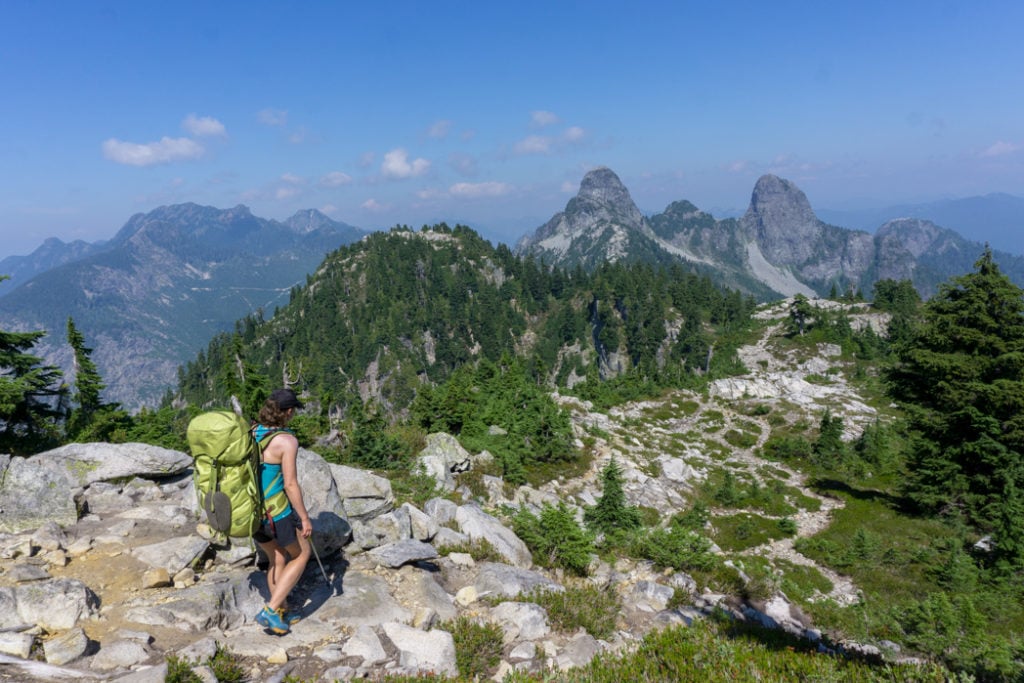
Duration: 2-4 days
Distance: 31.7 km traverse
Best Months: Mid-July to September
Difficulty: Very Challenging
Elevation Gain: 660 m
Fees and Reservations: None.
This very rough trail is more like a route in some places and requires occasional hands-on scrambling moves as you traverse a chain of rocky summits high above Howe Sound near Vancouver. If you’re up for the challenge, the views are worth it.
More Info: Find details on this hike in my book, Backpacking in Southwestern British Columbia .
Watersprite Lake
Duration: 2 days
Distance: 17 km round trip
Best Months: Mid-June to October
Difficulty: Moderate
Fees and Reservations: The hut requires reservations and costs $20/person/night. Advance reservations and fees are required for camping.
Watersprite Lake is an Instagram sensation thanks to its ice blue water and dramatic rock tower. We can credit the BC Mountaineering Club for building the trail to the lake along with a cabin and campground. I think it’s one of the best hikes in Squamish .
More Info: Find details on this hike in my book, Backpacking in Southwestern British Columbia . Make cabin reservations through the BCMC .
Get My Book…
Backpacking in Southwestern British Columbia
A one-stop resource for backpackers in beautiful British Columbia.
- Advice for extending your trip
- Points of cultural and natural history
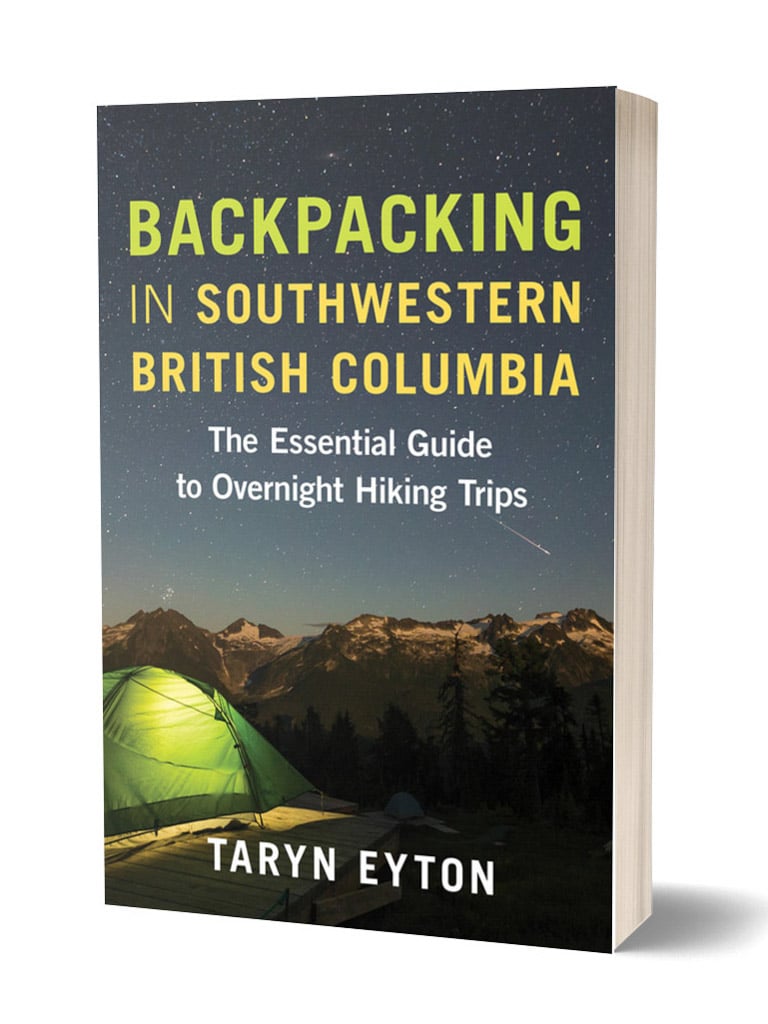
Elfin Lakes
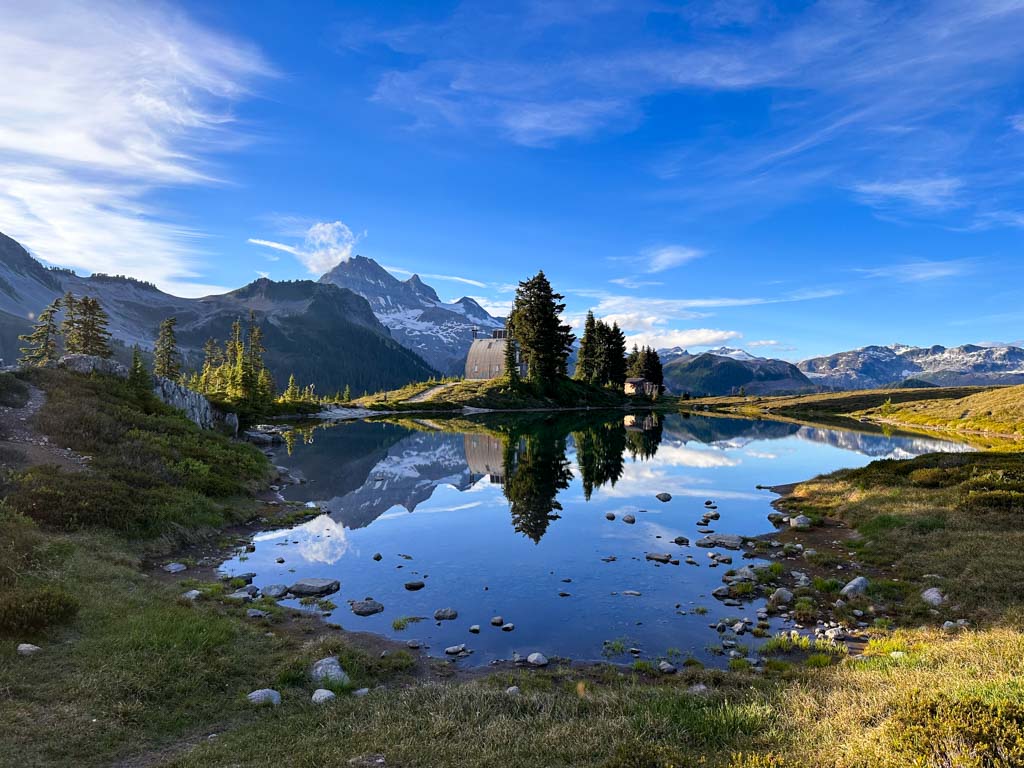
Heads up: Day passes are required at Garibaldi Lake in summer. However, if you have a backcountry camping reservation, you don’t need a day pass. Learn more in my guide to BC Parks day passes .
Duration: 2 to 4 days
Distance: 22 km round trip
Elevation Gain: 900 m
Best months: July to September
Fees and Reservations: Reservations are required and cost $6/night/tent pad. Camping fees are $10/person/night
Even though the hike to Elfin Lakes is on an old road, it’s worth doing since the views are so incredible. You can see Mount Garibaldi/Nch’kay and lots of glaciers. Its worth spending more than one night at the Elfin Lakes campground or Elfin Lakes Shelter to do some of the great day hikes.
More Info: Find details on this hike in my Elfin Lakes hiking guide and my book, Backpacking in Southwestern British Columbia . For info on reservations, see Garibaldi Provincial Park .
Garibaldi Lake
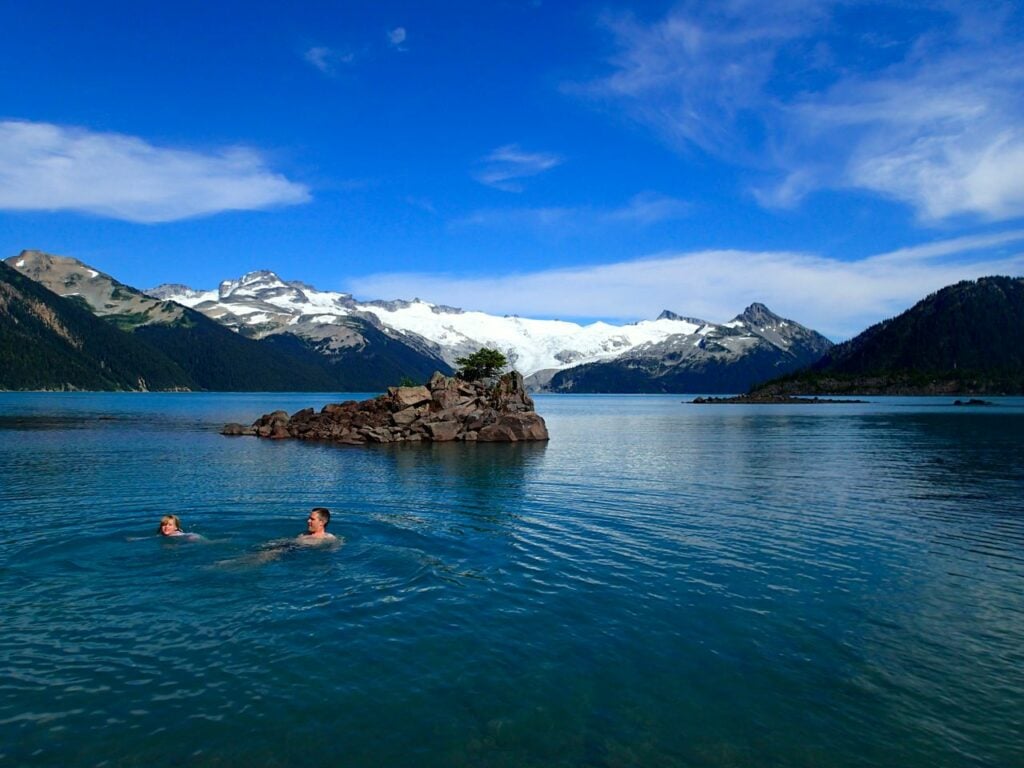
Distance: 18 km round trip
Best Months: July to September
Located just north of Squamish, Garibaldi Lake is one of the most popular backpacking trips in BC. But it’s also one of the most picturesque with tumbling glaciers, alpine meadows, and unique volcanic geology. From the lake, you can tackle incredible day hikes like Black Tusk and Panorama Ridge.
More Info: Find details on this hike in my book, Backpacking in Southwestern British Columbia . For info on reservations, see Garibaldi Provincial Park .
READ NEXT: How to Make Backcountry Camping Reservations in BC
Russet Lake
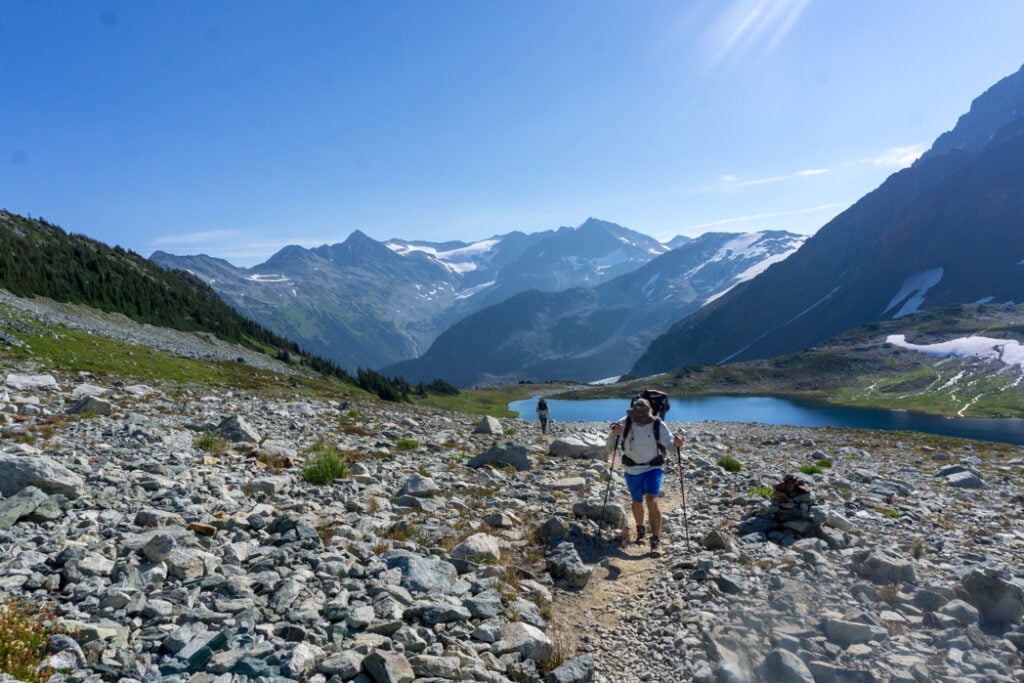
Distance: 25 to 29 km round trip
Difficulty: Challenging
Elevation Gain: 305 to 1280 m
Fees and Reservations: Reservations are required and cost $6/night/tent pad. Camping fees are $10/person/night. Hut fees are $50/person/night.
Nestled into the mountains above Whistler, Russet Lake is home to a backcountry campground and a luxurious new hut. There are two ways to get there: a steep trail from the village or an undulating traverse across mountain summits from the top of the Whistler Gondola via the High Note Trail .
More Info: Find details on this hike in my book, Backpacking in Southwestern British Columbia . For camping reservations, see Garibaldi Provincial Park . For hut reservations, see the Spearhead Huts Society .
Psst! You can get to this hike without a car! It’s on my list of car-free backpacking trips in BC .
READ NEXT: 2023 BC Backpacking Reservation Dates You Need to Know
Wedgemount Lake
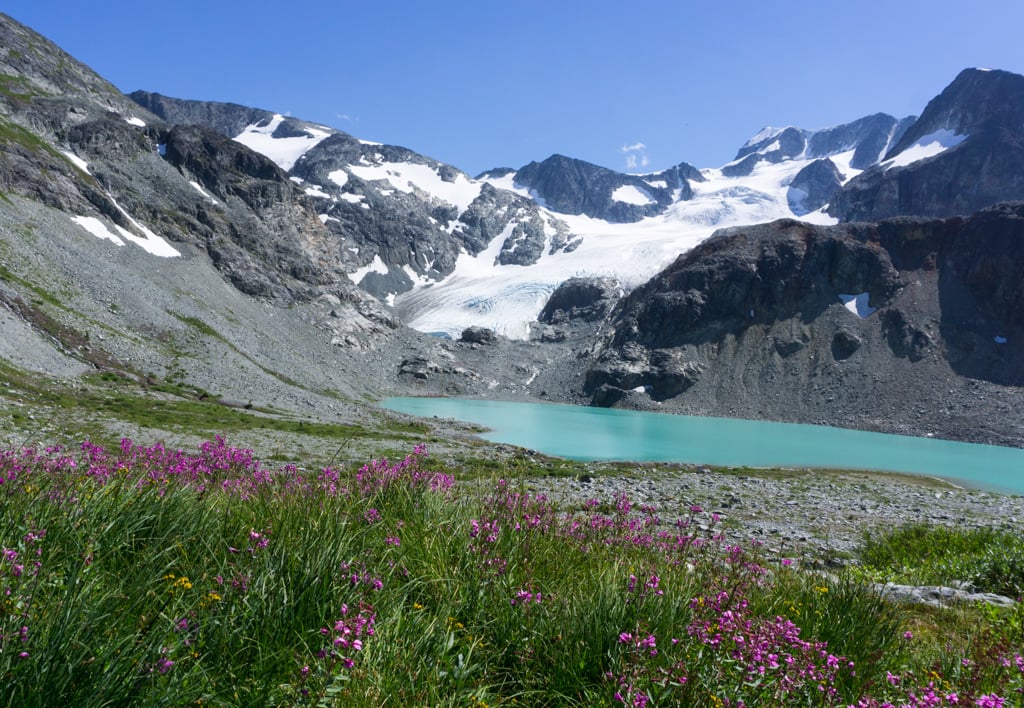
Distance: 13 km round trip
Elevation Gain: 1160 m
The hike to Wedgemount Lake is punishingly steep. But at the top, you’ll enjoy a gorgeous lake ringed with summits. Hike beyond the far end of the lake to touch a glacier, which has retreated an alarming 400 m in less than 30 years.
Join the Backpacking in BC Facebook Group
Joffre Lakes

Heads up: Day passes are required at Joffre Lakes in summer. However, if you have a backcountry camping reservation, you don’t need a day pass. Learn more in my guide to BC Parks day passes .
Distance: 10 km round trip
Best Months: Late June to early October
Elevation Gain: 320 m
Fees and Reservations: Reservations are required and cost $6/night/tent pad. Camping fees are $5/person/night.
The chain of three Joffre Lakes near Pemberton make up one of the Vancouver area’s most popular day hikes. But leave the day-time crowds behind by scoring a coveted reservation to camp at the Upper Lake. Listen for chunks of glacier crashing down the rocks on warm days. This is also one of my picks for the best easy backpacking trips in BC .
More Info: Find details on this hike in my Joffre Lakes hiking guide and my book, Backpacking in Southwestern British Columbia . For info on reservations, see Joffre Lakes Provincial Park .
READ NEXT: How to Go Backpacking in BC Without Reservations
Sunshine Coast Trail
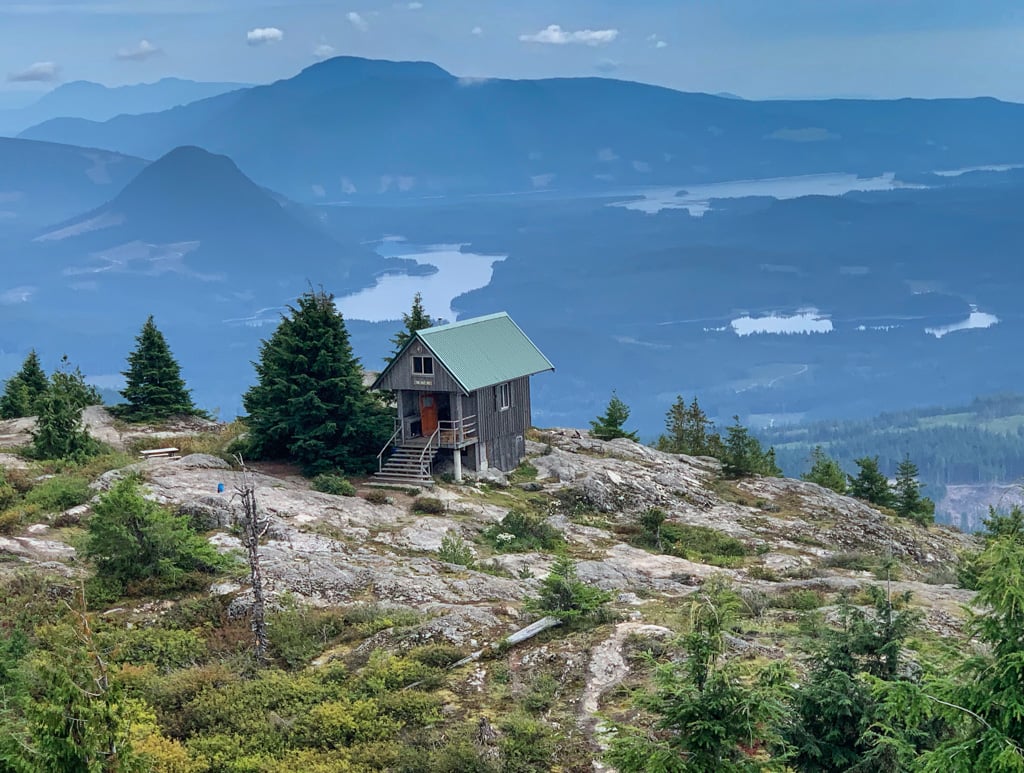
Duration: 8-14 days
Distance: 180 km traverse
Best Months: Late May to October
Elevation Gain: 1305 m
The Sunshine Coast Trail winds through the forests along the length of the upper Sunshine Coast near the town of Powell River. Hike by the ocean, through old-growth forest, and across mountain tops, staying in rustic backcountry huts along the way.
More Info: Find details on shorter backpacking trips you can do on sections of the SCT in my book, Backpacking in Southwestern British Columbia . For full details on the trail, pick up a copy of The Sunshine Coast Trail Guide Book by R. E. Walz or visit the Sunshine Coast Trail website .
Psst! Some sections of the Sunshine Coast Trail are hikeable all year and made my list of the best spring backpacking trips in British Columbia .
READ NEXT: Backcountry Huts in British Columbia and the Canadian Rockies
HBC Heritage Trail
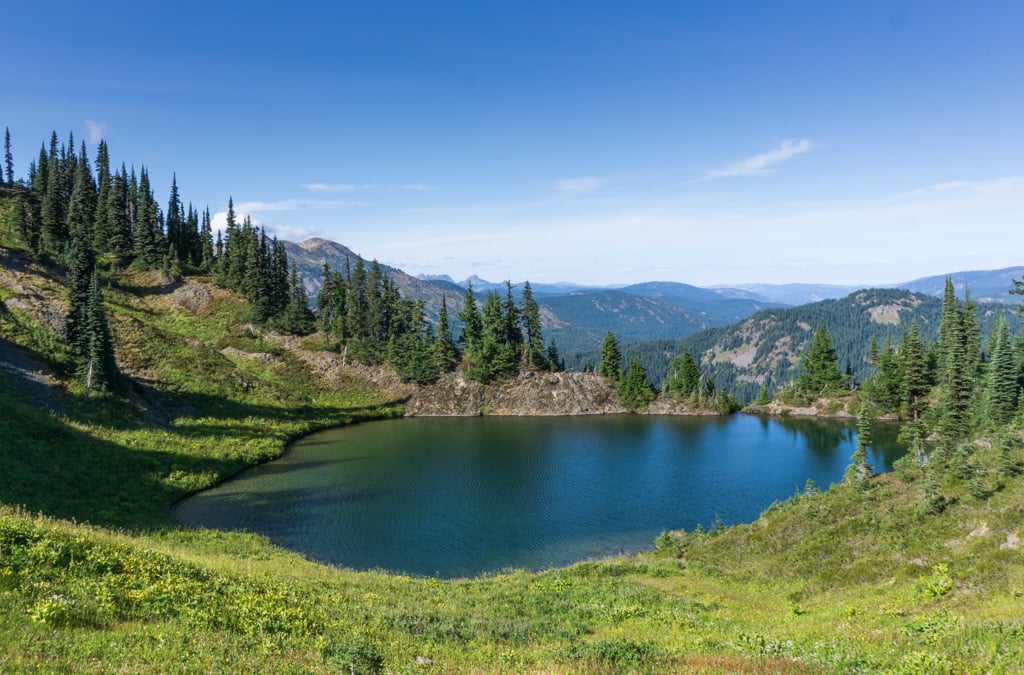
Duration: 4-6 days
Distance: 74 km traverse
Elevation Gain: 1525 m
The HBC Heritage Trail traces a historic route through the Cascade Mountains followed by fur traders during the 1840s and 50s from Hope to Tulameen. Info panels along the way explain settler and Indigenous history. This trail is not well-known, making it one of the quieter hikes on this list of the best backpacking trips in BC.
More Info: Find details on shorter backpacking trips you can do on sections of the HBC Heritage Trail in my book, Backpacking in Southwestern British Columbia . For full details on the trail, pick up a copy of The HBC Trail Book and the HBC Topo Map , or visit the HBC Heritage Trail website .
Heather Trail

Duration: 2 to 5 days
Distance: 45 km round trip
Best Months: July to mid-September
Fees and Reservations: Camping fees are $5/person/night. The Buckhorn and Kicking Horse campgrounds requires reservations. Nicomen Lake Campground is first-come, first-served
This is Manning Park’s signature trail. With a start high in the alpine, you stay above treeline in meadows of wildflowers for nearly the entire length. Take a side trip to summit Three Brothers Mountain and dip in chilly Nicomen Lake.
More Info: Find details on this hike in my book, Backpacking in Southwestern British Columbia . For info on camping fees, see Manning Provincial Park .
Frosty Mountain

Duration: 2 to 3 days
Distance: 14 km round trip
Best Months: July to early October
Elevation Gain: 670 m
Fees and Reservations: Camping fees are $5/person/night. Reservations are required between late July and late October.
Ascend the highest mountain in Manning Park for panoramic views. Break up your hike by camping at Frosty Creek camp. Plan your visit for fall when the larch tree needles turn golden.
More Info: Find details on this hike in my book, Backpacking in Southwestern British Columbia , and my Frosty Mountain trail guide . For info on camping fees, see Manning Provincial Park .

BC Backpacking in Your Inbox!
Sign up to receive a bi-monthly newsletter from Taryn at Happiest Outdoors stuffed with the latest on backpacking in BC including:
- conditions reports,
- reservation dates,
- seasonal trip recommendations,
- gear deals,
- backpacking news,
- and lots more!
You can unsubscribe anytime. For more details, review our Privacy Policy.
You have successfully signed up for the Backpacking in BC newsletter. Go check your email to read your welcome message!
Best Backpacking Trips on Vancouver Island
Juan de fuca trail.
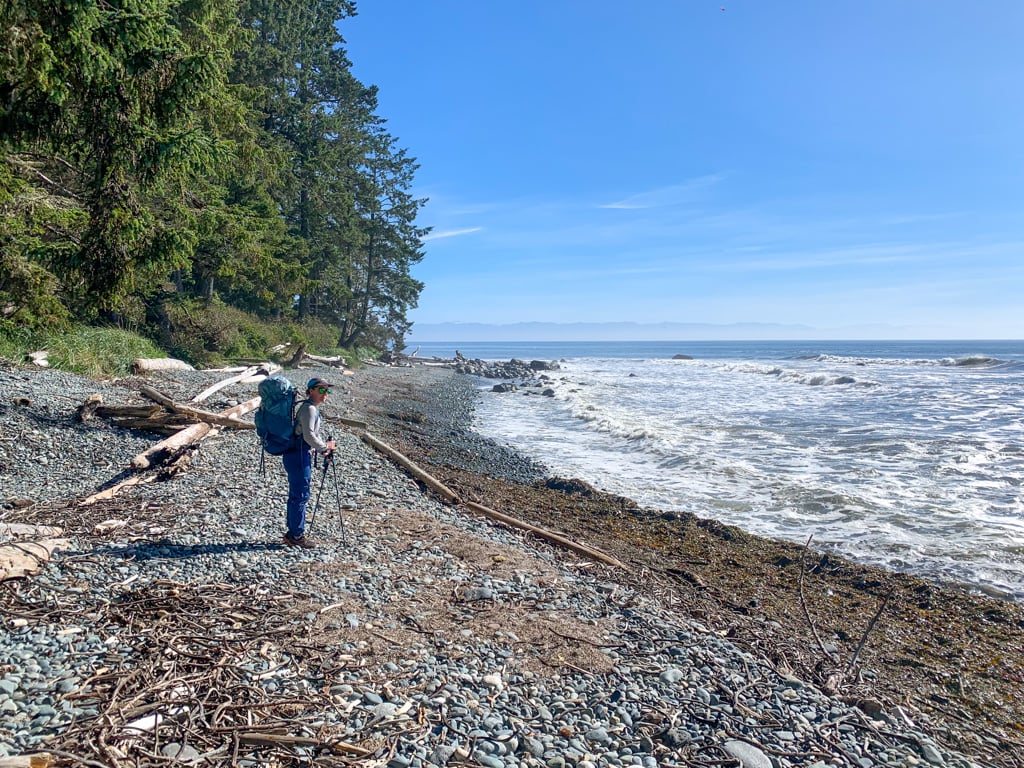
Duration: 3 to 5 days
Distance: 47 km
Best Months: May to October
Elevation Gain: 190 m
Fees and Reservations: Camping costs $10/person/night. All campsites are first-come, first-served.
This gorgeous coastal trail is easier to access than the West Coast Trail thanks to first-come, first-served camping and trailheads close to Victoria. But the hike is just as challenging and spectacular, making it easy to include on a list of the best backpacking trips in BC.
More Info: Get details on this hike in my Juan de Fuca Trail guide and my book, Backpacking on Vancouver Island . For info on camping fees, see Juan de Fuca Provincial Park .
Did you know? The Juan de Trail is hikeable all year and made my list of the best spring backpacking trips in British Columbia .
West Coast Trail
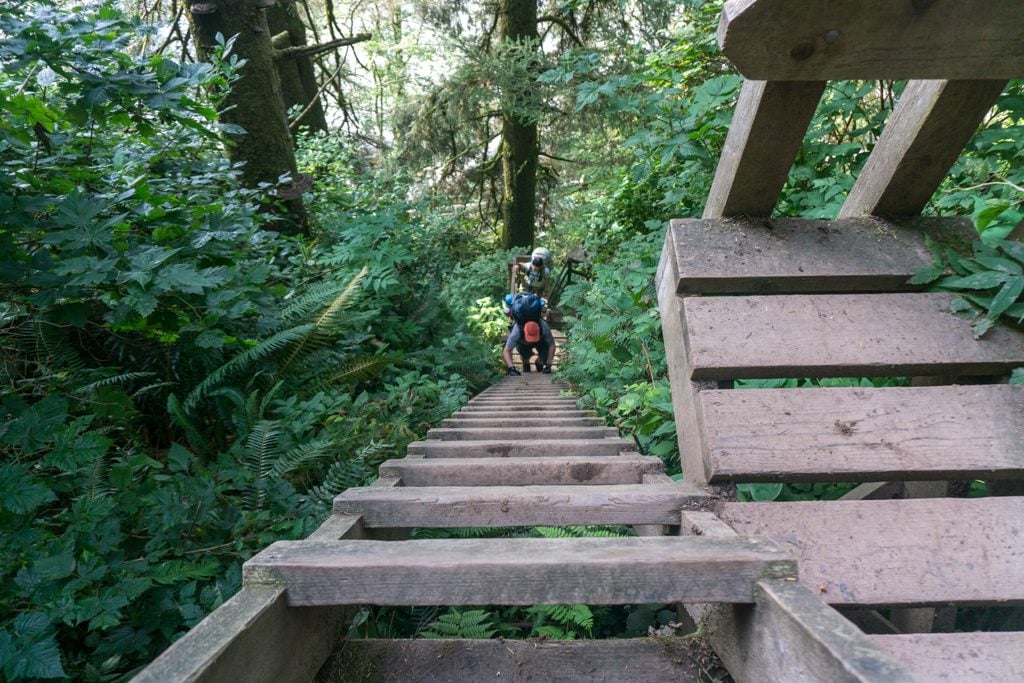
Duration: 5-8 days
Distance: 75 km
Best Months: June to September
Elevation Gain: 225 m
Fees and Reservations: Reservations are required and cost $25.75. Trail fees are $180. You will also need to pay National Park entry fees of $10/person/day.
The West Coast Trail is Canada’s premier multi-day backpacking trip. It follows the wild coastline for 75 kilometres, up and down ladders, across cable cars, through mud holes, and along beautiful beaches as it travels between the isolated towns of Port Renfrew and Bamfield.
More Info: Get details on this hike in my West Coast Trail guide and my book, Backpacking on Vancouver Island . For reservation info, see Pacific Rim National Park.
Psst! The West Coast Trail opens in May and made my list of the best spring backpacking trips in British Columbia . AND… You can get to this hike without a car! It’s on my list of car-free backpacking trips in BC .
Della Falls Trail

Duration: 2-5 days
Distance: 32 km round trip
Best Months: Mid-May to September
Elevation Gain: 540 m
Fees and Reservations: None
Della Falls is one of the tallest waterfalls in BC at 440 m tall. (Some sources claim it’s the tallest waterfall in Canada, but that’s not true.)
The hike starts with a boat trip across Great Central Lake. From there you hike up a river valley to the base of the falls. Allow time for the 6 km side trip to Love Lake where there is an incredible view of the entire waterfall from above.
More Info: Get all the details in my Della Falls Trail guide and my book, Backpacking on Vancouver Island . Join the Della Falls Facebook group for the latest trail conditions.
Backpacking on Vancouver Island
Discover Vancouver Island’s best day hikes and overnight trips
- 25 backpacking trips and 10 day hikes throughout Vancouver Island
- Info about permits, reservations and campground facilities
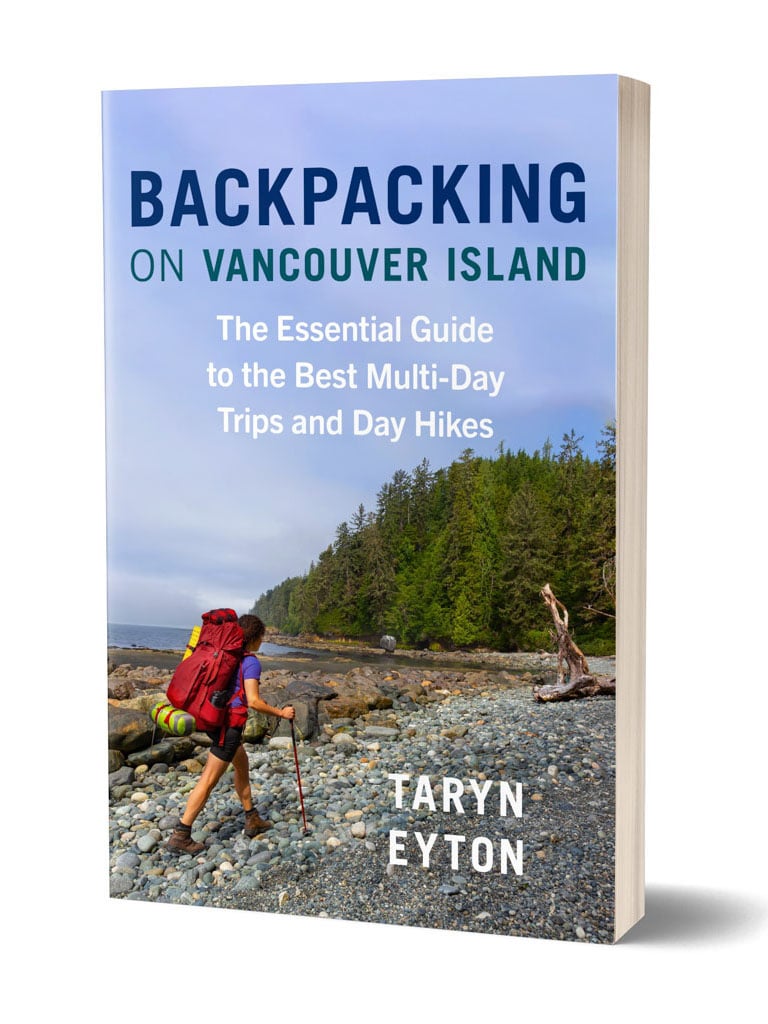
Wild Side Trail
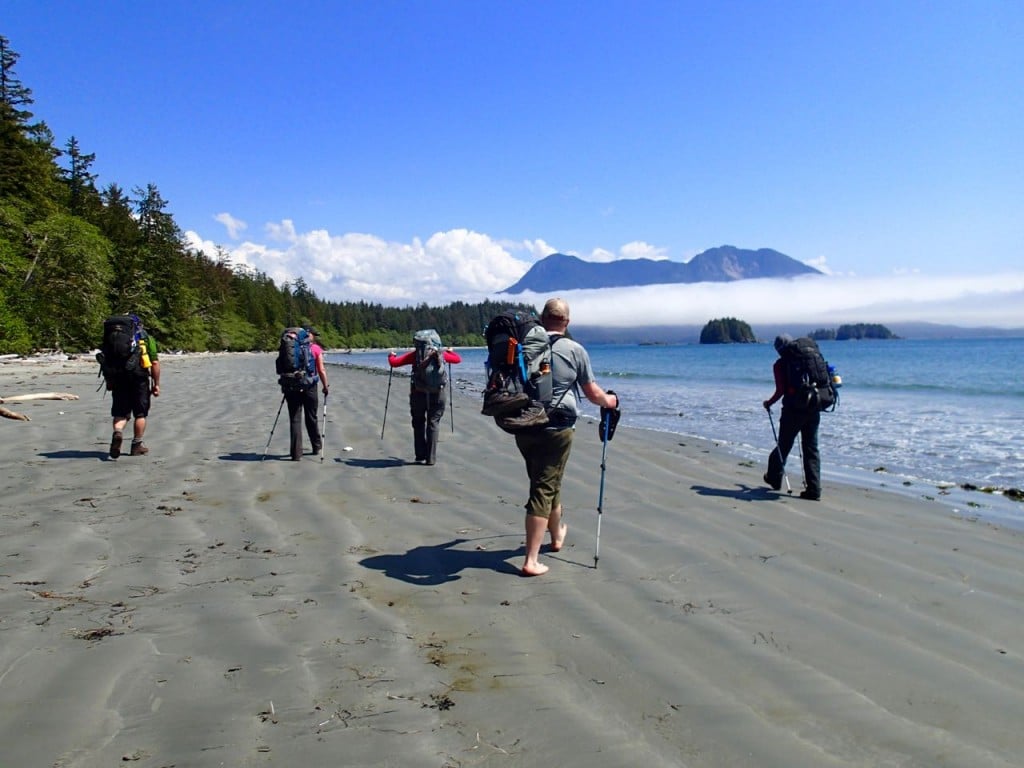
Difficulty: Easy
Elevation Gain: None
Fees and Reservations: Trail fees are $15/person/day.
This trail takes you along the shoreline of Flores Island in Ahousaht First Nation territory. Most of the hike is along incredible sandy beaches. The trail is a short water taxi ride from Tofino. This off-the-beaten-path hike doesn’t get many visitors, making it one of the quietest hikes on this list of the best backpacking trips in BC.
More Info: Get details on this hike in my Wild Side Trail guide and my book, Backpacking on Vancouver Island .
Heads up! The Wild Side Trail opens in May and made my list of the best spring backpacking trips in British Columbia AND my list of the best easy backpacking trips in BC . PLUS… You can get to this hike without a car! It’s on my list of car-free backpacking trips in BC .
Lake Helen Mackenzie Loop
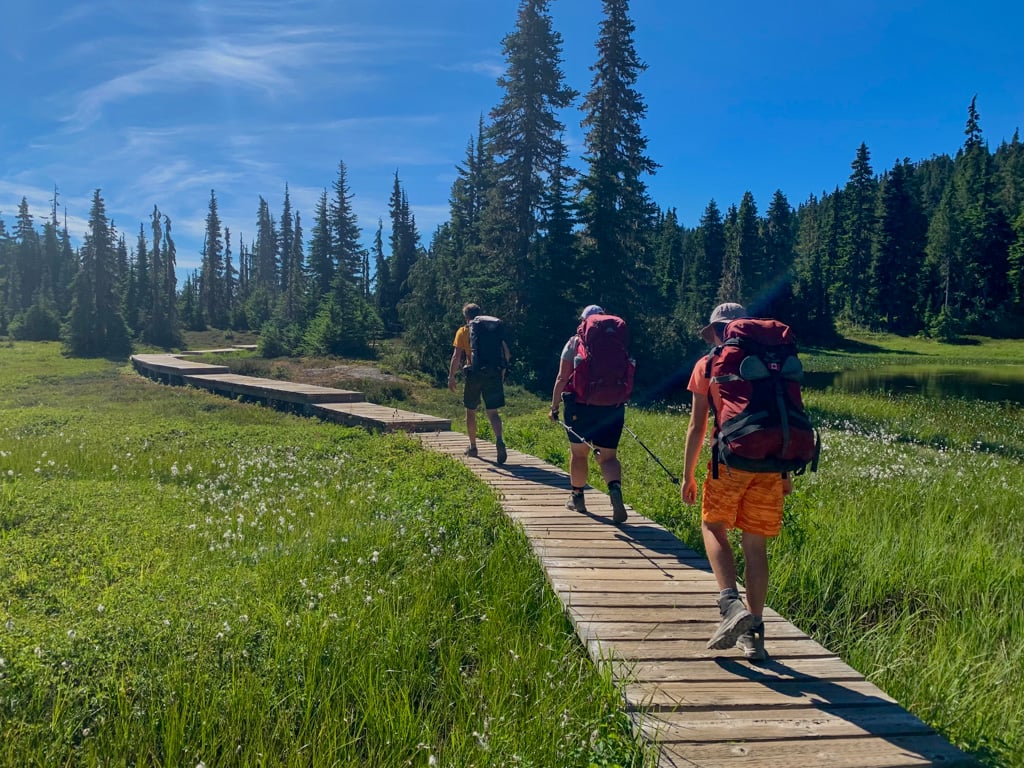
Distance: 8 to 15 km loop
Fees and Reservations: Camping fees are $10/person/night. All campsites are first-come, first-served.
This beginner-friendly loop starts high in the alpine of Strathcona Provincial Park at Mount Washington ski area, which means there is little elevation gain. Two different loop trips are possible, each with its own lakeside campground. This trip made my list of the best easy backpacking trips in BC .
More Info: Get details on this hike in my book, Backpacking on Vancouver Island . See Strathcona Provincial Park for trail info and camping fees.
Read next: Backpacking for Beginners: Tips for Getting Started
Circlet Lake and Mount Albert Edward
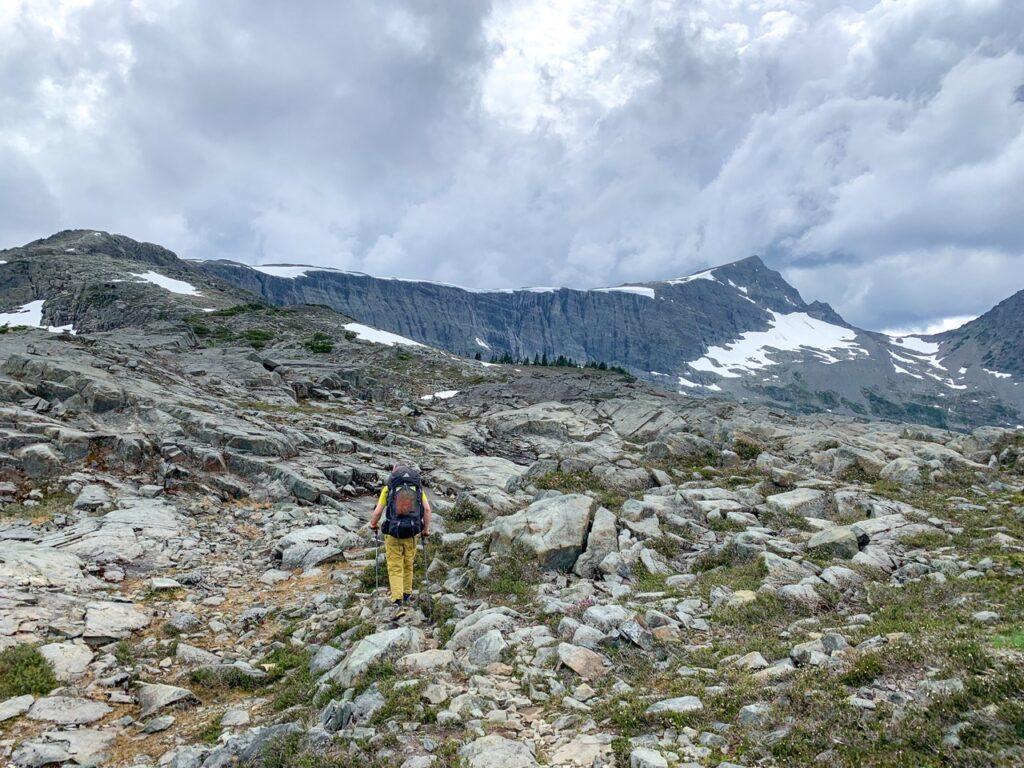
Distance: 31 km round trip
Elevation Gain: 980 m
Summit Mount Albert Edward, one of the highest peaks on Vancouver Island. On the way, you’ll stay at tiny Circlet Lake. This Strathcona Provincial Park trip also starts at Mount Washington and is a rite of passage for many Vancouver Island hikers.
Bedwell Lakes
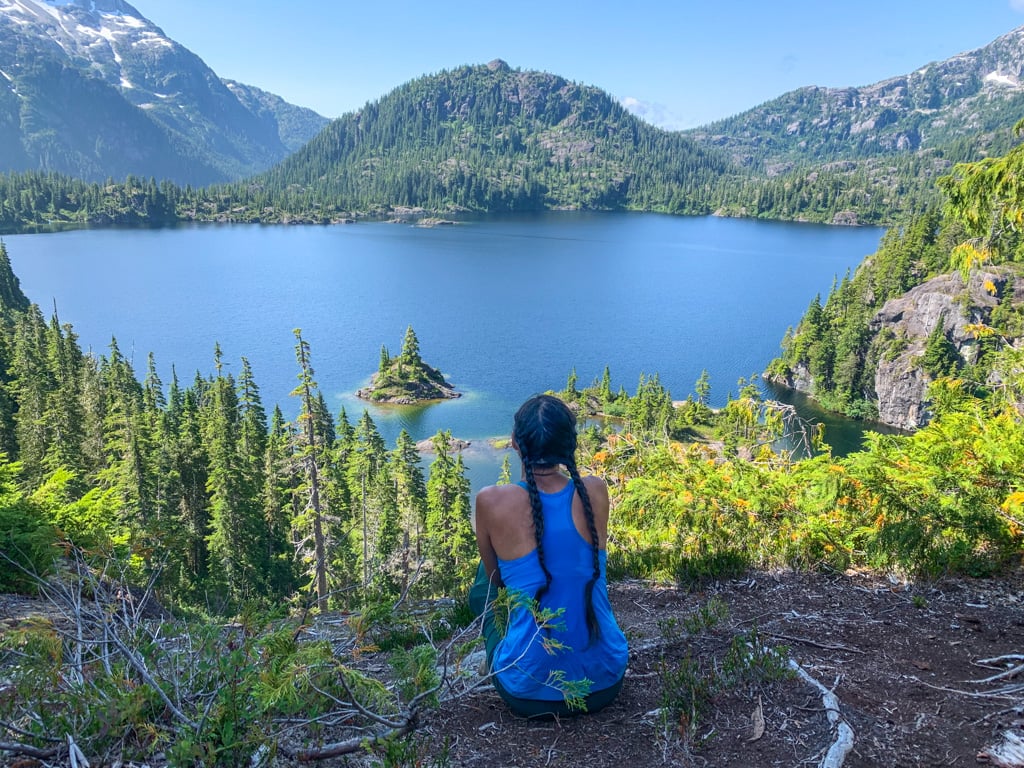
Elevation Gain: 850 m
Climb steeply up through the forest to emerge on the granite shores of Bedwell and Baby Bedwell Lakes, each with their own campground. Intrepid hikers can continue to isolated Cream Lake, which makes a great day trip destination. The trailhead is in a remote area near Buttle Lake in Strathcona Provincial Park.
Elk River Trail

Elevation Gain: 640 m
Follow the trail through a beautiful forest alongside the shady Elk River Trail to its terminus at picturesque Landslide Lake and great views of Mount Colonel Foster. There are two campgrounds along the river to choose from. Find the trailhead along the highway to Gold River.
Nootka Trail
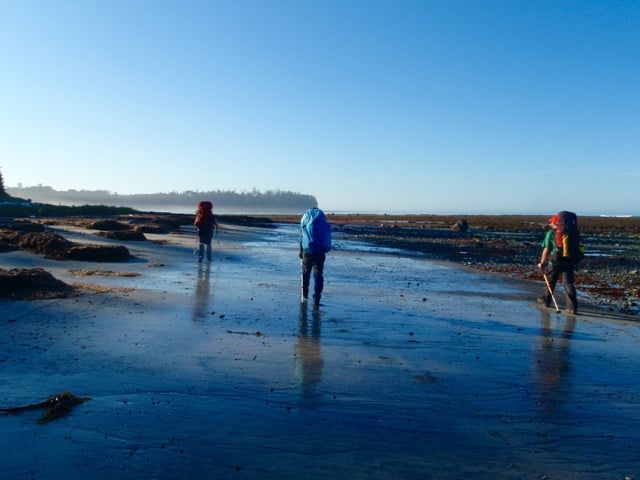
Distance: 35 km traverse
Arrange a water taxi or floatplane to shuttle you to the Nootka Trail on Nootka Island near Gold River. It’s a remote coastal hike that sees few visitors but has incredible scenery. Highlights include sandy beaches, wolf sightings, Calvin Falls, and the tiny Mowachaht First Nation village of Yuquot.
More Info: See my trip report from my Nootka Trail hike . Get details on this hike in my book, Backpacking on Vancouver Island .
Did you know? The Nootka Trail made my list of the best spring backpacking trips in British Columbia .
Tatchu Trail
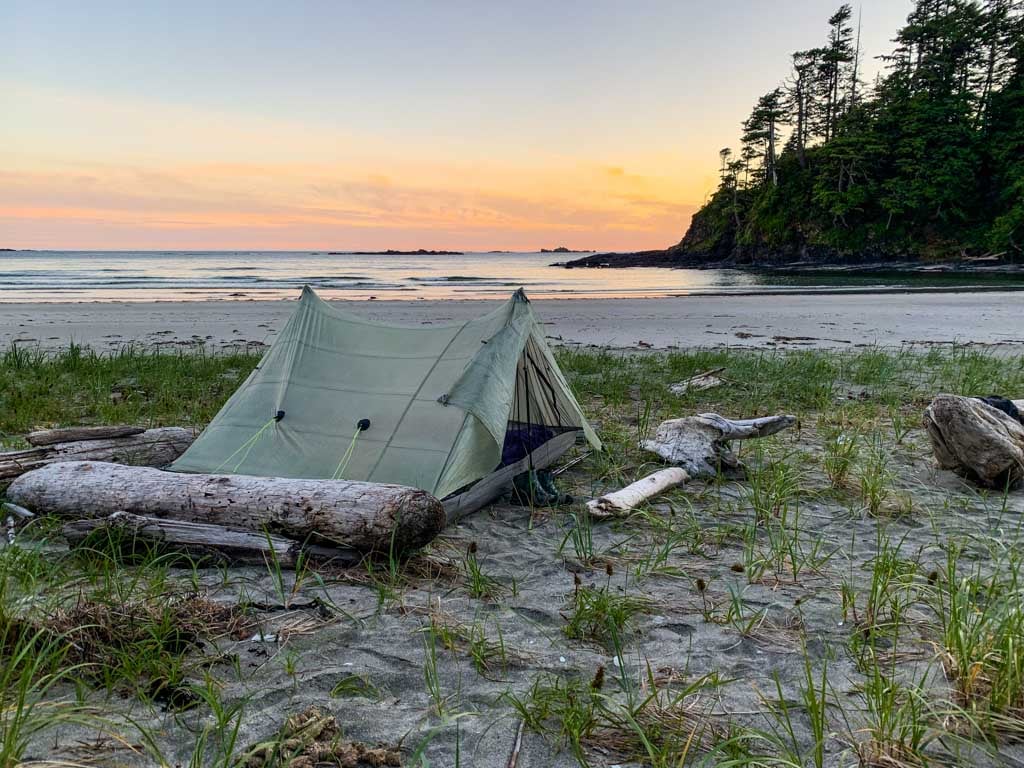
Duration: 3 to 4 days
Distance: 20-40 km (traverse or out-and-back)
Difficulty: Moderate/Very Challenging
Elevation Gain: 30 m
The Tatchu Peninsula is a wilderness hike on the west coast of Vancouver Island. The hike traces a route down the west side of the peninsula, linking numerous beaches with short overland trails. There are no formal facilities or campsites. You can do the easier (and more scenic) northern section as an out-and-back or complete a very challenging traverse.
More info: See my Tatchu Trail guide and my book, Backpacking on Vancouver Island .
North Coast Trail

Duration: 4 to 5 days
Distance: 43 to 59 km traverse
Best Months: May to September
Elevation Gain: 240 m
The rough and rugged trail follows the coastline around the northern tip of Vancouver Island. Start with a water taxi from Port Hardy, then get ready for lots of mud, steep hills with rope assists, and rocky beaches.
More Info: Get details on this hike in my North Coast Trail guide and my book, Backpacking on Vancouver Island . Join the Cape Scott Park Facebook group for the latest trail conditions. For camping fee info, see Cape Scott Provincial Park .
Psst! The North Coast Trail is a great destination between May and September, so it made my list of the best spring backpacking trips in British Columbia AND… You can get to this hike without a car! It’s on my list of car-free backpacking trips in BC .
Cape Scott Trail

Duration: 3 days
Elevation Gain: 100 m
Follow an old settler’s route through the muddy forest to the wild beaches at the north end of Vancouver Island. Choose from several campsites on sandy beaches, then day hike out to the Cape Scott Lighthouse.
More Info: Get details on this hike in my Cape Scott Trail guide and my book, Backpacking on Vancouver Island . Join the Cape Scott Park Facebook group for the latest trail conditions. For camping fee info, see Cape Scott Provincial Park .
Check it out: The Cape Scott Trail is hikeable all year, so it made my list of the best spring backpacking trips in British Columbia AND… You can get to this hike without a car! It’s on my list of car-free backpacking trips in BC .
Best Backpacking Trips in Eastern BC and the Rocky Mountains
Okanagan high rim trail.
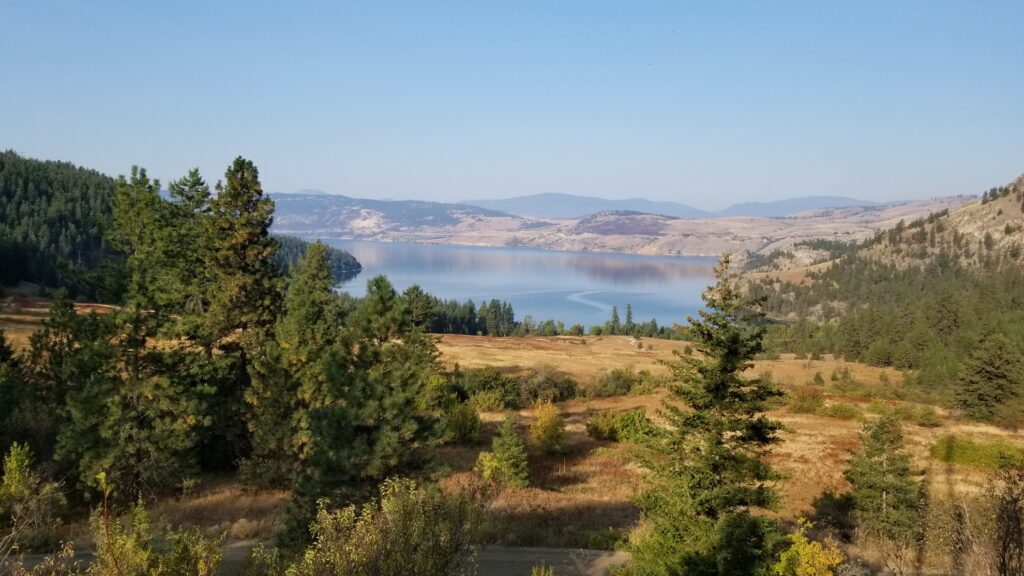
Distance: 58 km traverse
Best Months: Late-April to October
Difficulty: Moderate/Challenging
Elevation Gain: 800 m
This is one of the newest backpacking trips in BC. It follows a high route along a ridge top between Vernon and Kelowna. Along the way, you’ll pass by numerous viewpoints where you can look down to Kalamalka Lake and Okanagan Lake.
More Info: Get the details from the Okanagan High Rim Trail Association .
Did you know? The Okanagan HighRim Trail made my list of the best spring backpacking trips in British Columbia AND… You can get to this hike without a car! It’s on my list of car-free backpacking trips in BC .
Spectrum Lake
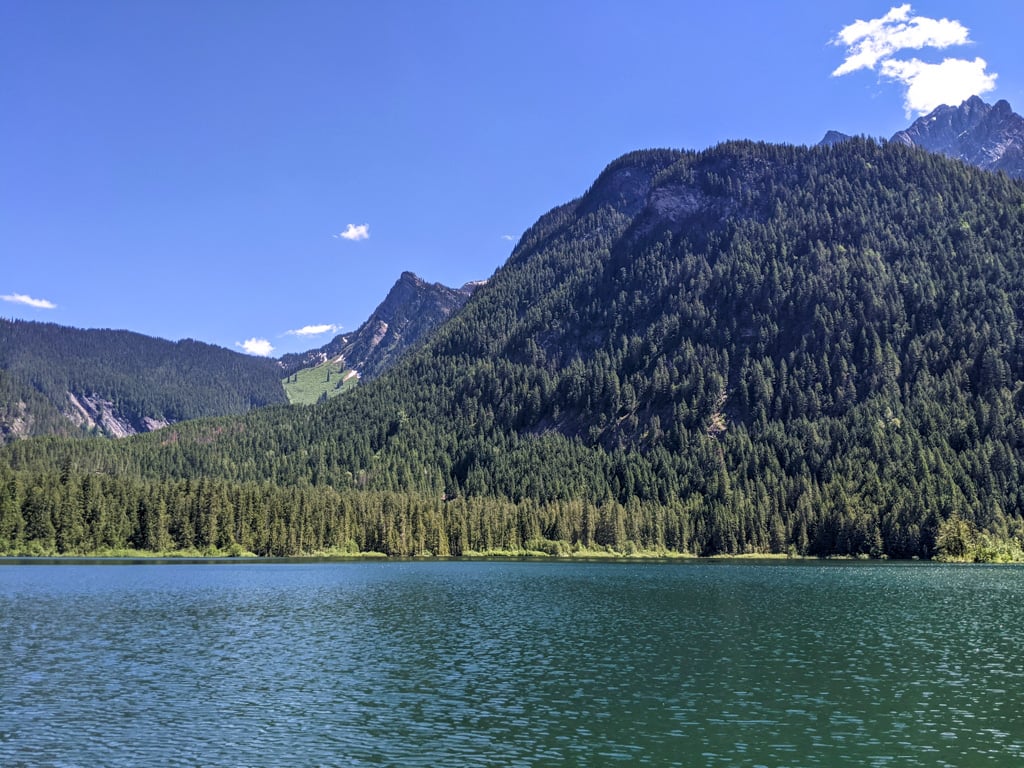
Distance: 12 km round trip
Best Months: June to October
Elevation Gain: 209 m
Fees and Reservations: Camping fees are $5/person/night. All campsites are first-come, first-served.
This pretty lake sits deep in Monashee Provincial Park near Cherryville in the Okanagan. It’s a short and easy hike, perfect for beginners and families. The lake is nestled between forested peaks and has a dock for swimming. It’s on my list of the best easy backpacking trips in BC .
More Info: Get the details from my friend Gemma’s Spectrum Lake trail guide . For info on camping fees, see Monashee Provincial Park .
Gwillim Lakes
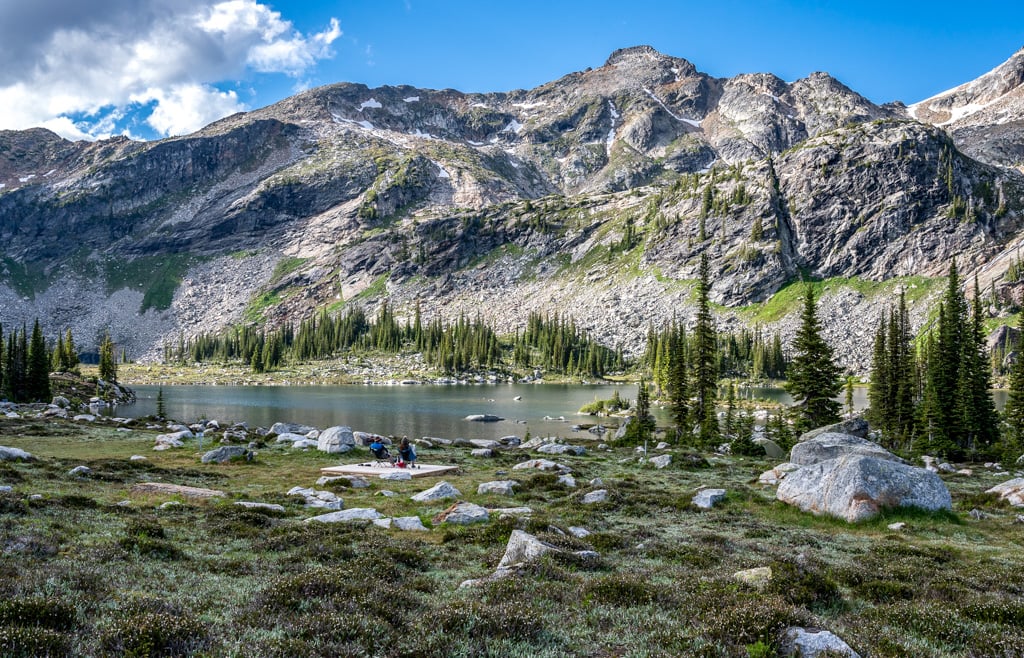
Best Months: Mid-July to late September
Elevation Gain: 890 m
These spectacular lakes are located in Valhalla Provincial Park in the Kootenays above the Slocan Valley. There are several backcountry campgrounds at Gwillim Lakes and nearby Drinnon Lake. The alpine terrain makes for incredible views.
More Info: Get the details from my friend Leigh’s Gwillim Lakes trail guide .
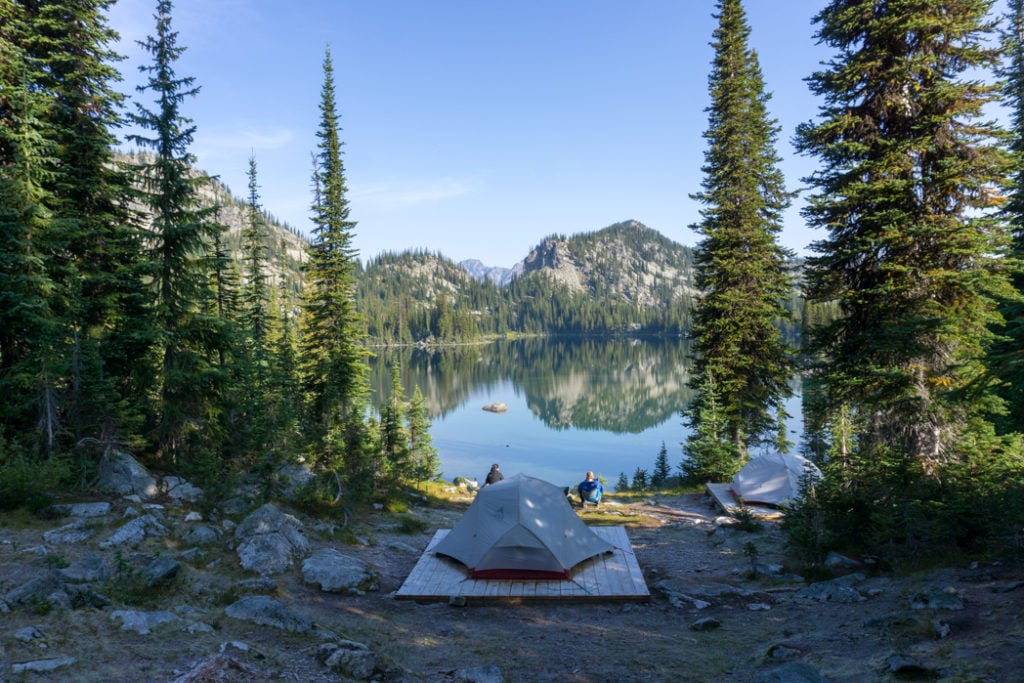
Best Months: mid-July to late September
Elevation Gain: 580 m
Fees and Reservations: Camping fees are $10/person/night. All campsites are first-come, first-served. Cabin rental is $350/night.
Hike into the backcountry of Kokanee Glacier Provincial Park near Nelson to camp next to Kaslo Lake. Follow beautiful trails through the alpine to viewpoints and peaks. You can also book the palatial Kokanee Glacier Cabin nearby.
More Info: See Kokanee Glacier Provincial Park for trail info and camping fees. See the Alpine Club of Canada for cabin reservations.
Eva and Jade Lakes
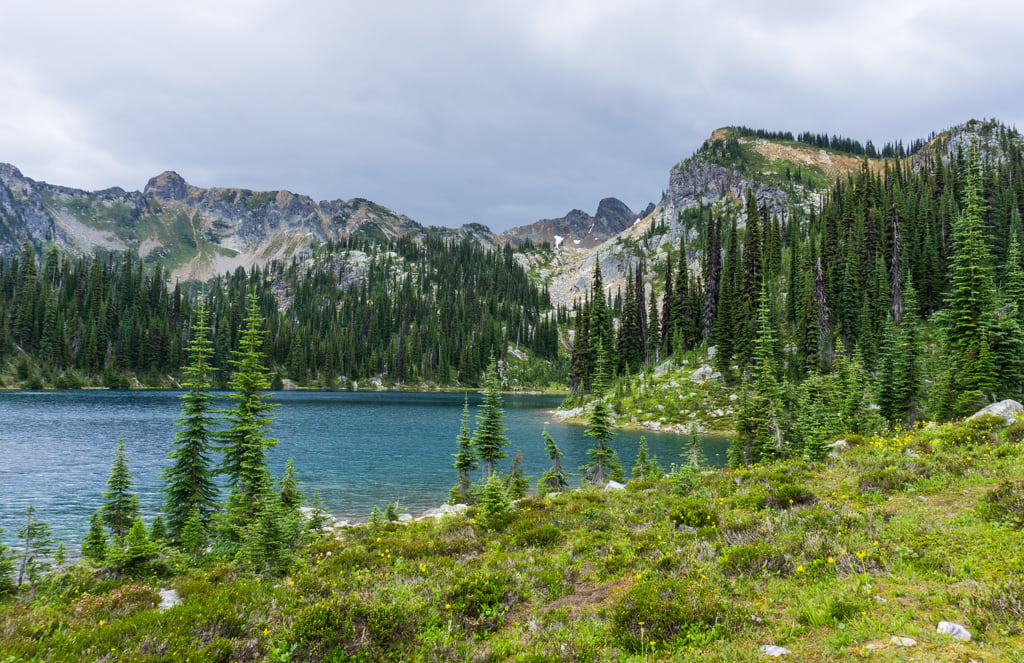
Distance: 12 to 18 km round trip
Elevation Gain: 180-430 m
Fees and Reservations: Reservations required. Camping fees are $10/person/night. You will also need to pay National Park entry fees of $10/person/day.
This alpine hike is easily accessible thanks to the paved Meadows in the Sky Parkway at Mount Revelstoke National Park. Walk through the alpine to a beautiful campsite on the shores of Eva Lake, an easy distance for beginners and made my list of beginner-friendly backpacking trips in BC . If you want more solitude, head over a pass to Jade Lake.
More Info: Get the details in my Mount Revelstoke National Park guide . See Mount Revelstoke National Park for reservations.
Hermit Meadows Trail

Elevation Gain: 819 m
This steep trail in Glacier National Park climbs relentlessly from the Trans-Canada Highway near Rogers Pass. It tops out in a spectacular alpine bowl with meadows and a great view.
More Info: Get the details in my Revelstoke hiking trails guide . See Glacier National Park for reservations.
Mount Assiniboine
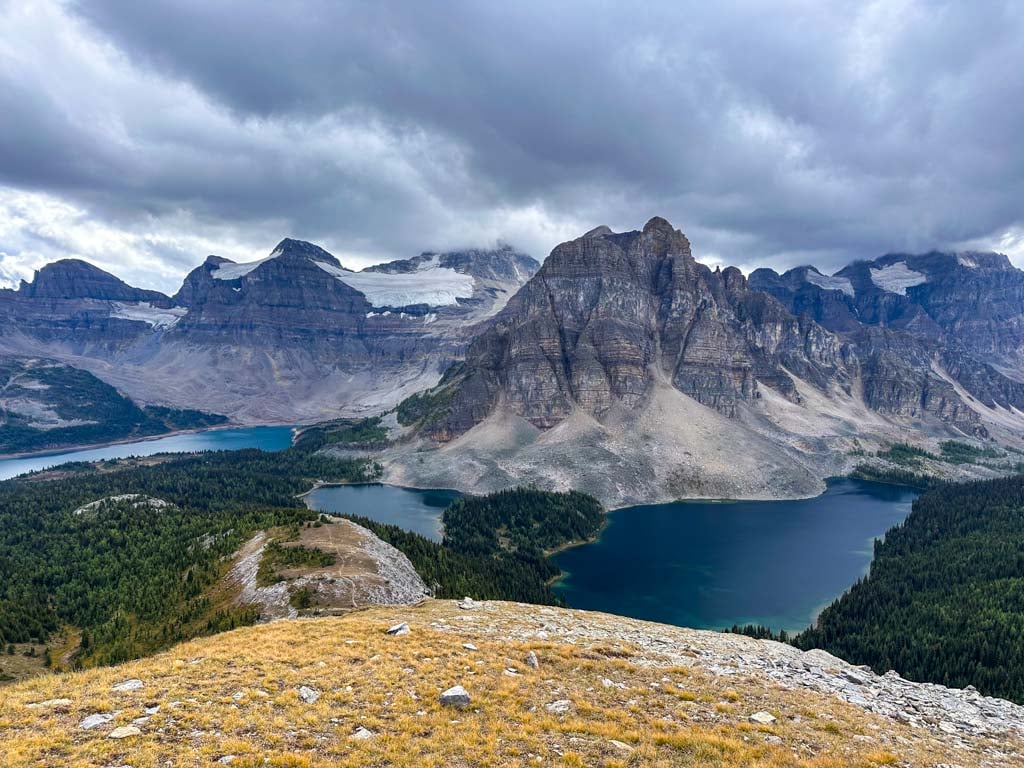
Duration: 4 to 6 days
Distance: 52 to 55 km round trip
B est Months: Mid-July to mid-September
Elevation Gain: 430-480 m
Fees and Reservations: Reservations and fees are required to camp in the park through BC Parks and to camp on the access trails through Banff National Park.
The scenery at Mount Assiniboine is postcard-worthy, but getting there can be a challenge. The hike itself is long, but not too difficult and the camping at Lake Magog is gorgeous. But it requires reservations in both a BC Park and Banff National Park, which can be tough to arrange.
More Info: See my huge Mount Assiniboine hiking guide for trail info and reservation strategies. See Mount Assiniboine Provincial Park for reservations. See Banff National Park for reservations to camp on the access trails on the way to Assiniboine. Join the Mount Assiniboine Facebook group .
Psst! You can get to this hike without a car! It’s on my list of car-free backpacking trips in BC . It’s also on my list of the best backpacking trips in the Canadian Rockies .
Rockwall Trail
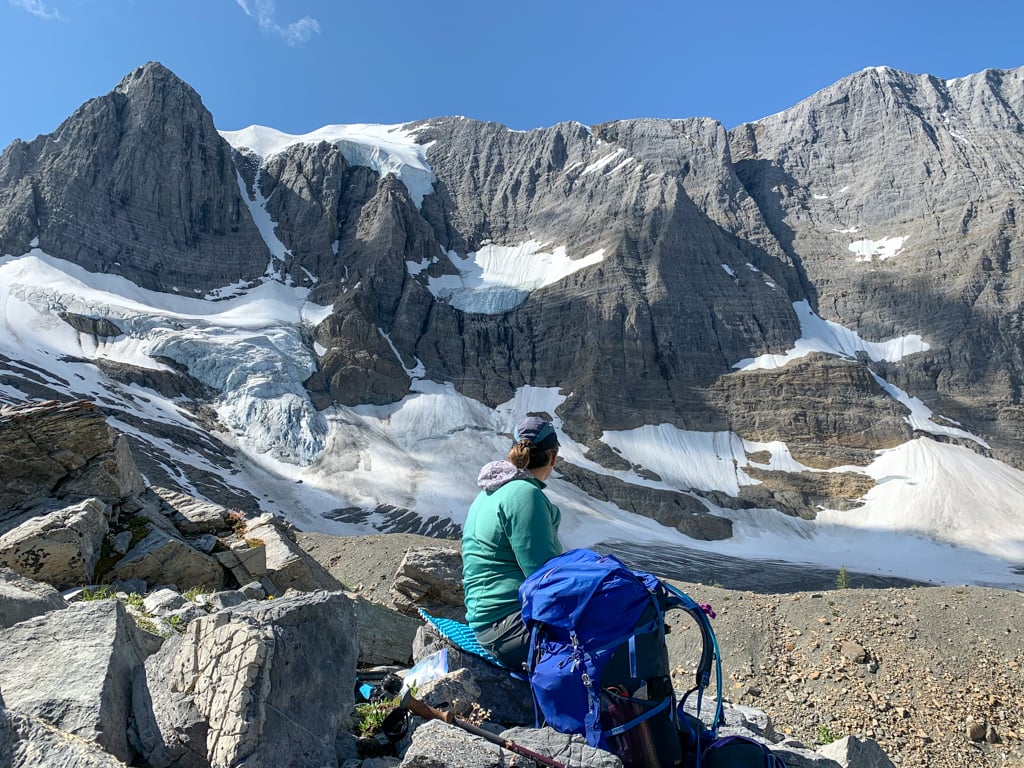
Distance: 55 km traverse
Best Months: Late July to mid-September
Elevation Gain: 920 m
Fees and Reservations: Reservations are required and cost $11.50/per reservation. Camping fees are $10/person/night. You will also need to pay National Park entry fees of $10/person/day.
This spectacular trail traverses the mountains of Kootenay National Park near Banff, climbing up and over several high passes. There are glacier views, alpine lakes, and the best wildflower meadows I’ve ever seen. I think it has the best effort to reward ratio of all the backpacking trips in BC.
More Info: Get details on this hike in my Rockwall Trail guide . For reservation info, see Kootenay National Park . And join the Rockwall Trail Facebook group .
Iceline and Whaleback Trails
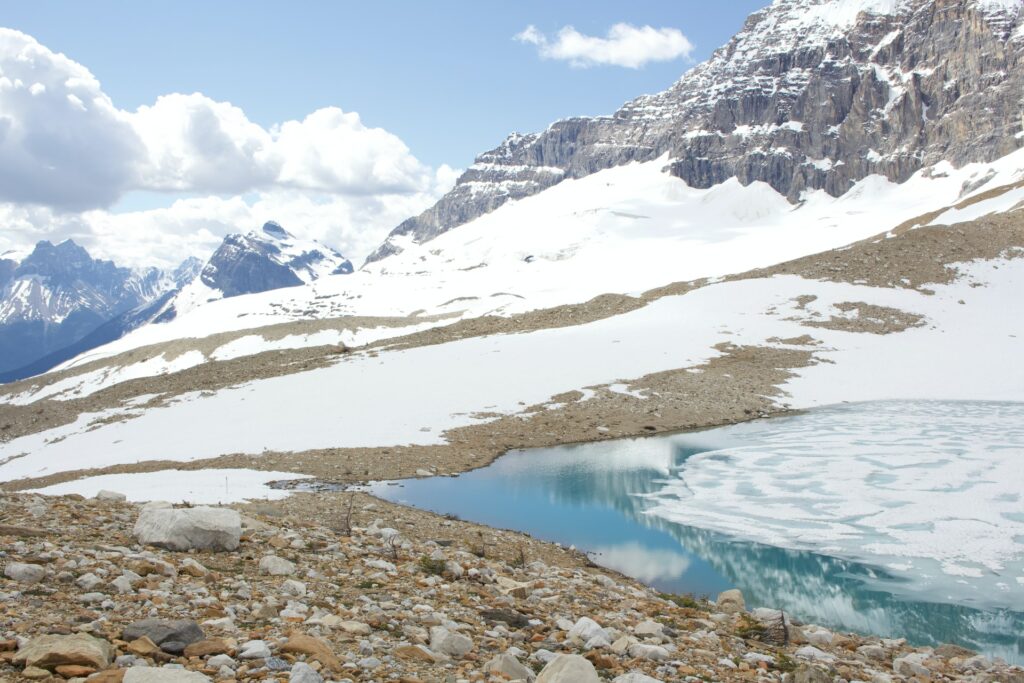
Distance: 28 km loop
Best Months: Mid-July to early September
Elevation Gain: 710 m
Combine several trails in Yoho National Park near Field to make an epic loop that takes in the spectacular Iceline and Whaleback Trails. The views of nearby peaks and waterfalls are breathtaking. Choose from two backcountry campgrounds along the way.
More Info: See Yoho National Park for trail info and reservations.
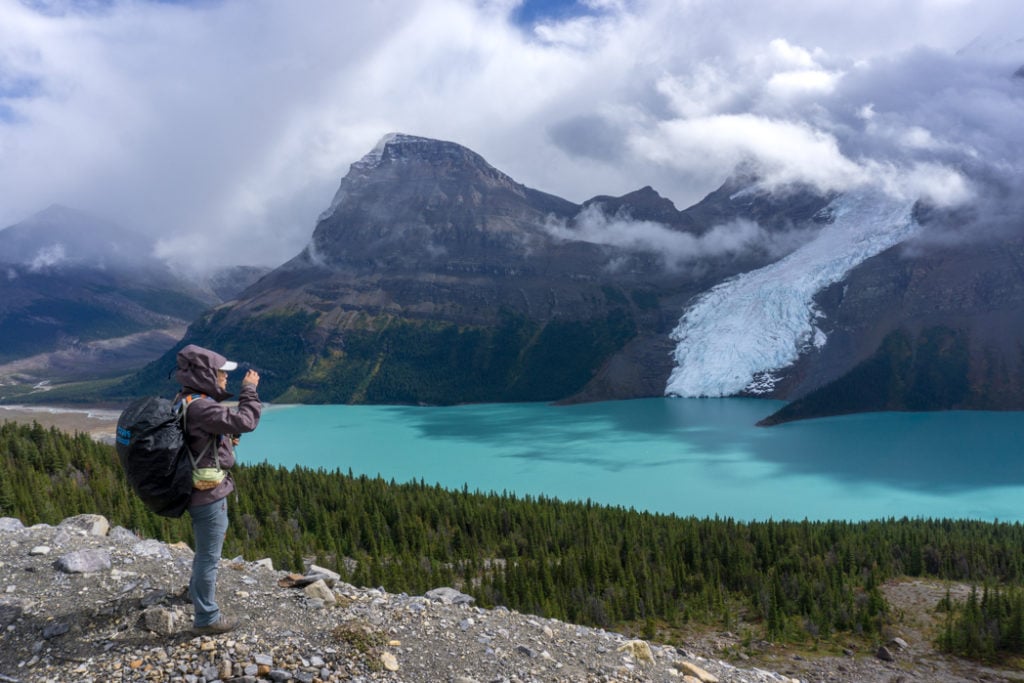
Heads up: The Berg Lake Trail is partially closed. It suffered extensive damage due to flooding in 2021. As of summer 2023, the trail is open up to Kinney Lake only. BC Parks plans to reopen the full trail in 2025.
Distance: 42 km round trip
Best Months: July to early September
This incredible trail near Valemount follows the Robson River uphill to Berg Lake, named for the glaciers crashing into it from Mount Robson, the tallest mountain in the Canadian Rockies. Plan to spend a few days in the area to tackle spectacular day hikes.
More Info: Get details on this hike in my Berg Lake Trail guide . For reservation info, see Mount Robson Provincial Park.
So there you have it: 30 recommendations for the best backpacking trips in BC. How many of these trips have you done? Is there an amazing backpacking destination that I left off the list? Tell me in the comments.
- 11 Best Backpacking Trips in the Canadian Rockies
- Backcountry Huts in British Columbia and the Canadian Rockies
- Backpacking Checklist: Gear You Need To Go Backpacking
- 20+ Ways to Reduce Your Backpack Weight
- Backpacking for Beginners: Tips for Getting Started
- Get my book: Backpacking in Southwestern British Columbia
- BC Backpacking Reservation Dates You Need to Know
- How to Go Backpacking in BC Without Reservations
- 25 Spring Backpacking Trips in British Columbia
- 24 Easy Backpacking Trips In BC For Beginners
- Coastal Hiking Tips: Advice for Beach Backpacking
- How to Choose the Best Backpacking Meals
- Latest Posts
- BC Parks Day Passes 2024 – Everything You Need to Know - April 25, 2024
- Joffre Lakes Hike (By a Local) - April 25, 2024
- The Ultimate Yellowstone Packing List for Every Summer Visitor - April 24, 2024
Thursday 28th of September 2023
Taryn, thank you so much! BEST. SUMMER. EVER!!! I completed all of the hikes on your list, and many more in your book and in Alberta over a four month period. All in all, I completed more than 2000km and over 50 mountain summits.
Prior to this, I had ZERO backpacking experience, I was obese, extremely out of shape, and am in my 40’s. I used your guides to plan out the logistics of this trip… all that was left for me to do was to keep up and complete this grueling itinerary. I was extremely determined and stubborn. Failure was not an option. Eventually, after beating up your body everyday and refusing to quit, your body just accepts its new reality and adapts. The transformation was so satisfying. I was too tired to think clearly most of the time. It was amazing!
To summarize your list: when I didn’t think it could get any better… it did! I can see why all these hikes are on the list, and I cannot give you a favorite, since they are all so beautiful and unique. Exceptional weather made a huge difference.
I have a few suggestions, requests, or criticisms.
1) Would you consider writing a similar review for Alberta? Best backpacking/hikes in Alberta? You did such a good job with BC. After traveling around BC, I was surprised how much incredible hiking was close to home in Alberta. Some of your hikes are literally next to the border (Yoho, Assiniboine, O’Hara for example). The world would be a better place if you made a list for Alberta!
2) The Great Divide Trail… it’s not on here?! Considering it’s a trail along the Alberta/BC border, I would consider this to be BC… have you hiked this trail and would you consider writing a review for it? It covers multiple areas in your list. In terms of legitimate backpacking, I don’t think it get much more genuine than the Great Divide Trail. It showcases the best the Rocky Mountains have to offer in BC and Alberta.
3) mountain summits… could you include these in your overview/guides on some of these areas/hikes? Similar to the “extending your trip” section in your book.
I can’t “pick favorites”… but mountain summits were by far the highlights of these incredible hikes. Not walking near or around the mountains… walking up to the top of the mountains. When I planed for this trip, I did not expect to do any summits. After completing some summits, I could not imagine doing anything else. Completing some of the hikes on this list without completing the surrounding summits no longer felt like a genuine accomplishment. This list of “best backpacking trips/hikes” could be just mountain summits.
For example: Mount Cook, Mount Weart, and the Armchair Traverse above Wedgemount Lake; Mount Overlord and Whirlwind Peak above Russet Lake; Mount Slalok and Tszil Mountain above Joffrey Lakes; Mount Yukness, Mount Schafer, and Little Odaray around Lake O’Hara; Sunburst Peak and Wonder Peak in the Assiniboine area; I completed 18 peaks in the Garibaldi area alone. There are many, many, more. None of them are technical in the sense they are not class five (legitimate climbing), and do not require glacier travel.
I may have planned my trips differently had I been aware of all these mountain summits. Not sure if you chose to exclude these because you consider them to be mountaineering or out of most people’s ability. They were by far the hardest part of my trip… but were by far the most rewarding part of my trip. Mountains get pretty real pretty fast, can be extremely terrifying and inhospitable places… but I was so surprised and amazed with how many of them I was able to walk up, one footstep at a time. In retrospect, this was the best experience I had. You could always make people aware of what’s around… they can decide for themselves if it’s within their ability or worth the risks involved… but the suggestion may just expose someone to the most incredible experience of their lives… that they otherwise wouldn’t have thought was possible.
Thank you Taryn… your guides/overviews planted an idea in my head that I worked hard to make a reality. You inspired me to get out of my comfort zone and challenge myself physically and mentally. I had no previous experience, was fat, out of shape, and hiking alone. I still have a ways to go, and many more places to walk, but what an amazing time! It’s possible to do so much in such a short period of time if you are determined enough to do it.
Taryn Eyton
Friday 29th of September 2023
I'm so glad to hear you enjoyed my book and website so much. To answer your questions. I don't have any plans to write a Canadian Rockies guidebook. The only way to easily do that would be to move to the Rockies for a few summers, and while that sounds amazing, it's not financially viable for me. I didn't include the GDT in my list because its too long - most backpacking visiting my site are looking for trips ranging from overnights up to about a week in length. While the GDT is an amazing accomplishment, it's just too long for most people. I have included some of the most popular BC sections of the GDT on y list, like the Rockwall Trail. And finally, I only included summits where there was an obvious trail to the peak from a backcountry campground. Scrambling and route finding outside the realm of expertise for most of my audience. In general, the hikes I recommend stick to class 3 terrain - class 4 is too much for most of my audience.
Jim And Sue Caruth
Monday 15th of August 2022
Taryn - looking at the ones we have done on your list makes us 100% sure your other recommendations are worthy. We will work at ticking as many as we can. Thanks for this list - it looks great. We knew of some but did not know some others. Awsome! Just in Port Hardy to start into 4 days on Cape Scott tomorrow - it’s drizzling - lol. Ps - kinda think the rock wall is more than a moderate hike especially if wedge is getting a challenging rating but we are splitting hairs here.
Monday 28th of February 2022
Great list Taryn - thanks for sharing. I have heard some good things about the following trips in Northern BC, but I have not done them - maybe some can be additions to a future expanded edition of your list (i.e. 35 or 40 best): Wokkpash Valley-MacDonald Creek Loop Trail, Chilkoot Trail (BC & Alaska), Rainbow Range (Tweedsmuir PP), Mt Edziza Traverse.
Tuesday 1st of March 2022
I hiked the Chilkoot Trail back in 2015 and it was great but I didn't put it on this list. It is technically half in Alaska, half in BC, but most people think of it as the Yukon since it's in a weird sliver of BC. Mt Edziza is also on my some day list.
Andreas Moser
Monday 3rd of January 2022
Thanks for bringing back to memory some hikes around Canmore and Banff
Wednesday 29th of December 2021
Thank you so much for sharing this list of places Taryn. Can’t wait to visit some of them in the future :)
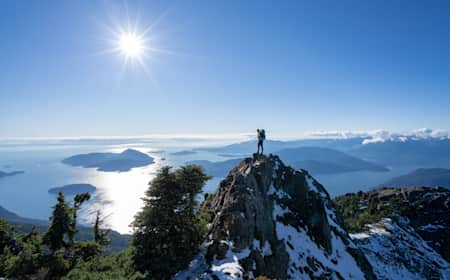
7 of the best backpacking trips in British Columbia
- 1 Juan De Fuca Trail
- 2 North Coast Trail
- 3 Panorama Ridge
- 4 Wedgemount Lake
- 5 Howe Sound Crest Trail
- 6 Okanagan High Rim Trail
- 7 Mount Assiniboine
Juan De Fuca Trail
Tips and tricks
7 practical hiking tips for beginners
Why running shoes are the new hiking boots.
- Duration: 3-5 days
- Distance: 47 km round trip
- Best Months: May to October
- Elevation Gain: 190 m
- Fees and Reservations: Camping fees are $10/person/night, first come, first-served.
North Coast Trail
- Duration: 4-5 days
- Distance: 43 km
- Best Months: May to September
- Elevation Gain: 240 meters
Panorama Ridge
- Duration: 2-4 days
- Distance: 18 km round trip
- Best Months: July to September
- Elevation Gain: >900 meters
- Fees and Reservations: Required, $6/night/tent pad, camping fees are $10/person/night
Wedgemount Lake
- Duration: 2 days
- Distance: 13 km round trip
- Elevation Gain: 1160 meters
Howe Sound Crest Trail
For more inspiration
10 of the world’s most stunning places to walk in a …
These are the 7 best trails for day hiking in vancouver.
- Duration: 2-4 Days
- Distance: 31.7 km
- Best Months: Mid-July to September
- Elevation Gain: 660 meters
- Fees and Reservations: None
Okanagan High Rim Trail
- Duration: 3-4 Days
- Distance: 58 km
- Best Months: Late-April to October
- Elevation Gain: 800 meters
Mount Assiniboine
- Duration: 4-6 Days
- Distance: 52 km
- Best Months: Mid-July to mid-September
- Elevation Gain: 480 meters
- Fees and Reservations: Reservations and fees are required to camp in the park through BC Parks and to camp on the access trails through Banff National Park.
Want more of this?
British Columbia
- Backpacking
Looking for the best backpacking in British Columbia? We've got you covered with the top trails, trips, hiking, backpacking, camping and more around British Columbia. The detailed guides, photos, and reviews are all submitted by the Outbound community.
Top Backpacking Spots in and near British Columbia

Panorama Ridge
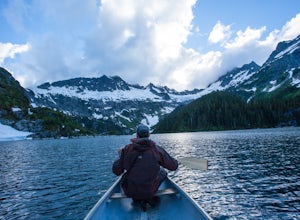
Backpack to Lake Lovely Water
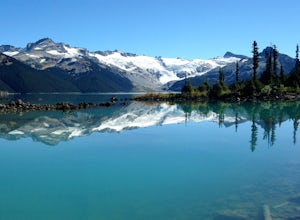
Hike and Camp at Garibaldi Lake
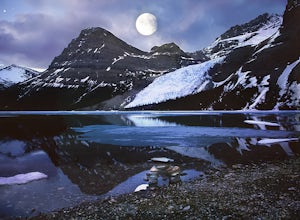
Backpack to Berg Lake
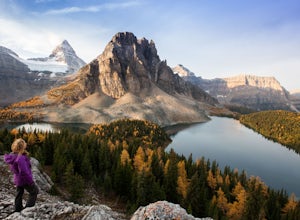
Explore Mount Assiniboine Provincial Park
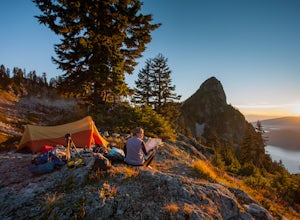
Hiking the Howe Sound Crest Trail
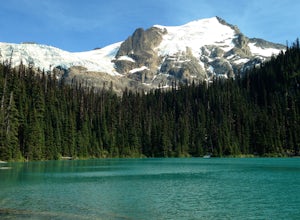
Joffre Lakes Trail
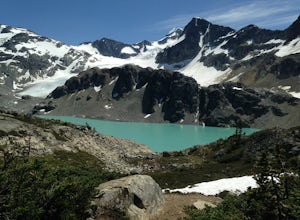
Hiking to Wedgemount Lake
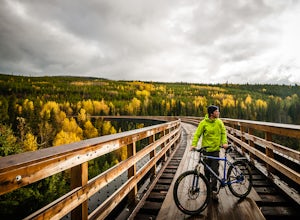
Cycle the Kettle Valley Rail-Trail
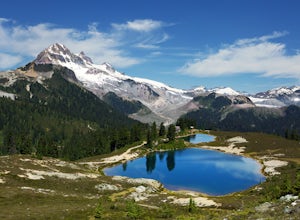
Hike to Elfin Lakes, BC

Hike the Cheakamus Lake Trail
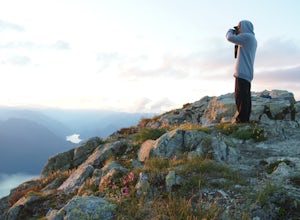
Summit Golden Ears
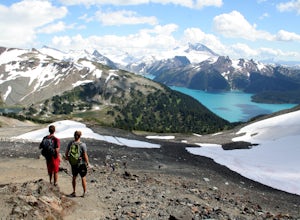
Summit Black Tusk in Garabaldi Provincial Park
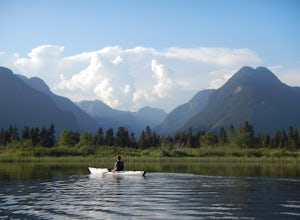
Paddle Pitt Lake to Widgeon Falls
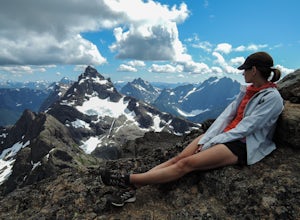
King's Peak Trail
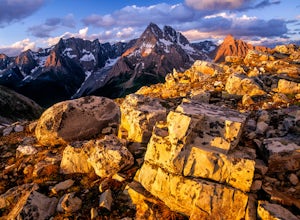
Hike to Jumbo Pass
Top activities.
- Mountain Biking
- Photography
- Rock Climbing
- Snowboarding
- Local Adventures
- Tours and trips
- Camping Nearby
- Outbound PRO Membership
- Add your property
Mobile Apps

© 2024 The Outbound Collective - Terms of Use - Privacy Policy
- Vancouver Island
- Okanagan Valley
- Gulf Islands
- Haida Gwaii
- Cariboo Chilcotin Coast
- Sunshine Coast
- Thompson Shuswap
- Whistler Area
- Things To Do
- Places To Stay
- Transportation
Hiking Tours & Guides in BC
There are day hikes exploring mountain peaks, remote lakes and rivers. Combined the BC network of trails and parks covers over 11,400,000 hectares of land with over 3000 kilometres of trails.
Hiking in British Columbia
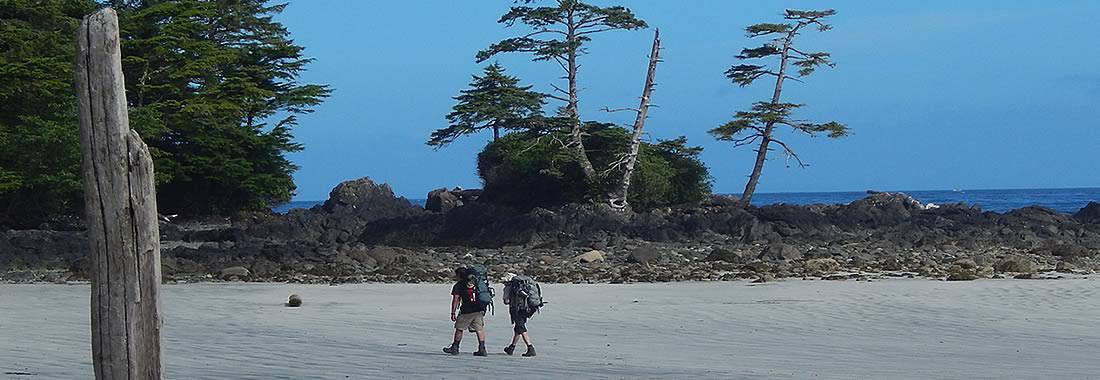
British Columbia hiking and backpacking opportunities are everywhere.
There are hiking tours through rough wilderness trails leading deep into the backcountry taking days, even weeks to complete. There are day hikes exploring mountain peaks, remote lakes and rivers. Combined the BC network of trails and parks covers over 11,400,000 hectares of land with over 3000 kilometres of trails .
The trail network in British Columbia is one of the best ways to discover the province. Hiking tours explore through rainforests, cross deserts and grasslands and climb over mountains. Trails lead to waterfalls, heritage sites, remote lakes, caves, alpine flowering meadows, hot springs, forest tower lookouts, glaciers and sandy beaches.
There are thousands of walking, hiking and backpacking trails in the British Columbia we have researched and below are some of our favorites.
Some of the more popular community hiking and walking trails include
the Tow Hill Trail near Masset on the Queen Charlotte Islands; the Wild Pacific Trail in Ucluelet on Vancouver Island; Forest for the World in Prince George in North BC; the Waterfront Pathway in Nelson and the Rotary Loop Trail in Golden located in the Kootenays and the Rivers Trail in Kamloops in the Thompson-Shuswap region.
Some of the more popular day hikes include
the Spirit Lake Trail near Skidegate on the Queen Charlotte Islands; Skookumchuck Narrows near Egmont on the Sunshine Coast; Twin Falls near Smithers in North BC; Begbie Lookout Trail and the Canim-Mahood Waterfall Trail near 100 Mile House in the Cariboo-Chilcotin-Coast region; the Greenway Trail in Kelowna in the Okanagan Valley region; Shannon Falls Trail and the Stawanus Chief Trail in Squamish in the Whistler region; Galloping Goose Trail in Victoria and Sooke in the Vancouver Island region.
Some of the long haul backpacking adventures in BC worthy of your attention include
the East Beach Trail near Tlell on the Queen Charlotte Islands; the West Coast Trail near Bamfield and Port Renfrew and the Cape Scott Trail near Port Hardy on Vancouver Island; the Sunshine Coast Trail near Lund and the Tetrahedron Park Trails near Sechelt on the Sunshine Coast; Monkman Park Trail near Tumbler Ridge in North BC; Kettle Valley Rail Trail in the Okanagan Valley region and the trails in Garibaldi Park near Whistler, BC, Canada .
Hiking Adventures in British Columbia, Canada
Book a Hiking Tour - Hire a Guide.
Fresh adventures.
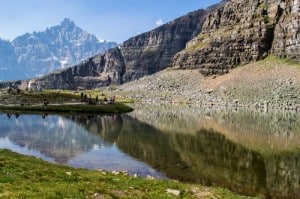
Ecotours-BC
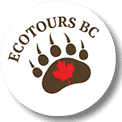
Nicola Valley Explorers
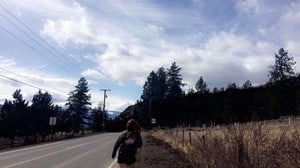
British Columbia Adventure Videos
- British Columbia
- Diana Mohrsen
- Lisa Muldoon
- British Columbia Attractions
- Other Things to Do
- BC Adventure Parks
- Artists - Photographers
- Entertainment
- Fishing Guides
- Flightseeing Tours
- Golf Courses
- Museums & Heritage Sites
- Hiking & Backpacking
- Horseback Riding Tours
- Hot Springs
- Houseboat Rentals
- Mountain Biking
- Rafting Tours
- Rock Climbing
- Scuba Diving
- Sightseeing Tours
- Water Sports
- Whale Watching
- Wildlife Tours
- WINTER ACTIVITIES
- Backcoutry Ski Tours
- Cross Country Skiing
- Dog Sled Tours
- Snowmobile Tours
- Snowshoeing
- Storm Watching
British Columbia Hiking Videos
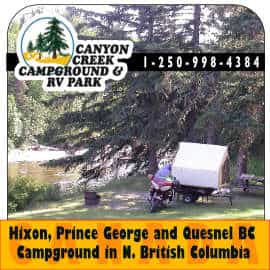

Explore Magazine

18 Epic Multi-Day Backpacking Trips in Canada

April 17, 2022

Multi-day backpacking trips take time to put together.
Planning is key. In fact, if you have dreams of spending a week under the stars, carrying everything you need on your back as you trek one of Canada’s most epic trails…
…Well, start planning for next summer, today .
We’re here to help you. For starters, you need a route. Scroll down and choose one of these 18 epic multi-day trips. Some are an overnight, some are a week. (Some, even longer!)
Stoked? Let’s get started in the West:
West Coast Trail
Pacific Rim National Park, British Columbia

It’s 75 kilometres of mud, sweat and maybe even some tears. It’s also 75 kilometres of vast sand beaches, towering old-growth evergreens, raging rivers, fairy-tale-esque waterfalls and whale and wolf sightings. Welcome to the West Coast Trail—running through Pacific Rim National Park Reserve on Vancouver Island’s remote west coast, this is one of Canada’s most iconic backpacking trips. Expect to take five to seven days to complete this challenge—or half that via the new midway entry/exit point at Nitinat.
Sunshine Coast Trail
Powell River, British Columbia
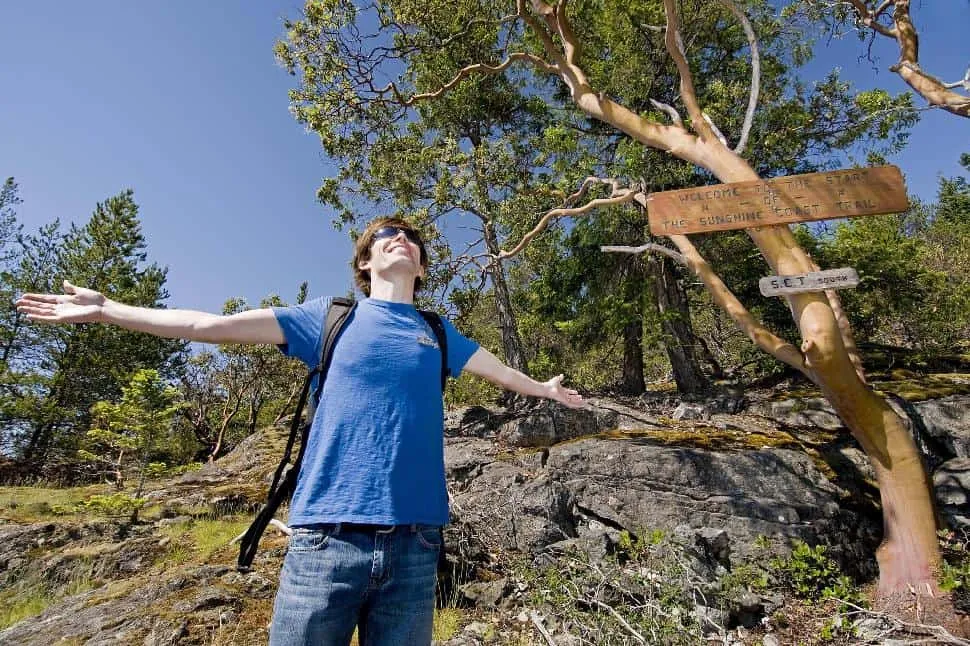
There are easy routes on Powell River’s Sunshine Coast Trail and there are tough routes. But they’re all amazing—this is one of the best hiking trails in Canada. Officially, it is Canada’s lengthiest hut-to-hut hiking trail and also the only free one. It’s 180-kilometres long, but it’s almost always done in segments—some as short as an hour or two, some for several days with stout climbs into the gorgeous alpine. For a primer, try the two-day Mount Troubridge section, or maybe Sarah Point to Powell Lake. Even a day-walk to Rieveley’s Pond is worthwhile.
Berg Lake Trail
Mount Robson Provincial Park, British Columbia

Located in Mount Robson Provincial Park, near the BC/Alberta border, 23-kilometre Berg Lake Trail is like a highlight reel for the Rocky Mountains. Under the shadow of 3,959-metre Mount Robson—the high point for the Canadian Rockies—you’ll wander past emerald-coloured Kinney Lake and near thundering Emperor Falls, entranced by dramatic mountain vistas throughout. Some lucky trekkers may even catch a glimpse of giant chunks of ice calving from the Mist, Berg and Robson glaciers.
Chilkoot Trail
Northern BC/Alaska

Running between Skagway, Alaska and Bennet, British Columbia, the Chilkoot Trail is a challenging 53-kilometre backpacking route that traces paths taken by Gold Rush prospectors more than a century ago. Expect steep climbs, rapidly changing weather—including a chance of snow any time of year—and a remote wilderness setting. Also expect vast alpine vistas, beautiful lakes, fascinating history and the lifelong boost of an extreme challenge bested.
Tamarack Trail
Waterton Lakes National Park, Alberta

The Tamarack Trail is perhaps the best multi-day hike in Waterton Lakes National Park—aim to trek it in September, when its namesake trees (also known as larches) are in full fall vibrancy, occasional dusts of snow decorate the peaks and daytime temps are comfortable without being too hot. For two to three days, you’ll wander into the alpine, through meadows, over ridgelines and atop stunning mountain and lake vistas. As a linear route, you’ll need to book passage on the Tamarack Trail Shuttle for the return trip to your car.
NOTE: After a devastating fire in 2017, some areas of Waterton remain closed. Before planning any hiking/camping getaway, visit: https://www.pc.gc.ca/en/pn-np/ab/waterton/visit/ideale_best
Skyline Trail
Jasper National Park, Alberta
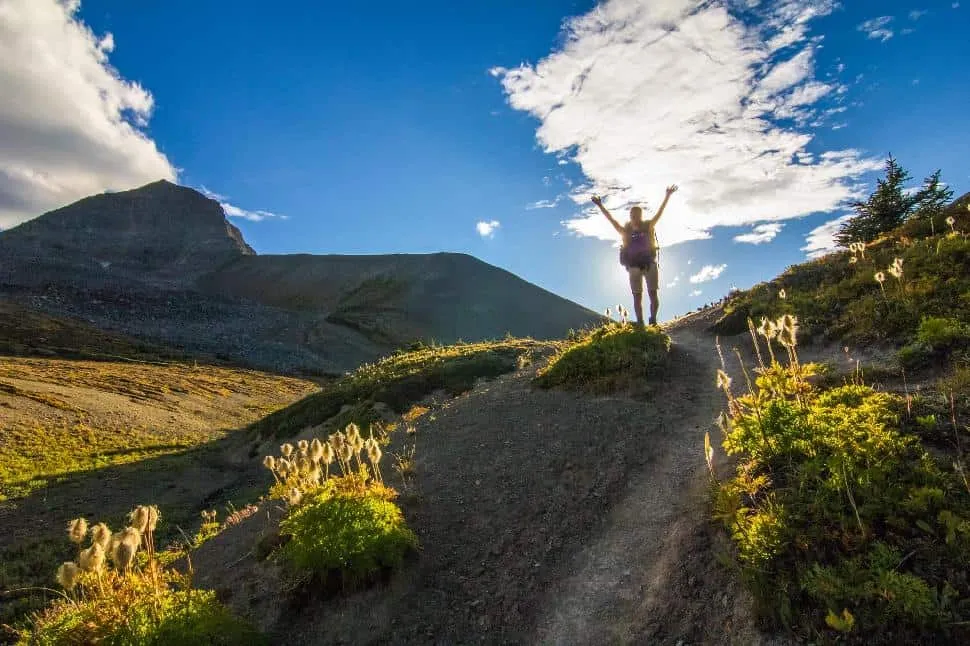
The Skyline Trail is Jasper’s signature backpacking route—a 44-kilometre-long scenic wonderland that meanders above the treeline for more than half of its distance. It is home to woodland caribou, grizzly bears and grey wolves. While some intrepid folk have steamed through Skyline Trail in a day, most spend more time in this high-elevation (2,510 metres maximum) environment to truly appreciate its beauty. The trailhead is at Maligne Lake; as a linear route, you’ll need to arrange shuttle transport.
Boreal Trail
Meadow Lake Provincial Park, Saskatchewan
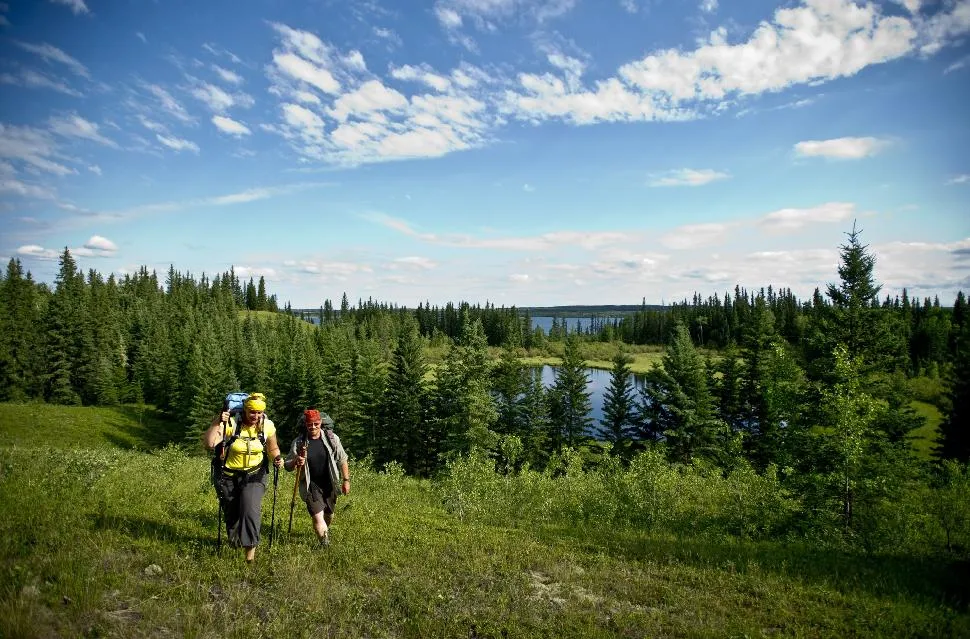
Officially opened six years ago, the 120-kilometre Boreal Trail is Saskatchewan Parks’ only officially designated backpacking trail. Meandering through lush Meadow Lake Provincial Park, a 1,600-square-kilometre beauty in the province’s northwest, hikers often choose to embark on a multi-day tour of this east-west route. Spend days beneath poplar, jack pine and spruce trees and fall asleep to a loon’s call at one of the plentiful back- and front-country campsites—or tackle it in smaller stages for easy day-hikes. Terrain is gentle with minimal elevation gains; the challenge comes in the distance.
Grey Owl’s Cabin
Prince Albert National Park, Saskatchewan

If you’d like to pay homage to Grey Owl, take a hike to his cabin in Prince Albert National Park. Accessed via Kingsmere Road, near the town of Waskesiu, intrepid hikers can make their way to this cabin and burial site on the shores of Ajawaan Lake. The route follows the eastern shoreline of Kingsmere Lake, and has three campsites en route plus one at either end. This is all-backcountry—though bear caches, firewood and pit-toilets are available at the campsites. The path is typical boreal terrain and should take less than six hours each way. For a quicker way to find the cabin, a three-hour paddle across Kingsmere Lake, plus a 600-metre portage to Ajawaan Lake, bypasses the hiking route.
Mantario Trail
Whiteshell Provincial Park, Manitoba

Whether you choose to tackle the three- or four-day end-to-end route of Manitoba’s classic backpacking route or knock-off a day-trip segment, the 66-kilometre Mantario Trail delivers a hard-hiking challenge only two-and-a-half hours’ drive east of Winnipeg. Expect heaving Precambrian Shield terrain, granite cliffs, beaver dams, fallen timber, peat bogs, steep gullies, jack pines and maple trees. There are 10 primitive campsites along the route, with fire pits and food storage boxes and, maybe, a picnic table or two. The trail is well-marked, and water can be accessed at many points throughout. Parking is at the north and south trailhead—keep in mind this is not a loop, you’ll have to arrange return transport.
Coastal Hiking Trail
Pukaskwa National Park, Ontario
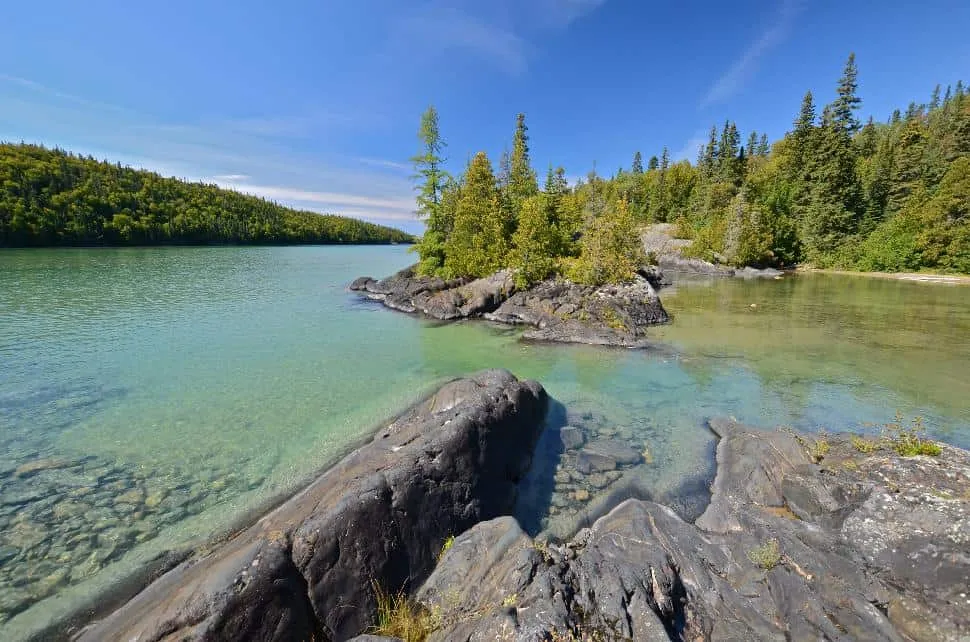
Set in Ontario’s largest national park—Pukaskwa—the Coastal Hiking Trail traces the wildest shore on all the Great Lakes for 60 memorable kilometres. Follow rock cairns along empty pebble beaches, meander through serene woodland, scramble over steep shoreline rocks and marvel at expansive views of Lake Superior. Well maintained and updated, there are campsites and suspension bridges along the route—though you will need to be self-sufficient and may ford some creeks. A one-way hike, travellers boat to North Swallow and hike out for 10 days to the trailhead.
La Cloche Silhouette Trail
Killarney Provincial Park, Ontario

If you can’t find a week off this year, you can still day-hike sections of the La Cloche Silhouette Trail from the George Lake Campground, but it’s worth the vacation time to tackle this classic Killarney trek in its entirety. Starting in the west, the route rambles through forested hills toward Acid and Lumsden lakes. You may have to cross a few streams; excellent wildlife watching abounds. Soon, you’ll be enjoying views of Georgian Bay as you hike over two-billion-year-old pink granite. In the eastern section, the trail ascends—culminating at The Crack, a strenuous daylong leg of this 100-kilometre-long trek. The sparkling white quartzite cliffs are worth the sweat; this area was once taller than the Rocky Mountains.
The Bruce Trail
Southern Ontario
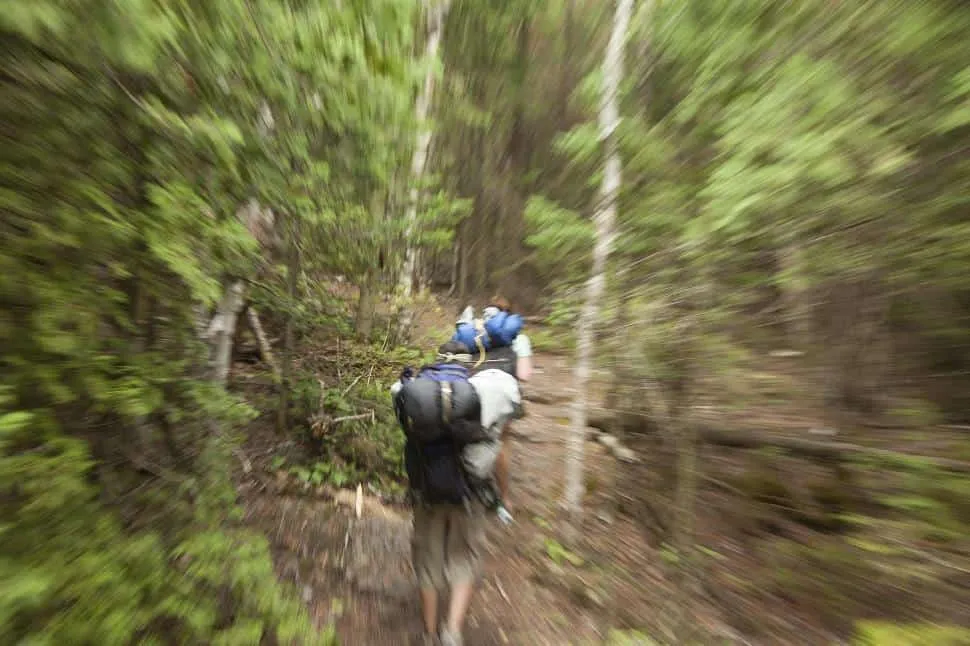
Perhaps the most famous trail system in Canada, the Bruce Trail is a lovingly maintained, achingly scenic route that traverses nearly 900 kilometres through southern Ontario. Leading from the Niagara Escarpment to Georgian Bay, expect everything from mixed-woods forests, to vineyards, to quaint townships, to lakeside cliffs, to pristine waterfalls and more. Legs range from an hour or two to a week-plus. Or do the whole thing, if you have a month to spare—the routes are well-marked throughout.
Pingualuit Crater
Pingualuit National Park, Quebec
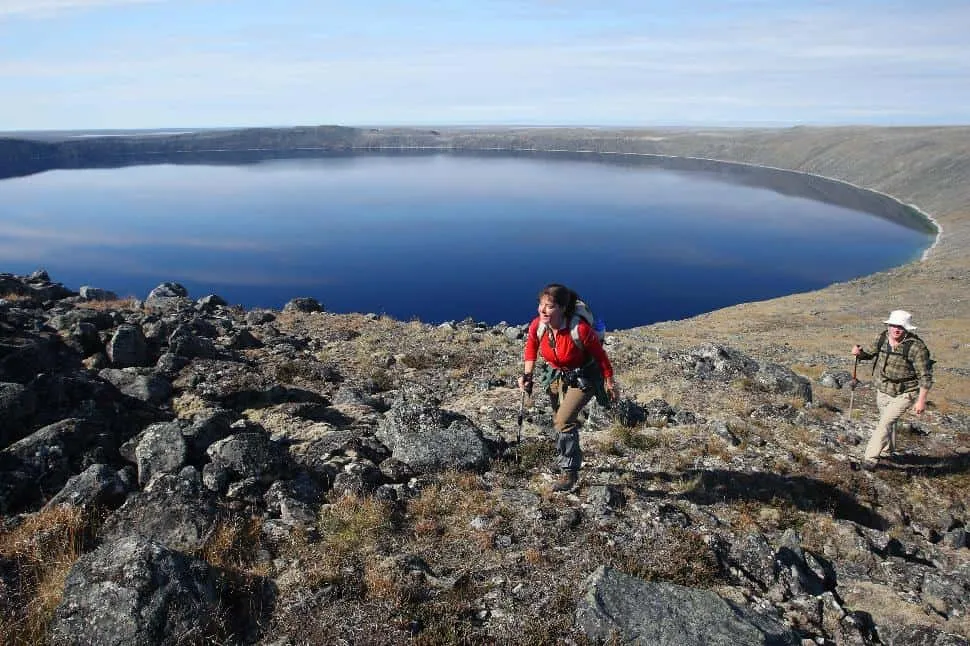
About 1.4 million years ago, a meteorite burned through the atmosphere above Arctic Quebec and smashed into the tundra, leaving a circular hole that looks today like it could have been poked by a punch. Filled with cobalt blue glacier water and surrounded by treeless barrengrounds, Pingualuit Crater is the namesake centrepiece of Nunavik’s Parc national des Pingualuit. To discover this wonder, join a nine-day guided trek into the park and learn about the land from Inuit guides, discover Nunamiut tent rings and perhaps even view elusive wildlife like caribou or muskox along the way. In Inuktitut, this region is dubbed nunavingmi pikkuminartuq , which means: “a remarkable location where a person may come to be revitalized.” And thanks to the full-service camp from which this trip is based, revitalization doesn’t come at the cost of creature comforts.
Fundy Footpath
Bay of Fundy, New Brunswick

The time to hike New Brunswick’s Fundy Footpath is now. Still relatively unknown, you can expect near-total serenity on this difficult 42-kilometre trek along the Bay of Fundy coastline. But word is getting out—and for good reason. Vistas from atop 100-metre-tall sea cliffs; empty beaches manipulated by extreme tides; thick mixed-woods forests—and did we mention zero crowds? This is for experienced hikers only. If your skill level isn’t quite there, try day-hikes on the nearby Fundy Trail—a maintained mixed-use network accessible for most people that still offers those wonderful views.
Liberty Lake Trail
Kejimkujik National Park and National Historic Site, Nova Scotia

More than 80 per cent of Nova Scotia’s Kejimkujik National Park is classified as “backcountry” and there are 46 designated campsites that can only be accessed via canoe or foot. At each, expect tent pads, fire pits, pit privy and cables to hoist your food cache clear of bears. So, when exploring the traditional home of the Mi’kmaq, where does one start? For the quintessential Keji experience, tackle the 64-kilometre Liberty Lake Trail. There are 11 options for backcountry camping along the route; though three or four nights out is a good rule of thumb. Lakes, babbling brooks, loons and moose will be your companions as you loop your way through mixed softwoods en route to Campsite 42—the most remote in the park’s entire 404-square-kilometres.
The Coastal Loop
Cape Chignecto Provincial Park, Nova Scotia

Accented by the famous Bay of Fundy tides ebbing-and-flowing below, views from atop Cape Chignecto Provincial Park’s 180-metre-tall sea cliffs reduce one to mumbling superlatives. And the best way to fully experience this scenic Atlantic preserve is via the 52-kilometre-long Coastal Loop. Starting as an easy front-country trek, be prepared to get serious after 12 kilometres—watch your footing between Mill Brook and Refugee Cove, where the trail becomes a series of switchbacks, and onward to Big Bald Rock, where it runs along the steepest sea cliffs in the province. There are seven backcountry campsites along the loop; most trekkers take three nights to complete the route.
The East Coast Trail
Avalon Peninsula, Newfoundland & Labrador

Another massive hiking route in Newfoundland, the East Coast trail runs south from Cape St. Francis, on the tip of the Avalon Peninsula, tracing the rugged Atlantic coastline for 265 well-marked and maintained kilometres to Cappahayden. Cute lighthouses, fluttering puffins and, offshore, leviathan whales and maybe even icebergs are just a few highlights. If you’re especially lucky, you may even spot the world’s southernmost caribou herd. Camp, or book B&B stays along the way and enjoy Newfoundland hospitality. And if you’re adventurous, you can continue on the “under construction” portion, an additional 275 kilometres that will one-day be as well marked as the inaugural half.
Talus Lake Trail
Tombstone Territorial Park, Yukon

Tombstone Mountains be your motivation as you sweat through this off-trail backpacking route. You’ll start in boreal forest before reaching scrubby birch and willow trees and, finally, the tundra. Over the next two days, veiw-points from Glissade and Grizzly passes are your rewards for the often-challenging conditions. Watch out for bears, and you may even spot migrating caribou. There are three campsites along the trail: Grizzly, Divide and Talus Lakes.

PS. Did these 18 hikes inspire you to get outside and explore more?
For the ultimate adventure inspiration, join explore magazine’s “Live the Adventure” Club.
With thousands of dollars’ worth in gear, prizes, exclusive interviews with experts, outdoors advice and a private Facebook community to share all your adventures, it’s no wonder explore’s LTA Club has over 1,000 subscribers across North America.
Click here to learn more.
Related Content:
How to Plan Your First Backpacking Trip
Read More >
Essential Camping Gear Checklist
When you purchase something via the links in our articles, we may earn a small affiliate commission. Read more about our policy .
E-BOOK TODAY!

READ MORE: Hiking , Hiking Trail Reviews , Trails , Travel

LEAVE A COMMENT Cancel reply
Recommended for you.

Climbing , Partner Content , Travel
In the High Alpine, You Need to Trust Your Team—And Your Gear
Read this inspirational story of three female athletes going on a high alpine climb in the Swiss Alps.

Editors’ Picks , News , Travel
13 Must-Read Adventure Books for Your Outdoor Bookshelf
There are 13 provinces and territories; here are 13 adventure books with one set in each.

Partner Content , Travel
Madrid: Come for the Tapas, Stay for the Hiking, Cycling and Epic Adventures
A trip to Madrid is often booked with an appetite—for rich experiences and tapas.

Adventure , Trails , Travel
The Kiwi Who Has Run a Marathon a Day Across Canada for Cancer
How does it feel to run the entire length of the second-largest country in the world?
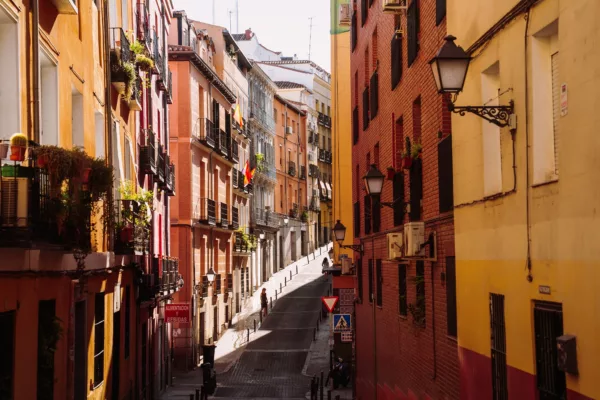
3 Quick Jaunts from Madrid
Looking for a cool outdoorsy experience near Madrid, Spain? Here are three of the best.

Adventure , Paddling , Travel
The Way of the Wolf: Kayaking ‘Round the Gap
Follow Frank Wolf on his 800 kilometre paddling journey called the Squagua expedition.
British Columbia Hiking Trips
- Start Date Select Month May 2024 June 2024 July 2024 August 2024 September 2024 October 2024 November 2024 December 2024 January 2025 February 2025 March 2025 April 2025 May 2025 June 2025 July 2025 August 2025 September 2025 October 2025 November 2025 December 2025 January 2026 February 2026 March 2026 April 2026 May 2026 OR, More specific start
- Wildlife & Safari Exploration
- Horseback Riding
- Local Market Visits
- Rainforest Exploration
- Small Ship Cruises
- Spa Relaxation
- Stand Up Paddle Boarding
- Village Visits
- Whale Watching
- Wilderness Lodge Exploration
- Wildlife Viewing
- American Constellation
- American Constitution
- MS Fridtjof Nansen
- National Geographic Quest
- National Geographic Sea Bird
- National Geographic Sea Lion
- National Geographic Venture
- Safari Endeavour
- Safari Explorer
- Safari Quest
- Silver Muse
- Wilderness Legacy
- British Columbia
Inside Passage & Glacier Bay Wilderness Cruise
- Enjoy Canada’s Inside Passages
- Visit Glacier Bay National Park
- Discover LeConte Bay
- Watch for whales at Frederick Sound
- Chilko Experience Wilderness Lodge
- Relax in your wilderness hideaway
- Cruise the Chilko River by jet boat
- Explore backwoods trails by ATV
- Horseback ride to mountain tops
Voyage to Great Bear Rainforest: Native Culture & Wildlife in the Land of the Spirit Bear
- Kayak across Great Bear
- Look our for Kermode bears
- Swim at hot spring pools
- Experience unique landscapes
Exploring British Columbia and the San Juan Islands
- Learn the histories of First Nation
- Search for killer whales
- Enjoy a private evening event
- Kayak and hike the wildlife coasts
Seward to Vancouver
- Cruise along Hubbard Glacier
- Witness bald eagles & brown bears
- Experience adventures in Juneau
- Explore the scenery of Seward
Treasures of the Inside Passage: Alaska and British Columbia
- Explore the San Juan Islands
- Observe a traditional performance
- Learn about the local cultures
- Search for humpback whales
- Kayak Misty Fjord’s waters
- Explore San Juan and Gulf Islands
- Observe a moving First Nations
Cruise To Alaska : Inside Passage with Glacier Bay & Olympic National Park
- Experience wilderness kayaking
- Watch for whales
- Tour LeConte Bay iceberg gardens
- Connect with Tlingit culture
- Watch for whales at Icy Strait

Inside Passage & Glacier Bay
Canada travel guide.
- All Canada Trips
- Great Lakes
- Canada: From Sea to Sea
- Northwest Passage
- Atlantic Coast
- Niagara Falls
- Saint Lawrence River
- Quebec City
- Canadian Maritimes
Favorite Canada All Trips
- Torngat Mountains Safari
- Narwhal & Polar Bear Safari
- High Arctic Muskoxen & Polar Bear Photography
- Arctic Char Fly Fishing
- Beluga Whale Photography
- Arctic Watch Discovery Experience
Top British Columbia Travel Destinations
- Pacific Northwest
- Vancouver, BC
British Columbia Trips by Departure Date
- 2024 British Columbia trips (24)
- 2025 British Columbia trips (15)
- 2026 British Columbia trips (5)
- June 2024 (6)
- August 2024 (6)
- September 2024 (11)
- April 2025 (6)
- September 2025 (13)
Top Experiences in British Columbia
- British Columbia Cruises (26)
- British Columbia Wildlife & Safari Exploration (9)
- British Columbia Luxury (8)
- British Columbia Cultural (3)
British Columbia Trips by Duration
- 8 day trips (8)
- 9 day trips (3)
- 13 day trips (6)
British Columbia Trips by Activity
- British Columbia wildlife viewing (24)
- British Columbia whale watching (21)
- British Columbia small ship cruises (15)
- British Columbia village visits (14)
- British Columbia kayaking (11)
- British Columbia hiking (10)
- British Columbia spa relaxation (5)
Why Travel With Adventure Life
Recognized by.


Backpacking 101: A Beginner’s Guide to Overnight Hiking
Thinking about trying out backpacking for the first time? You’re in the right place!
Read on to discover everything you need to know about planning for your first backpacking trip, from buying appropriate gear and choosing a destination to outdoor safety, backcountry meals and more!
It should help you feel more confident, organised and excited to go on your first backpacking adventure.
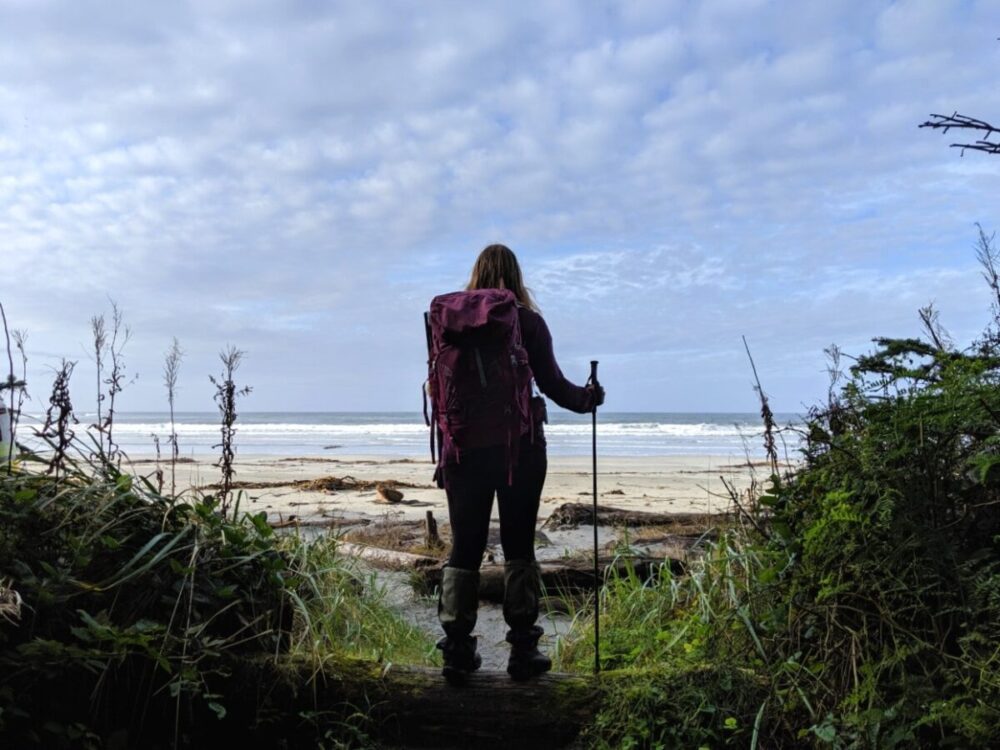
Writing this with the experience of 25+ backpacking trips, I want to help you avoid all of the mistakes that I have made over the years.
This is a comprehensive post, so here’s a contents breakdown:
How to plan a backpacking trip
Backpacking gear basics
How to stay safe
Backpacking inspiration
What to wear backpacking
Backpacking food and drink, how to leave no trace.
First time tips
While this guide is primarily aimed at hikers who are planning their first backpacking trip in Western Canada (BC, Alberta, Yukon), the information and advice is still relevant for backpacking trips anywhere. Let’s get started!
Published May 2021. This post includes affiliate links. If you make a purchase through one of these links, I may receive a small commission from the sale at no extra cost to you.
What is backpacking?
Backpacking is the activity of going on an overnight or multi-day hike and carrying all required equipment in a backpack.
Most backpacking trips involve camping in wilderness locations that are only accessible by foot (sometimes also by horse or boat).
This combination of hiking and camping offers the chance to see beautiful, remote locations that would be difficult to access otherwise.
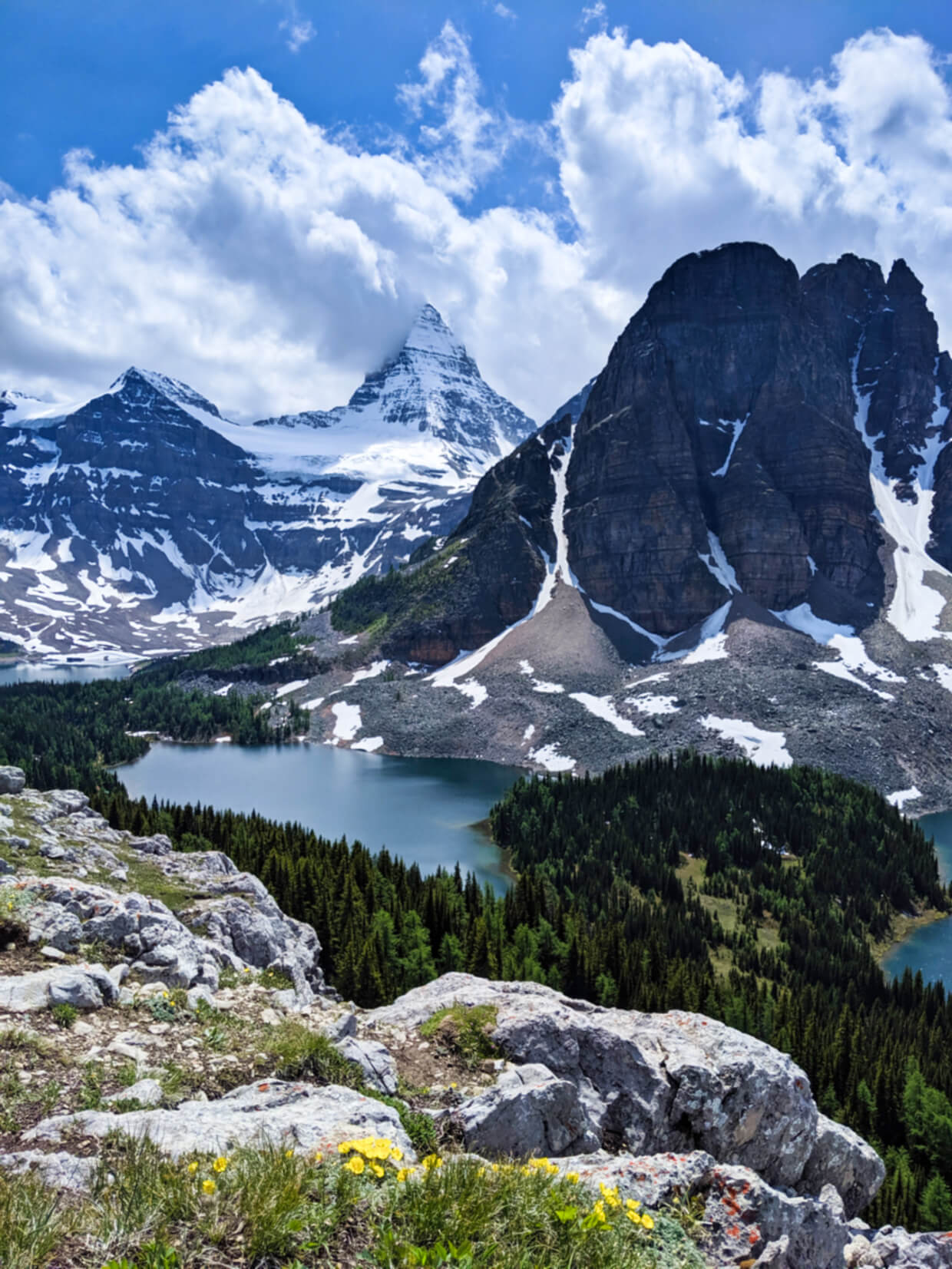
Preparation is everything! The more planning you do, the more successful your trip will be.
Keep in mind, however, that it also usually takes a few trips to refine the best backpacking set-up (food, gear, clothing, footwear etc.) for you.
The first trip isn’t meant to be perfect but it should be fun and inspire you to go again ASAP!
First time backpacking tips
When planning your first backpacking trip, I strongly believe you should try and keep it as simple as possible:
- Choose a destination relatively close to home (1-3 hours drive)
- Pick a campground that is within 10km of the parking lot , with low elevation gain (less than 500m total) and no technical features
- Plan to stay one or two nights
- Go in summer , when the weather is warmer
- Consider borrowing or renting gear to save money and test your own preferences before investing
- Get familiar with your camping gear before leaving home
Backpacking is a significant jump from car camping and day hiking in terms of safety and physical demand. Be careful not to underestimate this. Err on the side of easy rather than hard.
As mentioned above, summer (late June to early September) is an ideal time to go backpacking in Western Canada. There are a number of reasons why:
- The weather is both warmer and drier, two factors that make backpacking more comfortable and fun
- The summer months have the longest daylight hours
- Many alpine (mountainous) regions are snowed in until summer. In some places, snow can still be on the ground until mid July or even early August
- Trail maintenance usually happens in spring and summer. Before this time, you’re more likely to find fallen trees and other debris on the trail and/or closed facilities
In line with this, some provincial and national parks close during the winter and reopen in later spring/summer. Some of Western Canada’s most popular backpacking trails and campgrounds are closed until the summer months.

Where to go
For your first backpacking trip:
- Look for a short trail (10km or less, one way) relatively close to home. This distance may not sound like much, but your regular hiking pace will be slower with a heavier pack
- As well as looking at the distance, also examine the total elevation gain of the trail too. This refers to the total amount you will climb in a day. This can make a huge difference in the difficulty of the hike
- Backpacking close to home means that you’ll arrive at the trailhead earlier and have more daylight for hiking. If something goes wrong or you forget an item, you’ll also be home that much faster
- For safety and comfort, choose a popular backpacking trail. These are more likely to have have established backcountry campgrounds located near a water source, with outhouses and designated tenting areas.
To find a trail that ticks all of these boxes, I would suggest looking at local provincial and national parks first.
Researching hiking trails
For research purposes, I absolutely love the Backroad Mapbook series . After narrowing down potential options, I then go online and look for official information (such as on the BC Parks website), guidebooks, blog posts, hiking groups and recent AllTrails reports.
Using these sources, I evaluate whether I have the skills, experience and fitness to complete the hike. I also look for references on the trail condition, the best time to go (see below), what permits may be required, how the reservation system works etc.
Permits and reservations
This is probably the most complicated part of organising a backpacking trip.
National and provincial parks have permit systems to authorise overnight camping. Camping permits are usually offered on a first come, first serve basis, unless there is a reservation system in place.
Some of Western Canada’s most popular backpacking trails have reservation systems. Examples are the West Coast Trail (BC), the Berg Lake Trail (BC), the Rockwall Trail (BC), the Skyline Trail (Jasper) and the Chilkoot Trail (Yukon).
For these trails, it is important to plan months in advance to secure a reservation (though cancellations do happen!)
It is an important part of trip planning to check what kind of camping permit you may need and how to get it.
Check the official park websites first. Blogs can be helpful too but keep in mind that procedures can change from year to year. Check out my complete guide to BC backpacking reservations .
Backpacking gear
The most common mistake to make when backpacking for the first time is bringing too much equipment.
This section will guide you through the ‘must have’ items for backpacking, with tips to help you purchase the right backpacking gear for you. Alternatively, you can check out our dedicated packing guide .
You’ll find all of these items on our backpacking checklist, which is free when you sign up to our monthly newsletter .
I absolutely love talking about backpacking gear. I once worked at (and managed) an outdoor store, so I’ve personally tried and tested a lot of gear over the years. I’ve also helped many first time backpackers get started!
If you can, I would try and borrow gear from friends and family for your first backpacking trip. If that is not an option, consider renting items (easier in non-pandemic times) or purchasing second hand gear from Facebook marketplace.
Not only will this be easier on your wallet (and better for the environment!) but it means you have the chance to test out some gear before making any final purchasing decisions of your own.
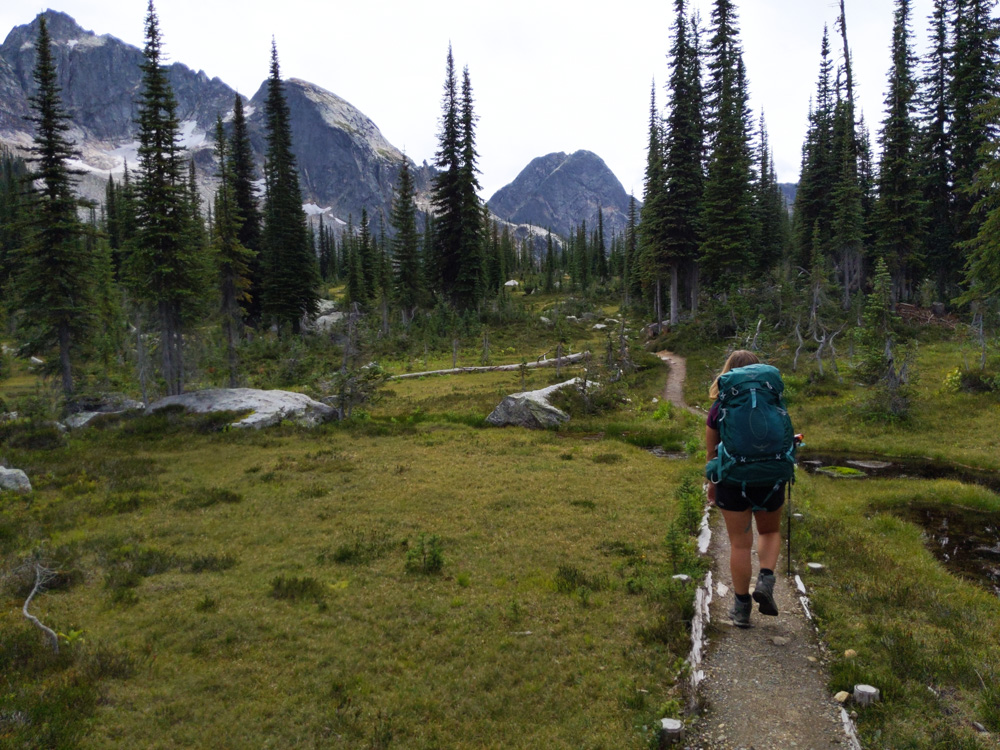
Quick backpacking gear tips
Whenever you do go ahead to buy backpacking gear, here are some golden rules:
- Your loaded backpacking pack should not weigh more than about 20 percent of your body weight
- Lighter gear is, however, usually more expensive and less durable
- The concept of ‘you pay for what you get’ is true with most outdoor gear. Quality usually goes hand-in-hand with price
- If you buy quality gear, you can expect a solid warranty. Most outdoor gear manufacturers will stand behind their products
Be sure to test and become familiar with your backpacking gear at home before leaving for a trip. It will potentially save time and frustration later!
Quick jump to:
Sleeping mat
Sleeping bag
Water purification
Communication devices
First aid kit, food storage, hiking poles, sun protection.
Other items
The 10 Essentials
These items that can help prevent slight inconveniences from turning into life-threatening emergencies.
The 10 Essentials are (by category):
- First Aid supplies
- Fire supplies
- Extra clothing
For more details and item recommendations, head over to my comprehensive 10 Essentials post.
There’s a lot to think about when choosing a backpack.
A good backpack should be comfortable and distribute the load of your gear evenly. It should also transfer the weight to the biggest and strongest muscles and bones in your body – your hips and legs!
Backpack sizing
The first step to choosing a backpack is to determine how much capacity you will need. There are a number of different factors that influence this (destination, season, activity, personal requirements etc.) but the primary one is length of trip.
Capacity is measured in litres, just like water. The most popular backpacking pack size is 50-70 litres. This is ideal for multi-day backpacking trips up to around 6-7 days in length. Ideally, all of your backpacking gear should fit within the backpack.
The great thing about a larger backpack is the flexibility to go on shorter backpacking trips. After all, it’s much easier to fit less items into a bigger pack than more more items in a smaller one. Don’t be tempted to bring more items than necessary, however!
If you really enjoy backpacking, you may later want to buy a lighter, smaller pack for shorter (1-3 night) trips.
Backpack fit
A well fitted backpack will help you carry loads much more efficiently. Backpack sizing is not, however standardised. Not every pack will fit every person!
The right fit is determined by:
- A harness system that fits your back/torso properly
- A snug fit on your hips (where most of the weight will be carried)
Start by measuring your back – having a friend is helpful for this!
- Tilt your head forward and find the most prominent vertebrae (C7) at the top of your neck
- Next, find the top of your hipbone (the iliac crest) and place your hands on top
- Trace a line between your thumbs on your back
- Measure the distance between this ‘thumb line’ at your C7 vertebrae. This is your back or torso length
Backpacking packs are often advertised with the torso length. This will help to narrow down options. Most backpacks do have adjustable harnesses so there is a little bit of leeway.
Trying on backpacks
When it comes to trying backpacks on, loosen all straps and then put the backpack on with the hipbelt first. The hipbelt should cover your hipbones and be snug, but not uncomfortable.
Then tighten the straps until the weight of the backpack starts to shift onto your shoulders. Walk around the store and see how it feels. Ideally, you’d have some weight in the backpack too for a more realistic experience.
It is absolutely imperative to try a backpack on to see if it fits correctly. Find a local outdoor store where you can try on multiple backpacks and see which one fits you.
Once you’ve found the right backpack for you, please purchase at the outdoor store where you tried it on. Buying online elsewhere really hurts small outdoor stores. If they disappear, there will be nowhere to try on backpacks!
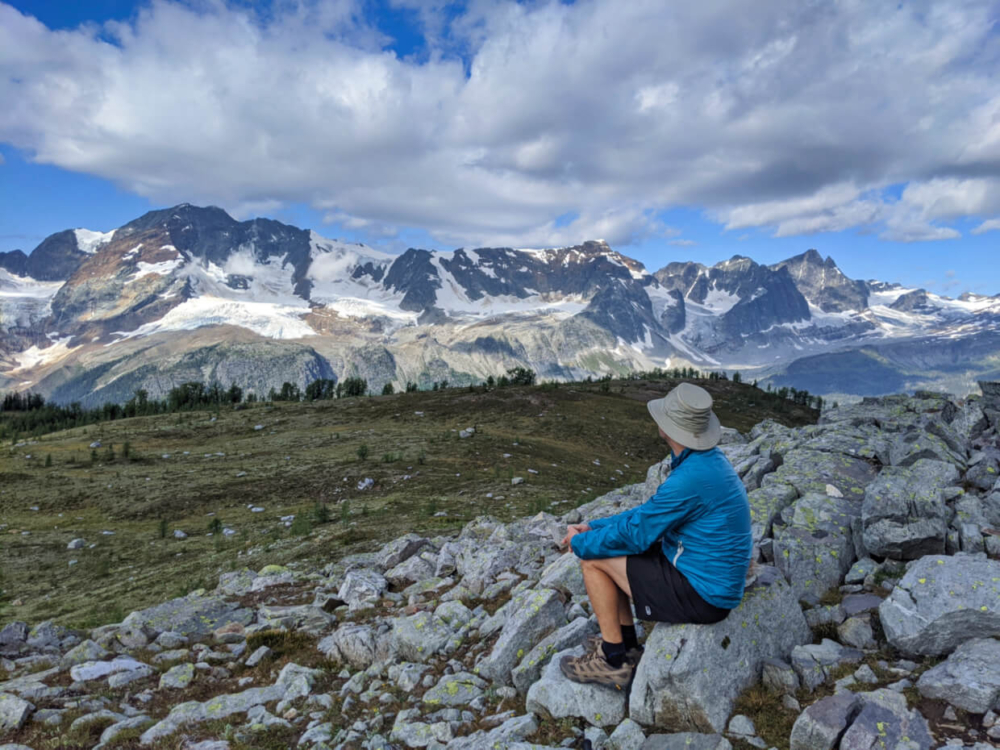
How to choose a backpack
Beyond fit and size, here are some other factors that may influence your backpack buying decision:
- Suspension system: Harness styles really vary between backpack manufacturers, with more/less padding, adjustments etc.
- Access : Backpacks traditionally open from the top (and often bottom), but newer designs sometimes have suitcase-style zippers or side access
- Pockets and straps. Do you like the minimalist style? Or do you want quicker access to snacks and equipment during the hike?
- Weight . The larger the backpack (and the more features it has!), the heavier it will likely be
- Gender . Women-specific backpacks are usually designed to have shorter harness systems, narrower shoulder straps and more contoured hipbelts
- Backpack cover . Some backpacks come with integrated waterproof backpack covers. They can be purchased separately too
I’m a big fan of Osprey’s backpacking packs . They have something for everyone, from entry level to ultralight thru-hiking backpacks. I love the incredibly supportive harness of my Aura 65 AG (which I usually use without the top lid on) – the load always feels SO much lighter! JR has the Aether 65 .
Choosing a tent is often one of the biggest decisions when buying backpacking gear. For most people, it is usually the heaviest and largest piece of equipment.
Backpacking tents are most easily categorised by their weight. Most two wall backpacking tents weigh between 2.5lb (1.1kg) to 7lbs (3.17kg). 4lb is a popular weight for a two person backpacking tent.
When travelling in a group, the weight of a tent can be split by distributing the rain fly, poles and tent to different people.
A lighter tent is easier to carry but will typically be made from materials that are less durable. More delicate materials mean less gear to carry in but may not withstand as much pressure from weather, rough campsites or human abuse.
How to choose a tent
Besides weight, here are some more factors to consider when tent shopping:
- Living space. Backpacking tents are usually on the smaller side compared to front-country or car camping tents. If space is a priority, think about sizing up e.g. from a two-person tent to the three-person version
- Three season vs. four season . Three season tents are designed for spring to autumn backpacking adventures and have mesh paneling and rain-fly vents to in crease ventilation in warmer temperatures. Four season tents are heavier and more durable to withstand winter conditions
- Door access. Some tents just have one door while others have two. With two or more people in one tent, having two doors can be convenient for those late night trips to the outhouse or just for flexibility
- Size of vestibules . Some tents have smaller vestibules (enclosed entrance space) to allow for more living and storage space inside the tent. Personally, I find larger vestibules more convenient for storing backpacks and wet clothes/shoes.
- Tent height. The peak height of the tent is the measurement at the highest point in the tent. If you’re on the taller side, this may be a key factor in your tent choice. Likewise, the length of the tent
We personally use the Freelite 2 by MSR . It’s a lighter and slightly smaller version of the very popular Hubba Hubba model . While we wish it could be a little more spacious, we’re very happy with the durability – 7 years and more than 25 backpacking trips so far.
Alternatives to tents
Most backpacking tents available on the market are double walled tents. This means that there is a tent body (first wall) and then a fly (second wall).
Single wall tents consist of just one piece of material. These are lighter and pack smaller but don’t usually ventilate as well as double walled tents.
Hammock camping has become more popular over the last decade or so. Not having to find a clear, level campsite when sleeping in a hammock is convenient. Set-up is also quick and the equipment fairly light. There is, however, a reliance on finding suitable trees.
For the ultimate in lightweight shelter, consider a tarp or bivouac (bivvy). These provide basic shelter and not much more. They’re a bit too minimalist for me personally but having such a light backpack would be appealing!

Sleeping bags are designed to keep you warm and comfortable while sleeping outdoors. Most backpackers will have their own, although it is possible to buy double versions if you want to share.
There’s a huge range of sleeping bags with different shapes, sizes and colours. Weight is still an important deciding factor with sleeping bags (as with all backpacking items!), but not usually the primary one.
How to choose a sleeping bag
The single biggest defining feature of sleeping bags is the type of insulating material used within them.
The insulating material (the fill) determines the temperature, compressibility and weight of the bag. There are two main types of sleeping bag fill – down (feathers) and synthetic (man-made).
I’m going to talk more about this in a second, but first, here are some other factors you may want to consider when searching for a sleeping bag:
- Temperature rating. The two main EN numbers to look for are the comfort rating and the lower limit rating. In my opinion, it is always best to go a little warmer than necessary. After all, you can always open your sleeping bag to cool down!
- Shape. A lot of backpacking-specific sleeping bags are mummy shaped. This not only makes them warmer but also lighter and less bulky. If this is an issue, look for rectangular/barrel models or wider versions
- Gender. Women’s sleeping bags are usually shaped differently (narrower shoulders, wider hips) and feature more insulation since men naturally produce more body heat
- Zips. Couples may want to buy sleeping bags that have opposing zips so they can be zipped together
- Packed size. Look for this measurement to work out whether the sleeping bag will fit in your pack. I’d recommend using a compression bag to help squeeze the air out and get the packed size even smaller
Synthetic vs down
Synthetic and down are the two most popular sleeping bag insulators. Some companies also mix synthetic with down, to get the best features of each material. Here’s a quick comparison of synthetic and down:
More expensive
Super compressible and easier to pack
Better warmth to weight ratio (lighter)
Durable – average longevity for a down sleeping bag is around 10 years
Loses insulating properties when wet without water resistant coating
Byproduct of the food industry*
Less compressible and larger to pack
Heavier for same amount of warmth
Limited longevity due to fibres breaking down after repeated compression
More water resistant than down (provides some warmth when wet)
*Look for a Responsible Down Standard tag to be sure that the bag was made to the highest cruelty-free standards.
Personally, I love down sleeping bags and believe it is worth the extra investment for such a warm, lightweight sleeping set-up. New technology is also enabling down insulation to be much more water resistant. I use a Rab Neutrino Pro 600 while JR has a MEC Draco (Wide) .
Alternatives to sleeping bags
Quilts are a lightweight alternative to sleeping bags. Though previously only available through specialist ultralight manufacturers, quilts are starting to be offered by some of the big outdoor brands too.
Sleeping mat/pad
A sleeping pad, or mat, offers cushioning and insulation to ensure a warmer and more comfortable night. Without a sleeping pad, the ground draws heat away from the body.
There are many different sleeping mats and pads available on the market, but they can generally be divided into these three categories:
- Air pads – These need to be inflated either by breath or an included hand pump. Air pads are light and pack down small. They can be damaged more easily than the other options but repairs are usually fairly simple
- Self-inflating pads – These use closed cell insulation and air to provide insulation. A few breaths may be needed to inflate the pad to its full capacity. Self-inflating pads usually feel a little firmer than air pads and are generally more expensive and less compact
- Closed-cell foam pads – The most basic sleeping pad on the market, closed-cell foam variations are lightweight, durable and cheap. Most people, however, will find this type of pad to be are less comfortable than the other two options above. Closed-cell foam pads are also pretty bulky
How to choose a sleeping mat
With the above in mind, here are some more factors to consider when sleeping mat shopping:
- R-value. This is a measurement of the sleeping mat’s resistance to heat loss. The higher the number, the more warmth the sleeping pad offers. For a comfortable three season pad, look for a rating around 3
- Shape. Not all sleeping pads are rectangular. Some lightweight versions are tapered towards the feet or are purposely short to save weight
- Size . Tall? Or move a lot in your sleep? Some sleeping mats have ‘long’ and ‘wide’ (and even ‘long and wide’) versions
- Utility . Double sleeping mats can save weight in a pack for couples. Alternatively, it is possible to buy systems (basically straps) to join pads together
JR and I share an Exped Hyperlite Duo . We really like being able to cut down on pack weight with a double sleeping mat. It’s also exceptionally comfortable and durable!
Sleeping mat maintenance
Always inflate sleeping pads before going on a trip to check for leaks and other defects. I made the mistake of not doing this once and had to sleep on a partially inflated mat for the next three nights!
Be sure to carry a repair kit (these are usually included with air pads) in case of small holes or leaks while backpacking.
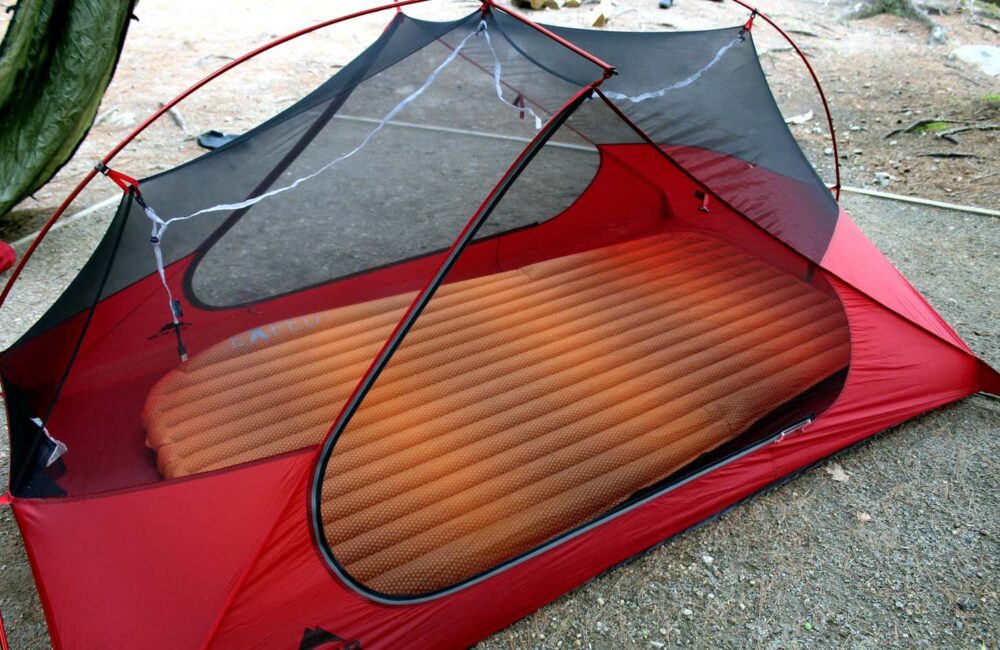
Backpacking stove
Cannister stoves are the most commonly used while backpacking as they are easy to use, lightweight and pack down small.
If you’re planning to eat mainly dehydrated or freeze dried meals for dinner, I’d recommend a Jetboil . The integrated pot design means that water boils exceptionally fast.
There are a few different Jetboil models, with the Minimo (the one we use) having a regulator for better temperature control as well as a wider pot. It’s a little more expensive than the Flash but I think these features make it worth the extra.
Canister stoves use a mix of propane and isobutane gas. Available in outdoor stores, gas canisters are sold in three different sizes. Stove manufacturers will recommend their own brand but they’re all relatively interchangeable.
Liquid fuel stoves connect to refillable fuel bottles. These are often used with white gas but some stoves will give you the flexibility of using other type of liquid fuels like diesel and kerosene.
These stoves are usually heavier and more difficult to use than canister stoves but have better heat control and stability. They also perform better in colder temperatures and higher elevation. Another major advantage of liquid fuel stoves is that you can fly with the empty canister, making it the most convenient option for international trips.
Some backpackers like to bring lightweight plates and bowls . It may seem a little lazy but we prefer to eat out of the cooking pot/freeze dried food packet. It saves extra washing up and saves weight too. We carry a long plastic spoon for this purpose.
Washing up kit
If you plan to do anything more than boil water at mealtimes, you’ll also need to bring a small cleaning kit.
This would typically include a container of biodegradable soap and a small scrubber/scraper . Prepare to air dry or bring a small dish cloth .
Be sure to secure all of your cooking items when not in use as they are potential attractants for bears and other wildlife.
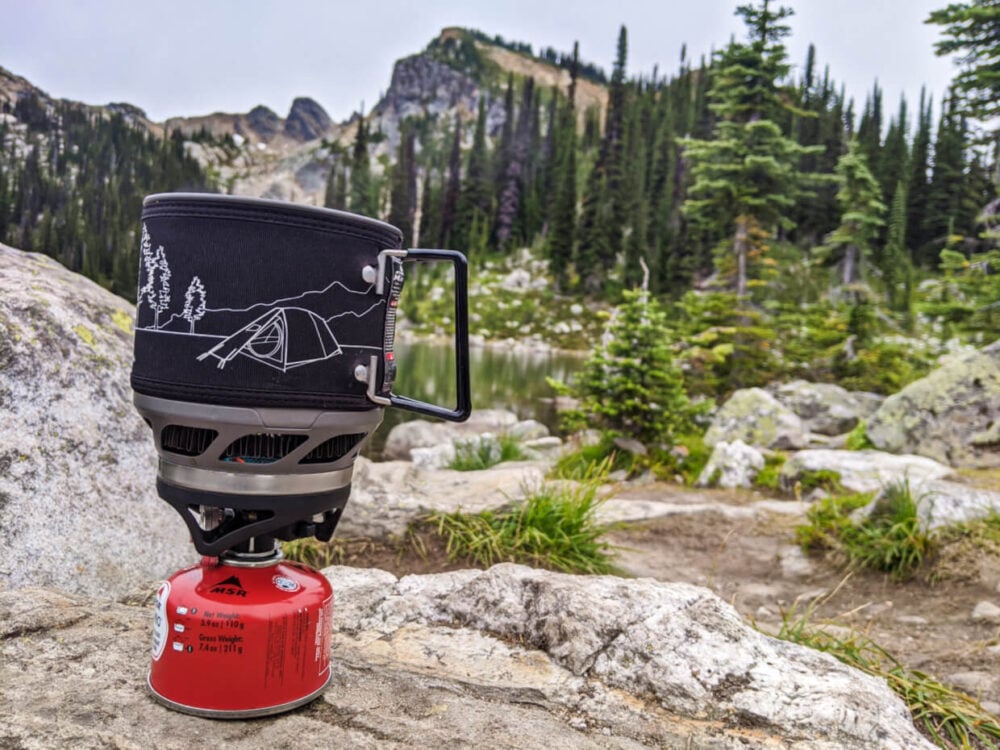
Water purification equipment
Water is essential for the body to perform well. Dehydration is dangerous! Drink plenty of water before setting out and bring plenty with you. I’ll talk more about this later.
Unlike at home, however, water in the backcountry isn’t always safe to drink. While it may look fine in appearance, it could be carrying bacteria that has the potential to make you very sick.
To make the water safe to drink, you can use a filter , UV light or water purification tablets.
We like to bring two variations of filtering/purification systems (usually the BeFree ), one being a handful of ultralight Aqua Tabs as a backup.
To store water, we both prefer to use a hydration bladder (2l) . I find these to be way more convenient than a bottle for drinking water while on the trail.
The stars may be bright in the backcountry, but you’ll still need to bring some lighting of your own.
A flashlight will do but it’s much easier to use a headlamp. This will free up your hands and make it much easier to find items in the tent, cook food or use the outhouses at night.
Headlamps usually run on regular batteries or lightweight Lithium-ion batteries (recharged by USB). The one we personally use, the Petzl Actik Core , runs on either.
When shopping for a headlamp, look are the amount of lumens. This indicates how bright the headlamp’s beam will be. Around 200-300 lumens is satisfactory for most backpacking requirements.
Other distinguishing features include beam patterns, sensors, size, strap styles and red light function (great for preserving night vision).
A First Aid kit is invaluable for every-day irritations (bee stings, small cuts) to major injuries.
Consider purchasing a basic camping first aid kit and then individually customizing it to your own needs. Be sure to check expiry dates on items before each trip.
Some essential items we have in our kit include bandages, blister plasters, surgical tape, oral rehydration salts, tweezers and antihistamines.
Taking a Wilderness First Aid course is also a good idea.
Storing food properly helps ensure that animals can’t get access to it. If they do, they may continue to seek out human food. This can cause major problems for both animal and human.
When not in use, food, toiletries, cooking equipment and garbage should be stored securely, away from your tent.
- Some established backcountry sites will have a food cache (a metal bear-proof container) or bear pole system . Always research the campground ahead of time to see what system is in place
- Be prepared to create a bear hang , in the situation there is no food storage system provided at the campground (or it is unusable). You’ll need a carabiner , dry/stuff sack and at least 15m (50 feet) of nylon cord
Alternatives include:
- The Ursack – a lightweight, collapsible puncture-resistant bear bag, particularly useful in alpine areas where large trees suitable for bear hangs are scarce
- A bear barrel/canister – a thick plastic container with a bear-resistant lid, an effective but bulky solution
Read More: Bear Safety While Backpacking

Hiking poles are great for stability. They also help to reduce pressure on the knees when descending.
The carbon version are the lightest, but also the most expensive. Aluminum hiking poles are cheaper and also more durable.
I almost religiously use (and love) Black Diamond’s Distance Carbon Z poles – they are foldable and incredibly lightweight.
While I almost always bring both poles (just in case JR wants one or there is a particularly tricky descent), I typically only use one.
There is no cell phone signal in large areas of Western Canada. That’s when satellite devices come into play. A satellite communication device makes it possible to request assistance in remote locations.
Popular devices include the Spot or InReach (both brands are recommended by Search and Rescue organisations).
We have the InReach SE+ , which works on a subscription system. In the winter, we turn the service off and pay a minimal fee to keep the contract.
If you bring a cell phone, charge it fully, turn it off and then store it somewhere waterproof.
Reserving the battery is important in case of emergency. If your phone is also your camera, bring a portable battery charger (don’t forget the cable).
Always carry a detailed map identify your location and how far you need to travel. Make sure your map is in some kind of waterproof container (even a Ziplock bag would do). In areas with a less defined trail, you’ll want a compass too.
Not sure how to use a map and compass? For hands-on lessons, check local hiking clubs and large outdoor gear retailers.
Even if using a GPS unit or phone app, always have a map as a back-up.
Sun protection is one of the 10 Essentials and is a must when backpacking at any time of year. Even on cloudy days, it is so easy to get burnt.
We usually decant 50SPF rated sunscreen into a smaller 100ml bottle for backpacking trips.
As mentioned later in this guide , sunglasses and a sun hat are also indispensable for sun protection on backpacking trips.
Duct tape is an all-purpose, fix everything lightweight saviour. You can use it to fix tent holes, broken poles, ripped clothing, broken backpack buckles and more. Here’s an idea how you can bring a small amount on your trip.
Tenacious tape is a great alternative and is easy to pack.
Having a knife or multi-tool is also immensely useful for a range of tasks including building shelter, creating kindling and assisting with first-aid.
Other useful items
- We pack almost all of our backpacking gear into lightweight, soft dry bags . This helps with organisation and also ensures that none of our clothing and equipment gets wet
- A waterproof backpack cover offers extra protection during snow, rain and hail. They can also help to keep backpacks clean in muddy environments
- Don’t forget all of your personal necessities such as toothpaste, toothbrushes and medication . Store any smelly items (yep, such as toothpaste) with your food at night to avoid issues with bears
- Bring a whistle as a signaling device (some backpacks already have these on the sternum strap). If lost or injured, yelling is tiring and also difficult for rescuers to hear. Whistle blasts are much more effective.
- A tarp can provide shade on sunny days and shelter on rainier ones. It’s a good idea to have some practice at home first before taking one on a backpacking trip
- Using repellent is the easiest way to ward off insects , but other options include mosquito coils , citronella candles , portable mosquito repellers and head nets
- A fire can be a lifesaver for backpackers needing to signal for help or suffering from hypothermia. Bring matches at a minimum, preferably of the waterproof kind or in a waterproof container
- Consider buying the footprint for your tent. It’s extra weight but can really help to prolong the life of the tent
- Bear spray is an absolute essential when backpacking in Western Canada. Carry it in a holster to make access easy
- Planning to camp outside of an established campground? Bring a trowel so you can dispose of human waste properly
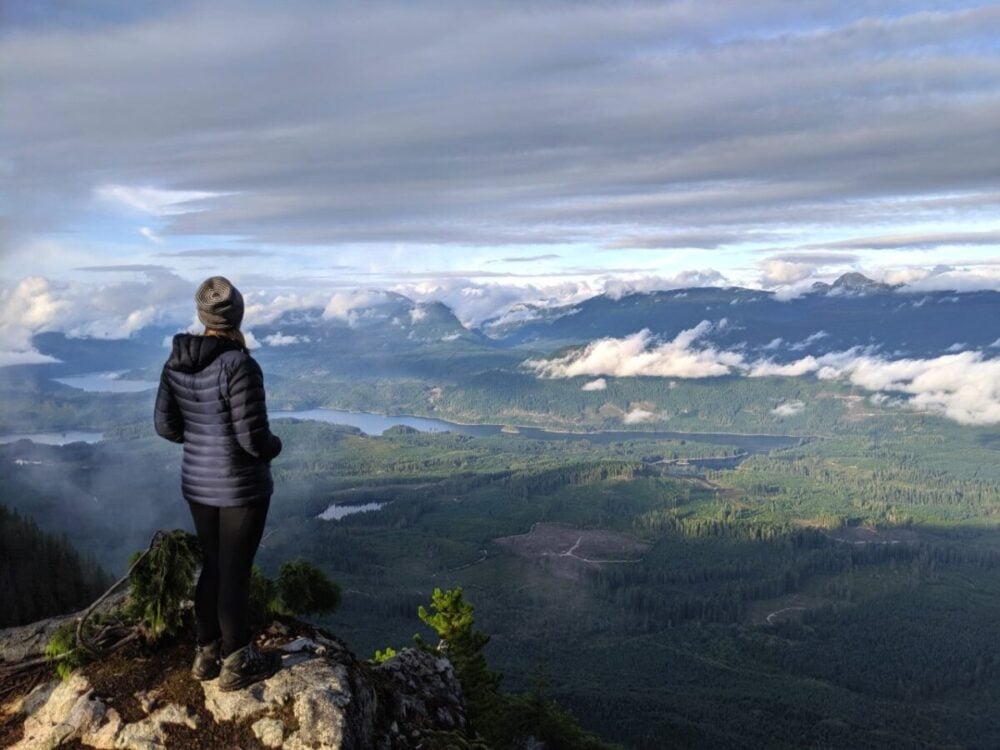
When spending time in the outdoors, it’s important to wear clothing that will keep you warm, dry and comfortable.
The key to this is wearing layers of clothing, made from moisture-wicking and quick-drying fabrics.
- Wearing multiple layers makes it possible to adapt to changing temperatures, weather conditions and hiking intensity. Trapped air between clothing layers also act as an insulator, keeping you warmer
- Moisture-wicking is the process of sweat being moved away from your skin. Keeping your skin dry is crucial to remaining warm.
Other features to look out for when considering your backpacking wardrobe are:
- Sun protection (long sleeves, UPF rating)
- Antimicrobial (to avoid odours)
- Weight (lighter items are easier to carry but likely less insulating)
- Pockets, zippers, hood and other details (preference, utility)
- DWR coating (Durable Water Repellency, to help rain bead off)
Bring clothes and accessories for the coldest possible conditions during the season you are travelling in. Weather can change very quickly, especially in the mountains.
Never assume that the weather at the trailhead will be the same at your destination.
The best outdoor fabrics
Nylon, polyester and merino wool are good examples of fabrics that layer and wick well. They also dry quickly.
I personally wear a lot of merino wool clothing when backpacking (tshirts, base layers, socks). I prefer it to synthetic materials such as nylon and polyester for a number of reasons:
- Merino wool is softer than regular wool (itch-less too!)
- The clothing is lightweight yet still warm when needed (natural temperature regulation)
- Provides warmth even when wet (more than polyester)
- Doesn’t stink as much as its synthetic versions (less washing, hooray!)
- Natural material (available from sustainable, ethical sources too)
The downside is that some people find it itchy. Clothing made from merino wool is usually less durable than polyester and nylon. Merino wool is also more expensive.
You may already have some suitable clothing for backpacking in your wardrobe – fitness wear, for example, is often made from polyester.
Whatever you do, avoid cotton. As well as being a heavy material, cotton is absorbs water easily, doesn’t dry quickly and does not insulate when wet.

The layering system
In this section, I’m going to take you through the ideal layering system for backpacking.
Base layer/first layer
The next-to-skin layer should always be moisture-wicking, to keep you dry and warm. Choose between synthetic or wool variations (see above for details).
Base layers , also known as thermals, are ideal for this purpose, especially in Western Canada where the climate is fairly cool.
Top base layers often feature long sleeves and are usually form fitting (but not skintight) so you can easily add other clothing on top. Bottom base layers are similarly slim in style, full length and are often referred to as ‘long underwear’ (or ‘long johns’ for short).
I always bring base layers (specifically the Icebreaker brand ) on backpacking trips, no matter the time of year. On cooler days in the mountains, I’ll be wearing a top base layer (and sometimes a bottom layer) during the day. On warmer trips, I’ll only wear base layers in the evening and at night.
If base layers are not needed, your first layer will be a t-shirt or long sleeved shirt. On the bottom half, hiking pants or shorts . Yoga pants or leggings/tights ( like these ) can be good but offer less protection against mosquitoes and rocks/brush.
The middle layer is all about insulation. The type of mid layer you’ll want will depend on your backpacking destination.
For most of my backpacking trips in Western Canada, I bring two mid layer tops – a thicker merino long sleeve (like this ) and and a light insulated jacket.
The long sleeve top is great to hike in on cooler days, while the insulated jacket (also known as a ‘puffy’) is perfect for evenings around the campground.
Fleece tops are very popular for mid-layers as they provide warmth without much bulk.
Puffy jackets are typically insulated with synthetic, down (feathers), wool or a blend. Down is generally considered to be the warmest jacket insulator. It does, however, lose its insulation power when moist or wet.
Synthetic insulated jackets have a lower price tag than down jackets but perform better when damp/wet and also dry faster.
Shell layer
This is the last layer of protection against the elements. A fully waterproof shell jacket is ideal for wind/rain/snow protection.
Depending on your destination, you may also want to bring waterproof pants (like these or these ) to pull on quickly when full wind and rain protection is required.
In dry, cooler conditions, you’ll be able to use your mid layer as an outer layer. For example, I use my synthetic Arc’teryx Atom LT as an outer layer during dry weather and then a mid layer underneath a waterproof shell when raining.
Hiking boots
It would be easy to get overwhelmed with the huge choice of hiking shoes. It’s important, however, to take the time to find the right pair for you as it is key to enjoying your first backpacking trip.
The best plan of action is to visit an outdoor store and try on different types of hiking shoes
- Bring a clean pair of hiking socks (see info below) and orthodontics, if you use them
- I would suggest starting with backpacking boots. These are designed to carry heavier loads, with stiffer midsoles and a high cut covering the ankles
- Some experienced backpackers prefer to wear lighter hiking shoes or trail runners. There are benefits to this but also disadvantages
- The fit should be snug, but not tight. Your toes should not touch the end of the shoe
- Take the time to walk around the store to really get a feel for the shoes. If there are stairs in the store, use them!
- If you’ve ever had problems with your feet, you may want to replace the factory insoles with supportive footbeds (like these Sole ones )
- After purchasing, wear your new shoes around the house for a few days to ensure it’s a good fit for you. Returns aren’t usually possible after you’ve worn them outside
- Before your trip, make sure you get in a few good hikes with your new boots. This will allow the shoes to mold to your feet better. Pay attention to any hot or sore spots
On most backpacking trips, I also bring a pair of ‘camp shoes.’ It feels SO good to get out of my boots at the end of a long hike!
Depending on the trail, I may bring my hut booties or a pair of flip flops . In 2021, I discovered Teva’s Hurricane Drift sandals . These are perfect for hanging out in camp (with or without socks!) and also for crossing creeks and rivers.

Hiking socks
Wearing a decent pair of socks is almost as important as the footwear you use! I swear by lightweight merino wool socks. Not only do they feel soft and cosy, but they never get too hot or stink terribly! I always keep one fresh pair for sleeping in.
Icebreaker socks have long been a favourite of mine (specifically the Hike+ Light series ), but I also like Darn Tough and Smartwool . $25+ may sound like a lot for a pair of socks, but the cushioning and quality construction is worth it.
Accessories
For additional warmth and comfort, I always bring this trio of warm accessories when backpacking in Western Canada.
- Heat is lost from any body part not covered, which means wearing a wool toque an easy way to stay warmer on cooler days and evenings
- A neck gaiter is effectively a stretchy neck warmer, but can also be used for sun protection. The most popular brand is Buff. I love the merino wool ones for hikes in cooler climates
- For most backpacking trips, a light pair of gloves is helpful for additional warmth in the evenings. I sometimes wear mine overnight if the temperature drops significantly
Sun protection is important too, with my essentials being:
- Sunglasses, with polarized lenses. I tend to bring an older, cheaper pair on backpacking trips, in case I lose or damage them
- A sunhat . I usually go for a baseball cap but JR prefers his Tilley hat for 360 degrees of protection
Example backpacking clothing list
I usually bring the same clothing on every backpacking trip:
- 2 x merino wool t-shirts
- 1 x merino wool base layer top (for cool hiking)
- 1 x merino wool base layer top (to sleep in)
- 1 x hiking pants
- 1 x merino wool base layer pants
- 1 x light synthetic jacket
- 1 x shell jacket
On longer trips (4+ days) I will bring an additional t-shirt or be prepared to wash the one I have at some point. For colder adventures, I would bring an extra long sleeve top.
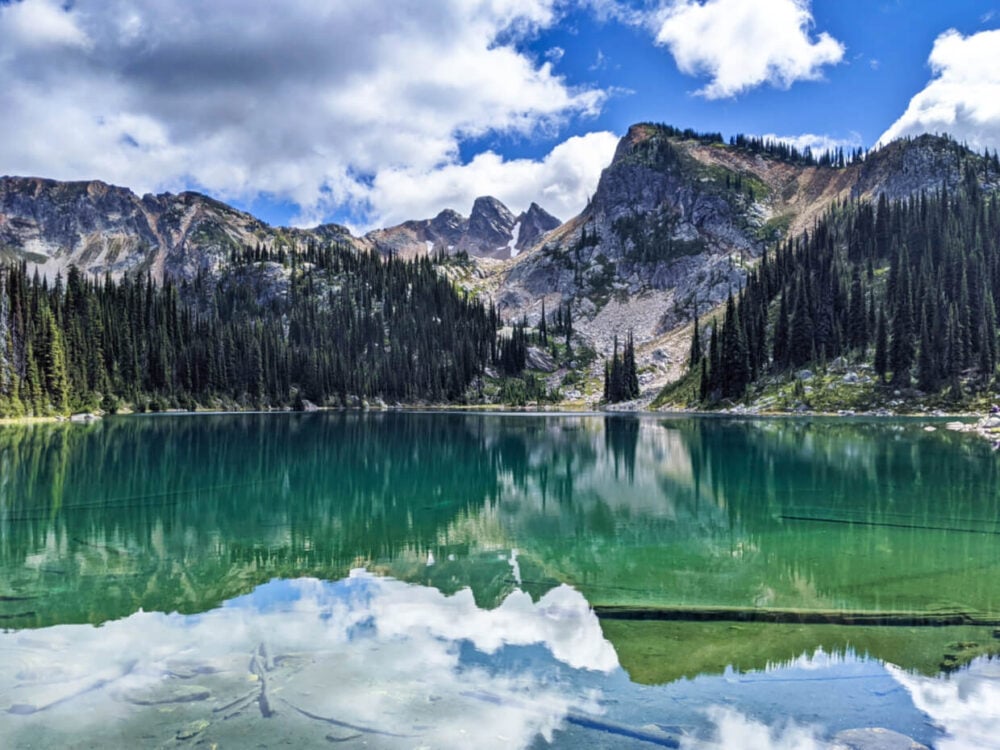
Food is fuel – this is particularly true when backpacking! But it also requires a little more thought, especially since you have to carry it on your back.
This section will guide you through the basics of meal planning for backpacking trips, starting with the importance of hydration.
Adequate hydration should be a priority on the trail. With too little water, you’ll soon be feeling dehydrated, lethargic and weak.
The amount of water needed varies on the climate, the difficulty of the trail and your own requirements. No two hikers are the same! Whatever you do, Don’t wait to be thirsty as that means you’re already dehydrated.
A good benchmark is to aim to drink around half a litre of water per hour (moderate temperatures, moderate exertion).
It’s also crucial to hydrate before and after hiking as well. Be sure to have some water available in the tent too.
Another contributor to fatigue is the loss of electrolytes (such as potassium, sodium, magnesium) through sweating. A lot of hikers like to help replenish these by adding electrolyte-rich tablets (like Nuun , my personal favourite) or powders to drinking water.
Backpacking food
The best backpacking foods are:
- Nutritious – A balance of protein, healthy fats, carbohydrates, fiber and vitamins is essential for energy and good health
- Calorie dense – Lightweight items are easier and less tiring to carry while backpacking. Calorie dense items provide a high number of calories relative to weight
- Shelf stable – There’s no refrigerator in the backcountry! Safe storage at room temperature is a must to avoid food spoilage or sickness
Some of the most popular backpacking foods include:
- Granola or oatmeal for breakfast
- Tortillas, peanut butter, tuna, jerky ( vegan or meat), cheese , crackers for lunch
- Pasta or rice based dehydrated or freeze dried meals for dinner*
- Dried fruit , nuts, trail mix, seeds, protein/granola bars , M&Ms, sesame sticks
All of these foods are calorie dense, shelf stable and lightweight. Combined, they provide a nutritious diet for backpacking purposes.
*These can either be made at home (DIY) or purchased from grocery stores, specialist outdoor stores or online.
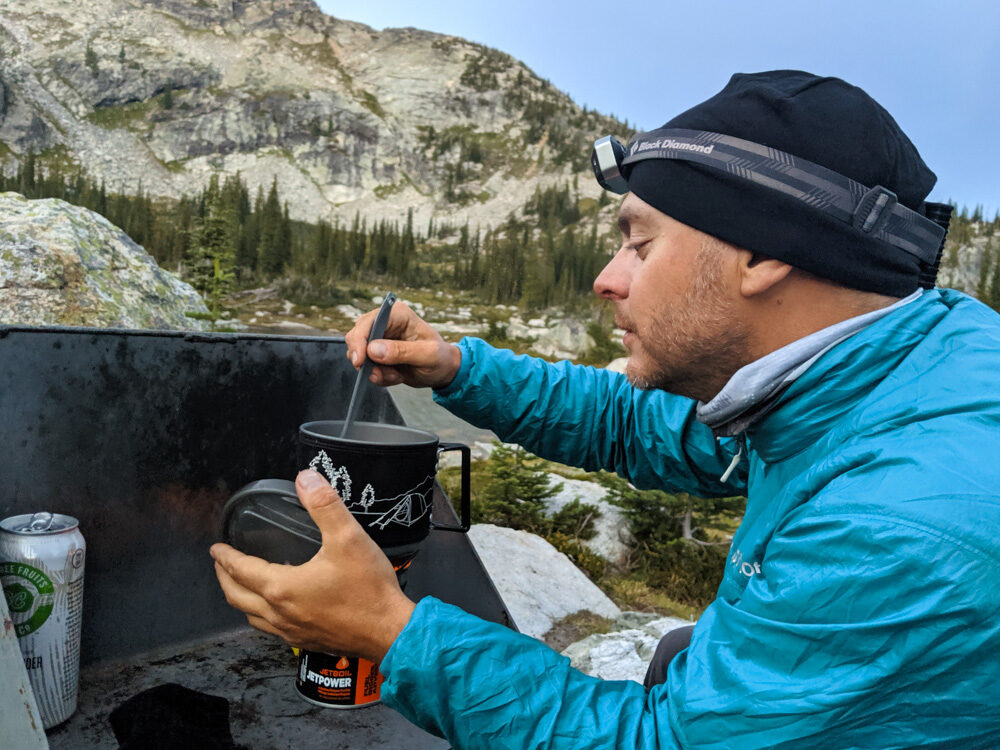
How to meal plan
If you’re not sure where to start meal planning, I’d suggest using a hiking calculator to first work out an estimate of many calories you will be burning on your backpacking trip. There’s quite a few options online for this, but I personally like the ‘Calories Burned HQ’ calculator .
While there’s no need to get super technical about calories when just starting out, this calculation will give you a really good idea of how much you will need to fuel your body while backpacking. Spoiler: it’s a lot!
Remember that you’ll also need to factor in average calories burned per day while resting too – that’s the figure you see mentioned on nutritional information on food packets. It varies from person to person, with the average being 1,600-2,400 calories for women and 2,000-3,000 for men.
With all that in mind, head to Right on Trek’s website . This is a US based company providing custom backpacking meal plans. The cool thing is that you can use their meal planner system to provide inspiration for your own trip.
After selecting a few preferences (length of trip, calories, dietary requirements) a plan will pop up with breakfast, lunch, dinner and snack ideas. This will give you a very good starting point for own personal meal planning.
Backpacking meal ideas
Food is always subject to a lot of personal preference and backpacking food is no different!
The good news is that there are SO many options for backpacking food. And there are so many awesome websites out there offering ideas and inspiration for backpacking food and meal planning (my partner recently started TrailGourmet for this purpose!) as well.
For your first backpacking trip, I would recommend purchasing mainly grocery store items for breakfast/lunch/snacks, with freeze dried meals for dinner.
This keeps things simple in terms of planning and will help you discover what your preferences are for future backpacking adventures.
Freeze dried meals are on the pricey side, but for a first time trip, I think you’ll find the convenience (simply add boiling water and wait) very helpful after a long day of hiking.
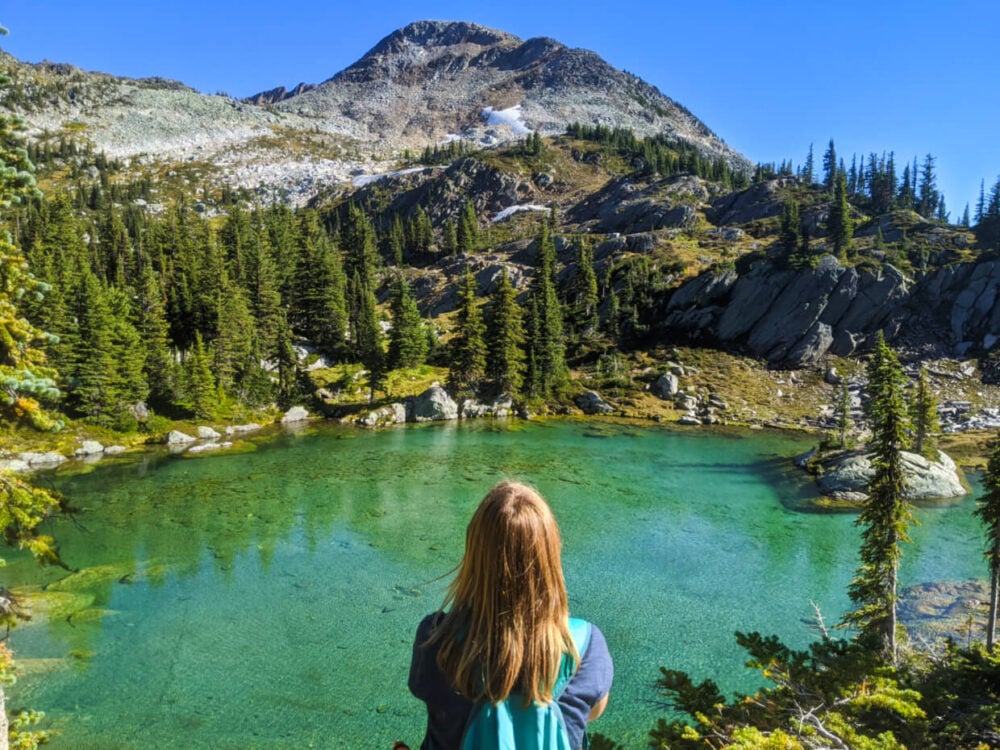
How to stay safe when backpacking
No-one sets out on a backpacking trip thinking that they’re going to get into a dangerous situation. But it does happen. And it could happen to you.
Thankfully, there are ways to reduce the probability of a dangerous situation while backpacking. It’s all about preparation. The more prepared you are, the safer you’ll be.
Being prepared means having the right experience, knowledge and equipment to prevent small issues (injuries, changes in weather, other unexpected events) from developing into dangerous situations.
Being prepared also means knowing what to do when dangerous situations do happen and how to survive. This includes getting lost.
Some of this preparation has already been covered in this guide, such as:
- Trip research – trail route, weather, wildlife, conditions, difficulty
- Appropriate clothing and shoes
- 10 Essentials
- Hiking gear and camping equipment
In this section, we’ll go beyond these topics to discuss what else you can do to keep yourself safe while backpacking.
Read More: How to Stay Safe in the Outdoors
Physical preparation
Backpacking is physically demanding. And that’s true no matter how light your pack is!
Making the effort to improve your fitness and flexibility will really help you feel less sore and exhausted while backpacking. It’ll also lessen your chances of getting injured on the trail.
The ideal time to start conditioning training is around eight weeks before your first backpacking trip. If you don’t have that much notice, even a few weeks of preparation is better than nothing.
Practice makes perfect! If you don’t already regularly hike, start going on walks and hikes at least three times a week.
- Keep to a brisk speed to get your heart rate up
- Gradually extend the length and difficulty of your hikes over time
- Be sure to bring a backpack and add more weight to it on every hike
- Wear the same shoes/boots as you will on your backpacking trip
If your first backpacking trip is going to take place at a significantly higher elevation than your home, you may also want to practice hiking at elevation too. Thinner air pressure means that it is harder to breathe.
Improving your strength and balance can help immeasurably on the trail. REI has an awesome guide with strength training videos demonstrating eight different exercises, from jump squats to single leg deadlifts.
Alongside these more active pursuits, also take the time to try some breathing exercises . This, combined with cardio and strength training (as above) can help to improve your lung capacity, which will enable you to power up hills and mountains better! The Nest has some good tips here .
Stretching exercises can also help with lung capacity in addition to flexibility and balance. Many of the most effective stretches for hiking are actually yoga poses (so, bonus, if you happen to already practice yoga!)
Of course, it’s always a good idea to check in with your doctor before starting a new training program.
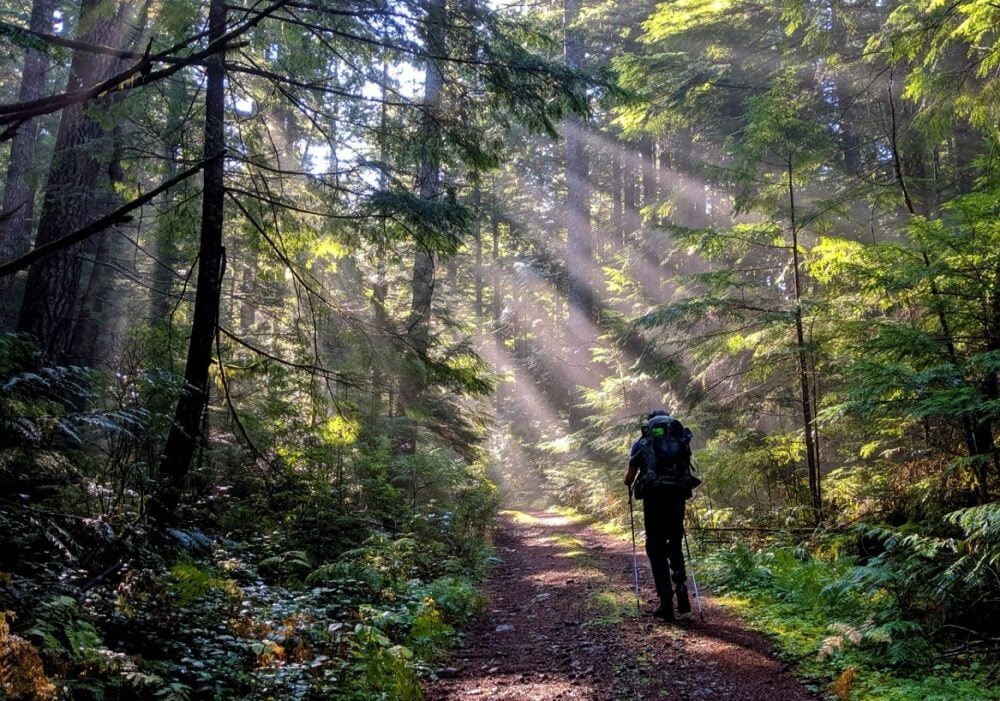
Share your trip plan
A trip plan is a typed or written outline of your intended backpacking trip. It should include the details of where you’re going and when you plan to be back.
Sharing your trip plan with a reliable friend or family member is one of the easiest yet most important things you can do to be safe while backpacking.
If you do not return on time, your friend or family member should alert the emergency services and provide details from the trip plan to help locate you.
Our trip plan includes:
- Purpose of our trip (e.g. multi-day hiking)
- Our destination and route to get there
- Additional group members (as appropriate)
- Departure date, approx time
- Intended return date, approx time
- The location of our parked vehicle plus make, model, colour, licence plate number
- Colour of our equipment – tent, jackets, backpacks
More advice available on creating a trip plan on AdventureSmart
Trail safety
The following quick tips will help you avoid most common causes of outdoor emergencies while on the hiking trail:
- Take time to observe your surroundings
- Stay on the trail
- Check progress (using your map/GPS) often
- Know what the daylight hours are
- If you arrived as a group, stay as a group
- Take extra care around waterfalls and rivers
- Stay hydrated and snack regularly
- Respect closures and restrictions
- Remain vigilant of changing conditions and weather
- Observe wildlife from a distance and do not approach
- Extinguish campfires (and keep them small)
- Keep pets under control
- Learn to keep your ego in check
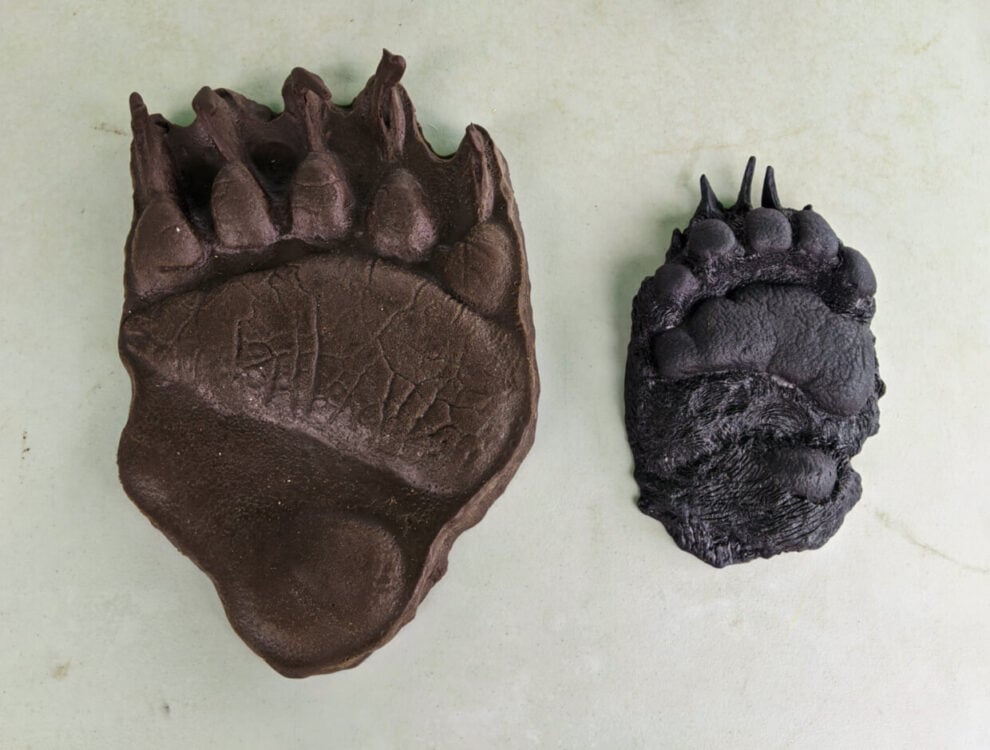
Wildlife encounters
It’s always exciting to spot wildlife in their native habitat. It does, however, come with risk and danger, to both animal and human. Be considerate to animals by:
- Not feeding wildlife. Not only can human food can make animals sick, but it may encourage them to keep looking for it
- Storing food properly (and packing ALL trash out with you) This helps to ensure that animals can’t get access to it. If they do, this counts as feeding them
- Observing from a distance. This allows animals to continue their natural behaviour and the chance to escape if they need to
Besides respecting the presence of animals, you should also know how to proactively avoid having a negative encounter with a predator.
Here in Western Canada, this includes grizzly bears, black bears, cougars and wolves. When backpacking, you should be sure to:
- Be alert at all times
- Travel in daylight hours
- Keep pets on a leash
- Cook away from camping areas
- Store food where animals can’t get it
- Travel as a group whenever possible
It is a good idea to bring bear spray as a precaution and carry it in an accessible place ( a holster can help).
Bear spray is an aerosol deterrent made with chili pepper oil, designed to be deployed at close range (less than 10m) towards the face of an aggressive or charging bear.
The vast majority of people never have to use it. But if you do, you’ll be glad you have it. Personally, we bring bear spray on every hike.
For more information about bear safety and what to do if you see a bear while backpacking, please read our dedicated guide here

What to do if things go wrong
Outdoor survival is a huge topic and it would be impossible to cover it in reasonable depth here – do check the additional resources section at the bottom of this guide for helpful links.
In a situation when no-one in your group is in immediate life threatening danger, think STOP :
- Stop – sit down, have a drink of water, eat a snack, concentrate on your breathing
- Think – evaluate the problem(s) and your equipment/supplies
- Observe – look carefully at surroundings, consider options
- Plan – form a strategy and implement it
The best strategy in most situations is to stay where you are. Continuing on after becoming lost or injured is risky as you may move even further away from the trail and rescuers. Make yourself visible and use signaling devices and your voice to alert rescuers to your location.
Don’t wait to ask for help
It is much better to call for help earlier than later . As night falls or weather conditions worsen, rescue comes more difficult. It can also become more complex if you get even more lost or injured.
The fastest way to request help is to call 911. If the signal is spotty, move to higher ground and away from dense forest cover. The 911 dispatch centre will connect you with local RCMP and Search and Rescue.
Search and Rescue is always free in British Columbia.
Many wilderness areas have no phone signal. That’s when satellite devices come in handy.
Always remain positive
Having a positive attitude is so important in any emergency or survival situation. If you’re able to keep a clear head and adapt to the situation, you are more likely to be able to overcome challenges and solve problems.
Backpackers who have done the appropriate preparation for their trip should have the necessary tools and knowledge to reduce the severity of most emergency situations.
If you’re lost, for example, your life should not in immediate danger since you have a shelter, extra food, extra layers etc.
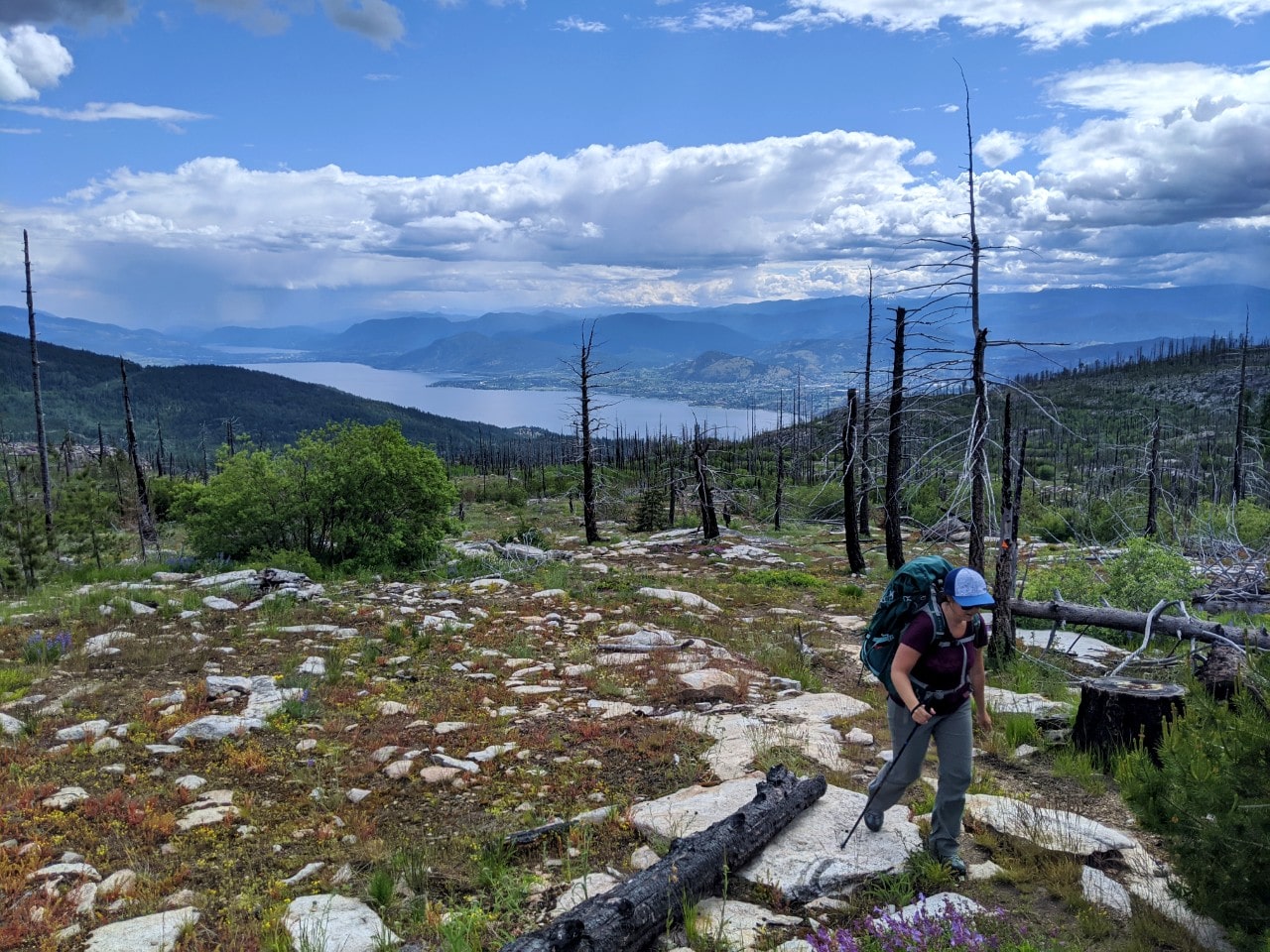
When backpacking, you should be prepared to Leave No Trace. But what does this mean? Leave No Trace is the closest thing to an ethics code for people exploring the great outdoors.
The idea is to minimise our impact on nature as much as possible, ensuring that the beautiful places we love remain pristine and also safe for wildlife.
Leave No Trace has seven core guidelines:
- Plan ahead and prepare – The more prepared you are, the more likely you are to have a fun, safe and low impact outdoor adventure
- Travel and camp on durable surfaces – Outdoor activities cause erosion, especially on delicate terrain such as alpine meadows
- Dispose of waste properly – Be sure to take ALL of your trash home with you, dig a cathole in places without outhouse facilities and wash dishes and yourself away from water sources
- Leave what you find. Take only memories and photos with you, to help preserve the natural environment
- Minimise campfire impacts . Keep campfires small and in existing fire rings. Use a stove for cooking food instead
- Respect wildlife . Observe animals from a distance only, store food properly and never fed wildlife
- Be considerate of others . As well as respecting wildlife, we should respect other people too. Give other people space, be considerate and let the sounds of nature rule
For more info, read my dedicated Leave No Trace post which features actionable ways to reduce your impact on nature when backpacking
Backpacking trip inspiration
25 of the Best Overnight Backpacking Trips in British Columbia
13 of the Best Shoulder Season Backpacking Trips in British Columbia
West Coast Trail Alternatives: Best Coastal BC Backpacking Trips
Backpacking trip guides
Eva Lake Trail, Mount Revelstoke National Park, BC
Valhalla Provincial Park, BC
Cape Scott Trail, BC
Della Falls Trail, Vancouver Island
Sunshine Coast Trail, BC
Monica Meadows, BC
Mount Assiniboine Provincial Park, BC
Lake O’Hara, Yoho National Park, BC
Twin Lakes, BC
Pinnacle Lake, BC
The Heather Trail, Manning Park
Grizzly Lake Trail, Yukon
Additional resources
AdventureSmart – Survive Outside
Backpacker.com – Backcountry Survival
Backpacker.com – The First 30 Seconds
Colorado Outdoors – Controlling Panic
I’d also recommend watching Search and Rescue: North Shore Rescue on the Knowledge Network (available for free online streaming).
The series provides an excellent insight into the work of search and rescue teams as well as sharing fundamental advice on outdoors safety.

FREE PRINTABLE HIKING PACKING CHECKLIST Sign up to our monthly newsletter and receive a completely free download of our printable, customisable packing checklist for multi-day hiking trips
Check out these recently published articles next
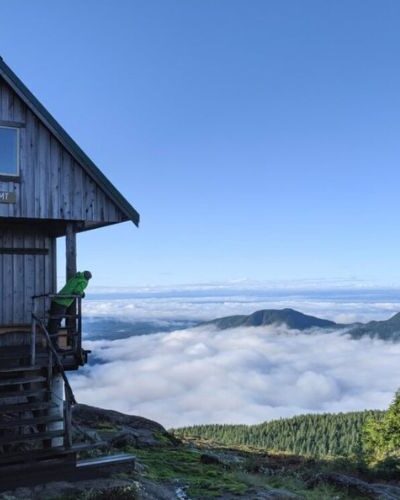
Sunshine Coast Trail Huts Guide: The Best Places to Stay
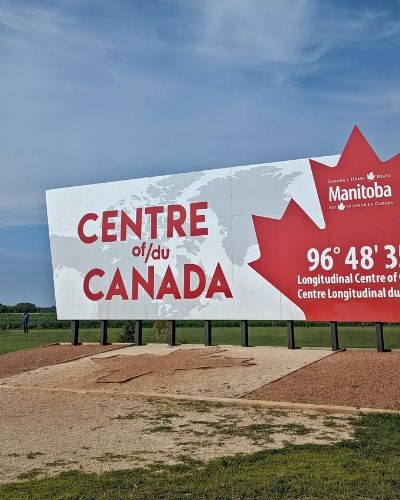
Toronto to Vancouver Road Trip: 24+ Great Places to Stop
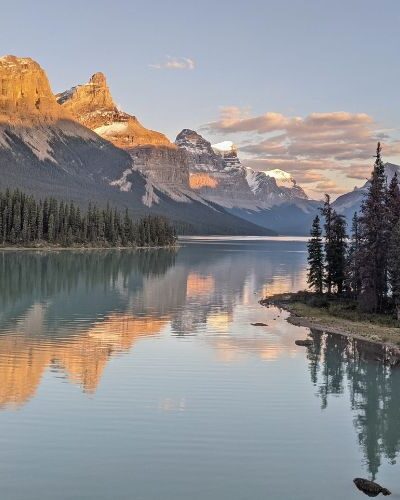
Spirit Island: Complete Guide with Map, Paddling Details, Boat Tour + More
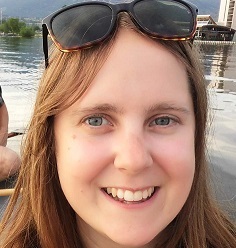
One half of the Canadian/British couple behind Off Track Travel, Gemma is happiest when hiking on the trail or planning the next big travel adventure. JR and Gemma are currently based in the beautiful Okanagan Valley, British Columbia, Canada
Create an account
Start your adventure today.
Already a member? Login
Canada Tours
Canada tours are the epitome of an active holiday, providing access to a vast wilderness that is ready and waiting to be explored. From Canadian Rockies tours that will take you through stunning mountain terrain to whale watching on Vancouver Island, planning a trip to Canada will have no shortage of incredible experiences. If you are after an unforgettable outdoor adventure tour in North America, consider one of the tours in Canada below.
Take the first step towards a private travel experience, customized just for you.
Filter Results
Displaying 15 of 97 tours
Canadian Rockies
Avalanche Skills Training 1 in the Canadian Rockies
Avalanche safety is a must-have tenet of backcountry adventure and a critical step in keeping yourself and your adventure partners safe in the wintertime and shoulder season. The Avalanche Skills Training 1 in the Canadian Rockies tour is a practical chance to learn the basics of avalanche safety in one of the most beautiful mountain environments in the world.
Backcountry Ski or Splitboard the Canadian Rockies
Have you ever spent some time on your skis in the backcountry and were wondering about some unanswered questions on terrain choices or avalanche danger? Stood at the top of a run and wondered how to get down or deal with steeper descents and up tracks? Then this is the place for you. The goal of this course of this backcountry skiing program is to take you to the next level. Combining the pure backcountry experience with the opportunity to solidify the basics and develop more sophisticated techniques makes this program appropriate for those looking for 2 days of guided skiing and splitboarding. This program is designed to refine your skillset allowing you the ability to venture deeper into the mountains.
Ice Climbing Basics in the Canadian Rockies
Ever looked at a frozen waterfall and thought, “I want to climb that?” You’re in the right place. The Ice Climbing Basics in the Canadian Rockies tour is a foundational introduction to the thrilling world of ice climbing. This course is suitable for total beginners and experienced climbers alike- anyone curious about strapping on the crampons and donning the axe is welcome!
Scrambling Skills and Safety
Most mountaineers start out as hikers on simple trails, progressively learning new skills to take on more advanced terrain. Scrambling is a fundamental skill in a hiker’s toolbelt, opening the door to more incredible scenery with the use of your own two hands. The Scrambling Skills and Safety tour is a chance to become familiar with scrambling with the guidance of a mountain expert.
Saguenay Fjord Family Sea Kayaking Tour
Do you want to live an extraordinary adventure with your teenagers?
We are here to help
Ask us a question!
We promise you will always have a real person to help plan your next vacation. A team member is always just a call or a click away.
Canadian Arctic
Aurora Borealis Tour
Embark on a bucket-list adventure in Northern Canada’s Yukon territory, where the Aurora Borealis ripples into the night sky, rendering its audience mesmerized as it ebbs and flows.
Saguenay Fjord Beginner Sea Kayaking Tour
During the two-day Saguenay Fjord Beginner Sea Kayaking Tour, you will experience the thrill of navigating the ancient glacial valley that is the majestic Saguenay Fjord. First, a guide will give you an interpretation of all the natural components you encounter. Then, you will explore the breathtaking cliffs and encounter exceptional wildlife such as seals, beluga whales, minke whales, falcons, seabirds and more. You will also enjoy gourmet meals by the campfire while marvelling at the spectacle offered by the stars.
Avalanche Skills Training 2 in the Canadian Rockies
Every backcountry adventurer needs a foundational knowledge of avalanche safety, and the Avalanche Skills Training 2 in the Canadian Rockies tour is designed to show you how to evaluate and respond to changing snow conditions in the backcountry.
Tour group discount
Travelling with a group of 8 or more?
Contact us to get a group discount and pick your next adventure at a lower price.
Backcountry Skiing at Rogers Pass
Rogers Pass offers some of the most exciting and challenging terrain in North America. From high glaciers to beautiful open bowls, tree skiing to small chutes, and steep adrenalin-fueled couloirs, the list is endless. Its proximity to the highway also gives you the flexibility to ski and snowboard a range of different aspects and altitudes, providing a multitude of options for the intermediate to expert skiers and snowboarders, irrespective of the weather.
Canadian Maritime
Bay of Fundy Sea Kayaking
Home to seals, whales, eagles, and porpoise, the Fundy Isles are a great place to discover the wild. Over three days, you will experience the highest tides in the world, while kayaking from private island to island. Let your friendly and experienced guides prepare local and fresh maritime meals for you over the campfire every night, before you retire to your tent each night, but not before star-gazing.
Wild Saguenay Fjord Sea Kayaking Tour
Come live an unforgettable experience on the three-day Wild Saguenay Fjord Sea Kayaking Tour that immerses you in the wildest part of the Fjord of Saguenay, the Saguenay-St. Lawrence Marine Park. In partnership with the Fjord-du-Saguenay National Park, you’ll enjoy an outdoor and gastronomic adventure, an incomparable experience.
Hiking the Wapta Icefields
If you want to access terrain enjoyed by few, the Hiking the Wapta Icefields tour is the ideal chance to escape your routine and seek the mountains. This hiking adventure in the Canadian Rockies departs from stunning Bow Lake to leave everyone else behind, travelling deep into the mountains.
Guided Ascent of Mount Willingdon
Reaching the peak of Mount Willingdon is an incredible experience, and it’s one you can do without mountaineering experience or any special skills! On the Guided Ascent of Mount Willingdon, you’ll be led up this incredible mountain with an experienced guide, reaching the 11,066-foot summit to discover unbelievable views over the surrounding Rockies.
Backpacking the Yoho Valley and Iceline Trail
You’re spoiled for choice when it comes to backpacking in the Canadian Rockies, but you just couldn’t miss an adventure in Yoho National Park. The Backpacking the Yoho Valley and Iceline Trail tour is an all-in experience in some of Canada’s best mountain scenery and a must-do for hikers in the Rockies.
Customize your trip
Your trip. Your way.
All private tours can be customized, so you can get the tour you've been dreaming about.
Basics of Winter Mountaineering
Mountaineering doesn’t have to be intimidating. Learn the fundamentals on the Basics of Winter Mountaineering course, an unforgettable adventure designed to teach you the skills you’ll need to conquer new mountains without previous experience required.
1-15 of 97 tours
Why book with 10 Adventures?
Make lifelong memories with the people you care about most. We specialize in custom & private active travel experiences.
Travel made easy.
Spend your time making memories, not planning them. Enjoy a stress-free vacation and leave the trip logistics to us.
You matter to us.
No bots here. A real human is always a click or a call away to ensure you get the adventure of your dreams.
Travel authentically.
Immerse yourself in the destination with highly-vetted, local tour operators who love to showcase where they live.
Canada General Information
Where to go in canada:.
When considering where to go in Canada, explore the majestic Canadian Rockies in Alberta and British Columbia . Experience the natural wonders of Banff and Jasper National Parks, or head west to Vancouver Island for rugged coastlines and ancient rainforests. Don't miss the scenic wonders of the Icefields Parkway!
What to do in Canada:
For an unforgettable adventure in Canada, indulge in outdoor activities like hiking, skiing, and kayaking in the Rockies. Explore the vibrant cities of Vancouver and Victoria, or embark on a scenic drive along the coast. Whether it's summer or winter, there's something for everyone in Canada.
When to go to Canada:
Timing your visit to Canada depends on your preferences. Summer is perfect for hiking and outdoor adventures, while winter offers unparalleled skiing opportunities. Spring and fall provide milder weather and fewer crowds, making it ideal for exploring cities and national parks alike.
Top 10 Adventures in Canada
- Road Bike Jasper to Banff : Embark on a scenic journey through the Canadian Rockies, pedaling past stunning mountain vistas and pristine lakes on this unforgettable road biking adventure along the iconic Icefields Parkway.
- Fjord of Saguenay Sea Kayaking Highlights Tour : Explore the breathtaking beauty of the Saguenay Fjord by kayak, immersing yourself in the rugged cliffs, pristine waters, and diverse wildlife of this stunning natural wonder.
- Aurora Borealis Tour : Witness the mesmerizing spectacle of the Northern Lights dancing across the night sky in the Yukon wilderness, providing a magical experience you'll never forget.
- 4-Day Vancouver Island Bike Tour : Cycle through the picturesque landscapes of Vancouver Island, discovering charming coastal towns, lush forests, and stunning beaches on this immersive biking excursion.
- Winter Rockies Self-Drive Tour : Navigate through the snow-covered landscapes of the Rockies at your own pace, marvelling at icy waterfalls, towering peaks, and serene winter wonderlands on this self-drive adventure.
- Backpacking the Rockwall Highline : Embark on a multi-day backpacking journey along the renowned Rockwall Trail in the Kootenays, traversing rugged mountain passes, alpine meadows, and awe-inspiring vistas in the heart of the Canadian Rockies.
- Chilkoot Trail Hike : Follow in the footsteps of gold rush prospectors on this historic hiking trail, crossing rugged mountain terrain and dense forests while immersing yourself in the rich history of the Klondike Gold Rush.
- 6-Day British Columbia Ski Tour : Shred powder on some of the best slopes in British Columbia, experiencing world-class skiing and snowboarding while surrounded by breathtaking mountain scenery and pristine wilderness.
- 12-Day Rockies Hiking and Camping Tour : Embark on an epic adventure through the Canadian Rockies, hiking along scenic trails, camping beneath starlit skies, and discovering the awe-inspiring beauty of this iconic mountain range.
- Newfoundland’s North Coast Self-Drive Tour : Journey along Newfoundland's rugged north coast by car, exploring charming coastal villages, dramatic cliffs, and pristine wilderness areas on this unforgettable self-drive adventure.
Travel tips for Canada Hiking Tours
Tipping in canada:.
Tipping is customary in Canada, typically ranging from 15% to 20% in restaurants and for services like taxis and hotel staff.
How widely is English spoken in Canada?
English is widely spoken throughout Canada, particularly in urban areas and tourist destinations. French is also an official language, primarily in Quebec.
How long should I go to Canada?
The ideal duration for visiting Canada depends on your interests and the regions you plan to explore. A week to 10 days is a common timeframe for a basic visit, but longer stays are recommended for a more in-depth experience.
Do I need a visa to travel to Canada?
It depends on your nationality. Many visitors require an Electronic Travel Authorization (eTA) or a visa to enter Canada. Check the requirements based on your citizenship before traveling.
What is the currency in Canada?
The currency in Canada is the Canadian Dollar (CAD).
Should I bring Canadian Dollars to Canada or use a credit card?
Both options are convenient. Credit cards are widely accepted, but it's always handy to have some Canadian Dollars for smaller purchases and places that may not accept cards.
Is Canada family-friendly?
Yes, Canada is very family-friendly, offering a wide range of activities and attractions suitable for all ages, from outdoor adventures to cultural experiences.
What’s the best way to get around Canada?
The best way to get around Canada depends on the regions you're visiting. In cities, public transportation is convenient, while for exploring remote areas, renting a car or taking domestic flights may be necessary.
Can I do a self-guided tour in Canada?
Yes, self-guided tours are popular in Canada, especially for outdoor activities like hiking and road trips. There are plenty of resources available to plan your own adventure.
Can I do guided tours in Canada?
Absolutely! Guided tours are available for various interests and regions in Canada, providing expert insights and a hassle-free experience for travelers.
What is the time zone in Canada?
Canada spans multiple time zones, from UTC-8 in the Pacific to UTC-3.5 in Newfoundland. The most common time zones are Eastern (UTC-5) and Pacific (UTC-8).
What are the accommodation types in Canada?
Accommodation options in Canada range from luxury hotels and resorts to budget-friendly hostels, cozy bed and breakfasts, rustic cabins, and campgrounds. There's something to suit every traveler's preference and budget.
What are the must-try Canadian foods?
Poutine, maple syrup, and Nanaimo bars are just a few iconic Canadian foods worth trying. Don't miss out on regional specialties like butter tarts in Ontario or smoked salmon in British Columbia.
Are there any cultural norms or etiquette I should be aware of in Canada?
Canadians value politeness and respect. It's customary to say "please" and "thank you" and to respect personal space. Queuing up in lines is also expected, and it's considered impolite to cut in line.
What are the emergency numbers in Canada?
In case of emergency, dial 911 for immediate assistance with police, fire, or medical emergencies.
What are some unique festivals or events in Canada?
Canada hosts a variety of unique festivals and events throughout the year. From the Calgary Stampede to the Montreal Jazz Festival and the Winterlude in Ottawa, there's always something exciting happening in Canada.
Are there any wildlife safety tips I should follow while exploring Canada?
While enjoying Canada's natural beauty, it's essential to respect wildlife and their habitats. Keep a safe distance from animals, never feed them, and properly store food to avoid attracting wildlife, particularly in national parks.
What outdoor gear should I pack for my trip to Canada?
Depending on the season and activities planned, essential outdoor gear may include waterproof clothing, sturdy hiking boots, sunscreen, insect repellent, and layers for varying temperatures.
How can I experience Indigenous culture in Canada?
Visitors can learn about Indigenous culture through various experiences, such as attending powwows, visiting Indigenous museums and cultural centers, participating in guided tours led by Indigenous guides, and supporting Indigenous artisans and businesses.
What are some scenic drives to explore in Canada?
Canada offers numerous scenic drives, including the Icefields Parkway in Alberta, the Cabot Trail in Nova Scotia, the Pacific Rim Highway in British Columbia, and the Trans-Canada Highway, providing breathtaking views of diverse landscapes.
What are the best places for stargazing in Canada?
Canada's vast wilderness areas offer excellent opportunities for stargazing. Popular spots include Jasper National Park in Alberta, Kejimkujik National Park in Nova Scotia, and the Dark Sky Preserve in Cypress Hills Interprovincial Park, Saskatchewan.
Tours in Canada by Province/Territory
Tours in canada by activity, other tours in north america by country, get travel inspiration and discounts.
Join our weekly travel newsletter

IMAGES
VIDEO
COMMENTS
I have heard some good things about the following trips in Northern BC, but I have not done them - maybe some can be additions to a future expanded edition of your list (i.e. 35 or 40 best): Wokkpash Valley-MacDonald Creek Loop Trail, Chilkoot Trail (BC & Alaska), Rainbow Range (Tweedsmuir PP), Mt Edziza Traverse.
The Best Overnight or First Time Backpacking Trips in BC. Without any further ado, here's our list of the best overnight or first time backpacking trips in British Columbia. San Josef Bay, Cape Scott Provincial Park. 5km return, 40m elevation gain $10/per person/per night camping fees, first come first serve
Duration: 2-4 Days. Distance: 31.7 km. Best Months: Mid-July to September. Elevation Gain: 660 meters. Fees and Reservations: None. There isn't a trail in the Sea to Sky that better encapsulates ...
Nootka Trail: 40km thru-hike, 4 to 6 days. The 35km Nootka Trail offers a wild coastal backpacking experience along on the western coast of Nootka Island, which sits just off the northwestern coast of Vancouver Island. Though a relatively short distance, the Nootka Trail packs a lot of variety into those kilometres.
This makes it an excellent destination for shoulder season backpacking trips in BC. The Lower Stein Valley trail is part of the epic 90km Stein Traverse, an alpine route that intersects Stein Valley Nlaka'pamux Heritage Park. The Lower Valley section comprises 30km of trail to Cottonwood Creek.
Backpack the Sunshine Coast Trail - one of the multi-day adventures in British Columbia. The Sunshine Coast Trail is a 180 km hut to hut hiking and backpacking trail that runs from Sarah Point to Saltery Bay where the ferries come in from Earl's Cove. The brainchild of Eagle Walz, the trail links sections of old growth forest.
Looking for the best backpacking in British Columbia? We've got you covered with the top trails, trips, hiking, backpacking, camping and more around British Columbia. ... 49.483708, -123.190377The Howe Sound Crest Trail (HSCT) is one of the most epic hiking trips one can do in the Vancouver area. The trail is entirely located within the Cypress ...
21.5 mi. 8,415 ft. 2 days. The Castle Towers Backpacking Trail is a difficult 21.5 mi out-and-back hiking route that climbs through the rugged landscape of Garibaldi Provincial Park on the way to summit Castle Towers. This trail is best completed in a multi-day format, with an overnight stay at the Helm Creek Campground.
Beginner backpacking trips - Elk Lakes Provincial Park, BC Elk Lakes Petain Falls hike. The Elk Lakes hike is a total snap - and super family-friendly if you access it via logging roads from Sparwood, BC. You'll have all of a 1 km hike to reach the campground and carts are even provided. You couldn't ask for an easier beginner ...
Welcome to the Backpacking Trips in BC Facebook Group. Our focus is on backpacking, backcountry camping, and overnight hiking in British Columbia. Self-propelled adventures only please. Feel to share photos and trips reports or ask for trail or gear recommendations. You may also use this group to find hiking partners.
Lake Helen Mackenzie can be also used as a jumping-off point for backpacking trips to Circlet Lake, Mount Albert Edward, Kwai Lakes and more. Location: Central Vancouver Island. Length: 8km loop. Average trip: 2 days. Fees: $10 per person, per night - BC Parks backcountry permit. When to go: July to mid-September.
Join us in the summer for guided camping and hiking tours, or in the winter for guided ski and snowboard trips on the Powder Highway and the Canadian Rockies. Our specialty is offering high quality tours for solo travelers and small groups. Nelson. Phone: 1-778-871-2539. Website.
Running between Skagway, Alaska and Bennet, British Columbia, the Chilkoot Trail is a challenging 53-kilometre backpacking route that traces paths taken by Gold Rush prospectors more than a century ago. Expect steep climbs, rapidly changing weather—including a chance of snow any time of year—and a remote wilderness setting.
90. Cycle and hike your way through British Columbia's rugged landscape on a 6.5-hour tour from Vancouver with lunch. Watch for signs of wildlife as you walk through Lynn Canyon, cross a scenic suspension bridge and explore a stunning temperate rainforest. Get sweeping views from the saddle while riding the Trans Canada Trail through Pitt ...
Build your ideal Canada trip. Call 1.406.541.2677. Start Planning My Trip. Explore Canada's breathtaking British Columbia on an Adventure Life hiking trip for 2024 and 2025. From the rugged shorelines of Vancouver Island to the majestic Rocky Mountains, this province is a hiker's paradise. In between, lush rainforests teeming with wildlife ...
25 of the Best Overnight Backpacking Trips in British Columbia. 13 of the Best Shoulder Season Backpacking Trips in British Columbia. West Coast Trail Alternatives: Best Coastal BC Backpacking Trips. Backpacking trip guides. Eva Lake Trail, Mount Revelstoke National Park, BC. Valhalla Provincial Park, BC. Cape Scott Trail, BC. Della Falls Trail ...
6-Day British Columbia Ski Tour: Shred powder on some of the best slopes in British Columbia, ... Yes, self-guided tours are popular in Canada, especially for outdoor activities like hiking and road trips. There are plenty of resources available to plan your own adventure.